
In the late 70s I started taking pictures of alternative rock bands in Vancouver. One of the best of the musicians was guitar player and composer Stephen Drake. You can see him in six, just a small fraction, of the many I took of him for about 15 years. My favourite is the first one I ever took of him, the one with the picket fence. The man in glasses in front is Gary Cramer perhaps the only singer that in my book could compete with Art Bergmann. The band was called Gary Cramer and the Works.
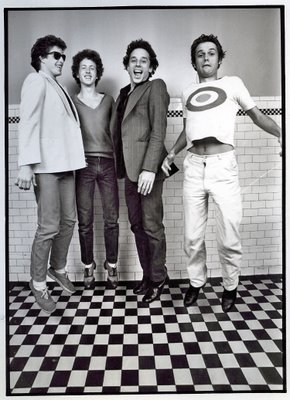
The Works was the three piece band behind him. In later bands Drake fronted the Odds and an alternate version of it called the Dawn Patrol. The last I heard he was a music producer/recording technician. If indeed Drake is doing that there is no doubt in my mind he is really good at it.
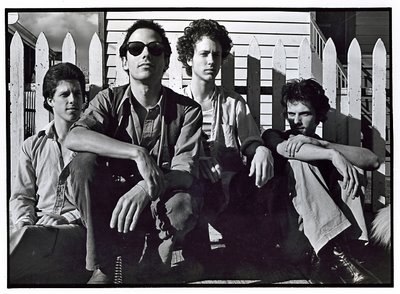
Sometime around 1990 Drake composed a song with the startling (it was autobiographical, he told me) title I Was F..... Wendy Under the Stars the Night That Elvis Died. I believe that to get a chance for airplay he kept the title in the lyrics but changed his tune to Wendy Under The Stars. The jumping shots of Gary Cramer and the Works I took in the men's bathroom of the old Pier BC which is now Canada Place.


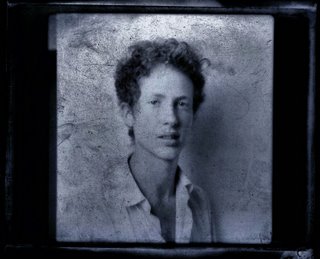
Bill Evans & Stephen Drake
How did I end up taking pictures of Stephen Drake not wearing anything in my studio? Vancouver Magazine art director, Chris Dahl had told me, "Photograph Drake wearing a see-through white gauze. He is a Scientologist and I want you to make him look like he is from outer space." I proposed to Drake that he wear the white stuff and he countered with, "I would rather wear nothing." I took him up on it and the picture, while not revealing anything, was the first ever full-frontal nude in Vancouver Magazine.
The Look Of Music
Friday, January 30, 2009
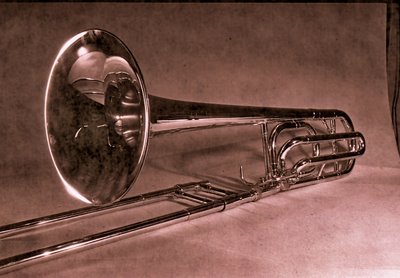
In 1980 Vancouver Museums and Planetarium Association had money. They organized a huge display of old and rare musical instruments from all over the world called The Look of Music. With some of that extra money they even published a beautiful catalogue book with the same name as the show.
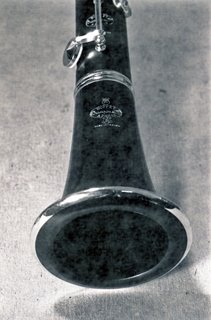
I have no idea what would have inspired Vancouver Magazine editor Malcolm Parry to dispatch me to take pictures of instruments, most of which I found at Ward Music. If you consider that I specialized in portraits and I had never done this sort of thing you can imagine my concern on failing. For one thing, wind instruments are very difficult to photograph as metal absorbs light and records quite dark. I don't remember in the end if my pictures were liked or not. Today, when I found them I decided to monkey with them by scanning the original b+w negatives and modifying them. I used such tricks as telling my scanner that the negatives were colour negatives or I scanned the negatives with a sheet of white paper on top. These resulted as negatives again which I reversed and added colour.
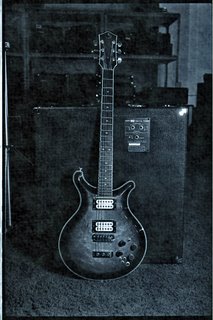
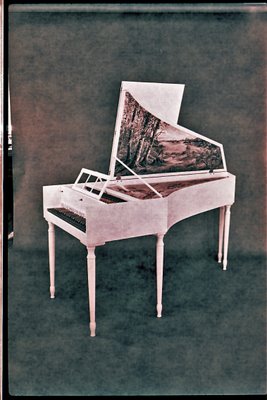
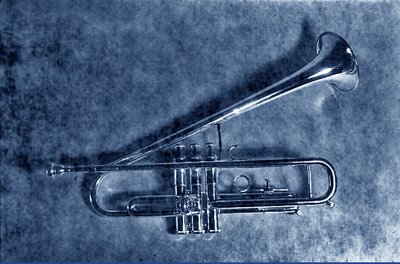
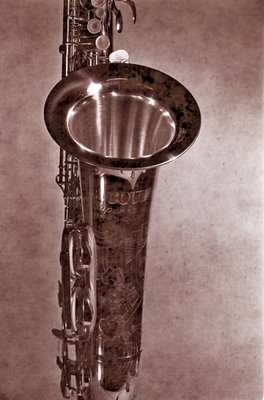


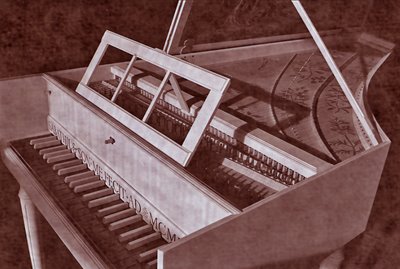
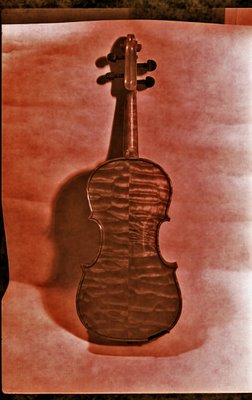
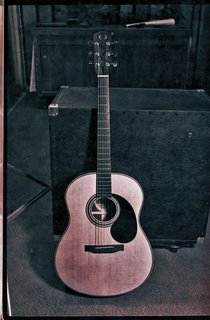
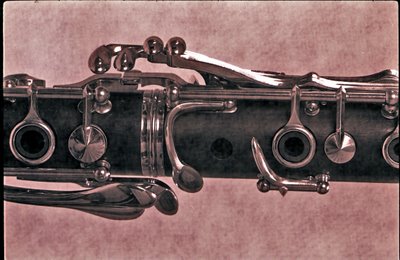

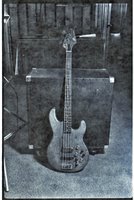

Hot Radio & Two Pauls (Grant and Luchkow)
Thursday, January 29, 2009
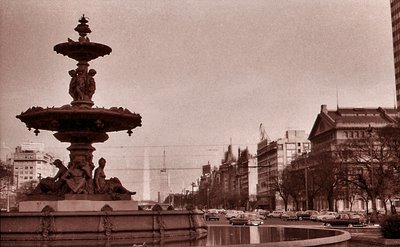
A week ago Pacific Baroque Orchestra violinist Paul Luchkow and CBC Radio's Paul Grant (seen here with CBC's Margaret Gallagher) discussed the sound differences between a modern violin and a baroque violin in my studio. My studio has beautiful acoustics. Luchkow showed the four different violin bows he used and the mechanics of beefing up an 18th century violin for the higher tensioned 19th and 20th century version that we commonly call a modern violin even if the modified (beefed up and reinforced on the inside) happened to be an 18th century Stradivarius, Guarnieri or Amati. The purpose of modifyng those violins was to able to make them louder so they could be heard in the larger concert venues of the 19th century. As Luchkow played Bach and Grant recorded it I closed my eyes and came to a realization obout the immutability of radio. Let me digress so I can explain.
In the latter years of the 40s I remember being in bed with a hot brick in my bed to keep me warm in a Buenos Aires winter. Before I would fade into sleep my parents always made sure the radio was on to LRA Radio del Estado. This was the Argentine equivalent of the CBC but obviously less independent and much more state controlled. It was with LRA that I first heard classical music coming from the Teatro Colón (on the right hand side of the picture above, left which I took in 1965). It was because of it that when my friends asked me what kind of music I liked I would always reply that I liked Colón music. LRA (now called Radio Nacional) also played tango and there were some children's programs. But my favourite program was the Argentine superhero/gaucho El Poncho Negro. The program ran in some other station earlier in the day.
I remember exactly what I was doing an early afternoon of June 2, 1953 (because of the London Buenos Aires difference in time the event must have happened in the morning). I was 10 years old. I was glued to our large radio set in our living room. I heard my mother say, "Alex wash your knees and hands and come for supper." I remember answering, "I cannot I am listening to the coronation of my queen."
Another program I enyoyed was Tarzán - Rey de La Jungla (Tarzan - King of the Jungle) which was sponsored by Toddy which was a chocolate powder product which we children spooned into our milk.
In 1956 I lost interest in radio in Mexico City when my grandmother bought a Zenith television set. It wasn't until the early 60s, when I developed an interest in jazz, that I started playing my radio again. I would tune my radio to short wave and listen to Willis Connover's Jazz Hour in the Voice of America.

Between 1956 and 1961 radio was almost as important as TV in my boarding school, St Edward's High School in Austin. TV had only three channels (or was it two?). The Brothers of the Holy Cross had strict parameters on how much TV we could watch. My favourite program was Have Gun Will Travel. At night when our dorm TV was turned off some of us had new-fangled transistor radios and we could sneak listening to them in bed. In my grade 10 Brother René Lenhard thought that education continued after lights out. He would play a variety of classical music (my favourite was the trombone part of Ravel's Bolero) but also some radio. Brother René must have liked Amos 'n' Andy as it was on every week. During the day the only good radio station was KTBC owned by Lyndon Johnson. This station, in a far more homgoenous time would play Elvis Presley, Conway Twitty and Pat Boone without classifying it.
I watched the Kennedy Nixon TV debate on the TV in our rec room pool hall. We all knew that Kennedy had won. He just looked better.
The Kennedy/Nixon TV debate was used by Marshall McLuhan to explain the concept of cool versus hot media. In our age of high definition TV it might just be obsolete. McLuhan called radio a hot medium. A hot medium is an inclusive medium. A hot medium requires minimal participation. A cool medium, TV, is exclusive and it requires high participation by the viewer how must fill in the blanks. McLuhan's explanation is misunderstood today. He explained that Kennedy's televised victory was due to the fact that he exuded an objective, disinterested, "cool", persona. Nixon was better suited for the hot medium of radio and those who listened to Nixon on the radio though he had won the debate. The misunderstanding comes from the fact that most of us state that TV is a passive activity. Perhaps if McLuhan were alive today he would change his tune.
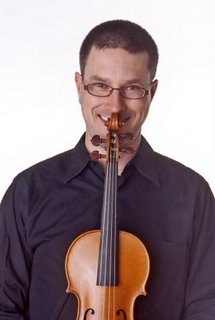
As I watched (but better still) listened to the two Pauls discuss baroque and modern violins, as I heard Paul Luchkow play slow and fast Bach first with one instrument and then with the other, I saw the light!
Even if radio is dumbed down - Even if radio hires announcers with lisps and bad voices - Even if radio hires announcers who are gramatically challenged - Even if radio has advertising (not that I will ever listen to anything but no-adverising CBC), radio cannot be changed. Radio coming down from a satellite, radio coming through a cable or telephone cable, radio listened to from a computer or downloaded as a podcast, radio, the old-fashioned way, from the airways, it is still radio.
Radio is radio. And radio, sometimes, can be wonderful.
A Constant Delight Of Language
Wednesday, January 28, 2009
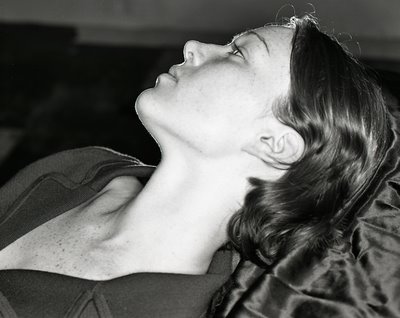
Tonight Rosemary and I went to see Somerset Maugham's The Constant Wife at the Stanley Industrial Alliance Stage on Granville. It was and Arts Club Theatre production deftly directed by Morris Panych (below, left) with lots of elegance and class. Both elegance and class are as endangered as marriage, newspapers and phones that are only phones. Even if the play had been a terrible play (which it certainly was not) the dialogue, the language, would have been more than adequate to keep me happy and interested.
The Constant Wife has language and more language. It has Maugham's witty, ascerbic, delightful language. It has a language that oozes with elegance. Elegance perhaps accompanied Audrey Hepburn into the grave. Or it could have been earlier with Noël Coward.
The bright, white almost sparse set (Ken MacDonald) was elegant and reassuring. I expected William Powell, Myrna Loy and Asta to enter any minute. There was a cocktail service on a table. The flower arrangements were changed frequently.
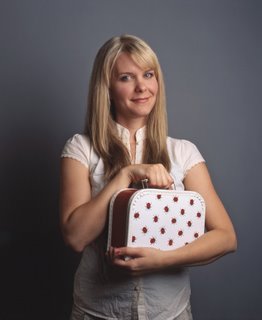
All the actors were superb in their parts. Bridget O'Sullivan playing Mrs. Culver reminded me of Agnes Moorhead. Celine Stubel (in colour here) was convincingly ditzy. And I know, because when she posed for me in my studio she was far from it.
It has been years since I last photographed Moya O'Connell (top, left). Age has made her even more beautiful. And age, too, seems to have deepened her voice for the better. I had to use my binoculars to make sure the lovely freckles were still there. Best of all I was wowed by the dresses, the hats and the stockings with the seam in the back. As a rude but wise Argentine once told me, "You start with your eyes where the seam begins, where ankle meets shoe, and then you follow it up until your imagination takes over."
The icing for my language cake was watching Nicole Underhay (playing Constance Middleton) dominate centre stage no matter where she was. And Nancy Bryant (costumes) did a superb job of cutting Underhay's dresses so they stroked her body in the right places. Underhay was pure sensual elegance. The men, Mark Burgess, Ted Cole and Mike Wasko were good but made superfluous by the women. They didn't have a chance. They were yesterday's cold mutton to today's lamb chops.

As I enjoyed Maugham's language I instantly remembered the last line from one of my favourite of his short stories from World Over - The Complete Short Stories of W. Somerset Maugham. The story is called Mayhew and it ends so wonderfully:
And yet to me his life was a success. The pattern is good and complete. He did what he wanted, and he died when his goal was in sight and never knew the bitterness of an end achieved.
There were lines like that throughout the play. I wonder how Maugham would have handled Twitter's 140 max characters?
Addendum
I ran into former Globe & Mail Arts reporter Christopher Dafoe. We talked on how we were enjoying the show. I pointed out that one of the reasons was Maugham's dialogue and use of language. Then I, depressingly added that language and its use are dying. Dafoe rebutted quickly, "Americans chose a president because of language." It is pleasant, sometimes to be proven wrong.
Tuesday, January 27, 2009

Hi Alex,
I went to the archives at the Library and looked through yearbooks.....I did not find a picture of the school bus....I guess that will just have to be a memory....
Regards to your family.
Bro. Edwin Reggio CSC
That bit of news a couple of days ago gave me only a small measure of melancholy as my memory of the Flxible Hilltopper is a strong one. I even remember, as if it were yesterday, the muffled roar of its engine. Watching it zoom by from the vantage point of my dormitory in the main building at St. Ed's High School was as thrilling as watching the McDonnell F-101 Voodoos from the nearby Bergstrom Air Force Base fly by overhead towards the Austin State Capitol on the horizon.
The Flxible Hilltopper was the bus that was attached to the nearby St Edward's University. We shared the campus. Alas we did not share that bus. It was called the Hilltopper because students of the university (the campus perched high on a hill overlooking what then seemed a far away and low skyline. The horizon was only broken by the white marble State Capitol)were called Hilltoppers as was the very good university basketball team. The university was too small at the time to fund a football team. The Hilltoppers rode in style to play away games or cross-town to friendly games with the University of Texas (they were obviously part of a more important league). But often the Hilltoppers would whip the UT team. What was the secret weapon? We at the high school had a theory. St. Edward's (both the high school and the university was run by the Congregation (brothers and priests) of the Holy Cross. There was an Indiana institution (University of Notre Dame) run by the same order. As we understood it, Notre Dame would send some of its best freshman players who were having scholastic problems our way. The Texas weather would improve their grades and while here they ran and dribbled circles around the lumbering Texas Longhorns.
The Hilltopper was painted middle blue with a prominent bright yellow strip on the side. The shape was pure aerodynamics of the Chrysler Airflow kind and the scoop on the back was music to my eyes. It was the most beautiful bus in the world. The bus was technically a Flxible Clipper which were manufactured in the early 50s.
In 1913, Hugo H. Young and Carl F. Dudte founded the Flexible Sidecar Co. in Loudonville, Ohio, to manufacture motorcycle sidecars with a flexible mounting to the motorcycle. The flexible mounting allowed the sidecar to lean on corners along with the motorcycle, and was based on a design patented by Young. In 1919, the company's name was changed to The Flxible Co. so that the name could be copyrighted and used as a trademark (although it continued to be pronounced "flexible").
In 1957 I finished the 8th grade in Nueva Rosita, Coahuila. The closest grade 9 school in English was St. Edward's High School, a Catholic boarding school in Austin, Texas. I was shipped there by my mother. During those four years I would return to Nueva Rosita, or Mexico City for Christmas and for the summer holidays.
Except for a couple of exceptions those trips involved rides in wonderful buses, long gone, but still in my memory. One of those trips involved aerodynamics of the airplane kind. It was an airplane so beautiful which just happened to be the first commercial jet I flew in. It was a De Havilland Comet 4C. The air intakes flush and part of the wing were as beautiful as that scoop on the Hilltopper.

In 1960 on my birthday for some reason we were in Mexico City. My mother sprung a pleasant surprise. In an envelope I found an American silver Dollar and a one-way ticket via Mexicana de Aviación to San Antonio. I asked my mother why the silver Dollar was there. My mother taught physics. She knew her stuff, "Alex when you are cruising in the Comet try and put the coin on its edge on your serving table. You will be surprised!" I was both surprised and thrilled. No piston-engine airliner of the time, even that gorgeous Lockheed Super Constellation, could stop vibrating in the air. The Comet 4C the first commercial jet in service was smooth. The coin remained on its edge without falling.
On other years going back and forth between my school and Nueva Rosita involved two buses and a car. Someone would drive me from Nueva Rosita to Piedras Negras. I would cross the bridge to Eagle Pass. Eagle Pass then looked much like many of the towns in American Westerns films. While the streets were paved the sidewalks were high from the ground and boardwalks. Many were covered by the overhand from the building. Sometimes I would go to the Eagle Pass Hotel for breakfast. On the way to breakfast I would pass the main room that had a fireplace with Winchester repeating rifles on the wall. One time a tall man with hat and cowboy boots emerged from the coffee shop and he noisily sauntered on the boardwalk. It was John Wayne who a (yes!) Flxible Clipper would await me. Thinking back I realize that each bus driver had a personal punch with which he marked my ticket. The Flxible would take me through towns that are now all romance to my ears. Then they were depressing as each brought me closer to school and away from my family. I was always a tad homesick. The bus stopped at Crystal City (the first city in the US to "go Mexican" voting in the first Mexican American city council around 1960. The Raza began in this lazy town with noisy swinging screen doors. The only language to be heard in the bus was Spanish. We then then stopped at such places as Carrizo Springs, and depending on the route of that day, Uvalde, Pearsall and Dilley before it arrived at the San Antonio bus station. There I switched to the imposing but not as beautiful Greyhound Scenicruiser.

From the lazy narrow one-lane highways between Eagle Pass to San Antonio I was suddenly on a four-lane divided highway all the way to Austin. Texans called it an expressway. These concrete expressways were part of the Dwight D. Eisenhower System of Interstate and Defense Highways. This is where the American love for driving began. I remember that both Bob Hope and Bing Crosby appeared in full-page Life Magazine ads extolling the virtue of driving on concrete!
Only once was I driven from Nueva Rosita to San Antonio. Jeanette Frazier, a widow who owned a large hacienda in Sabinas, Coahuila told my mother she was driving (in a big 1954 Buick Roadmaster) her daughter Cornelia to Uvalde to visit family. The town was close to San Antonio. Cornelia Frazier was a bit younger than I was. She was beautiful, spoiled, remote and didn't give me the time of day. We both sat in the back seat in complete silence all the way to Uvalde.
She was my first Estella. Today, Cornelia lives in Eagle Pass, not far from her mother who is her 90s.

When my grandmother would feel frustration she would often say, "Nadie es profeta en su tierra." Translated to English it is "No one is a prophet in their own land." The quotation is from Christ himself in Luke 4, 21-30. In Nazareth, the city of his childhood He told his listeners that He indeed was the Messiah. The crowd grew angry at His blasphemy.
The quotation is especially relevant in the Vancouver arts scene. Wonderful dancers and actors (as an example) languish here for years yet when they move they are often a success. It is then that our newspapers will suddenly run glowing articles on them. A recent example is Jason Wu who designed Michelle Obama's ball gown. It seems that Wu might have stopped in Vancouver for some time (the YVR men's room?). That was enough for the paper to claim pride in a Vancouverite who made it big elsewhere.
This happens everywhere else. Consider Argentine national poet, Leopoldo Lugones. His son Polo is credited with the invention (use of) the Argentine cattle prod as a torture instrument during Argentina's dirty war. Few in Argentina might know of Lugones's fame abroad and his influence in the invention of the Taser. But then even in infamy one cannot be a prophet in his own land. On the other hand while the policeman Lugones is somewhat known around the world for his contribution, Lugones father is all but unknown.
Shifting to an infamy of a smaller kind, on Saturday, after much nagging I finally had my granddaughters in the car on the way to my studio to take their portraits. It had been a while (sometime in late summer) when I had last had them in front of my camera. I get very little support either at home or at Rebecca and Lauren's home. Like churches, newspapers, I am becoming invisible. If I cannot be seen, what I do cannot be missed or appreciated.
In the back seat Rebecca was crying. "I hate to have my picture taken by you. The sessions last for three hours (not true!). Why can't you take pictures like my other grandpa. I don't even notice when he takes them." The only kind remark I could utter in defense of my kind of portraiture versus the snapshot technique was, "What I do is different." Once in the studio Rebecca made an agreement with Lauren that she would go first. While I was taking pictures of the more positive inclined Lauren, Rebecca was playing with her twin screen game box.
By the time Rebecca sat down to face my camera she apologized for her behaviour and settled in.

I have been compiling a mental list on how the world is rapidly changing in 2009. TVs and computer monitors will become one and the same (and the shift will not be in the middle but towards the laptop!). YouTube is second only to Goggle as a search engine. A younger generation finds a static image surrounded by copy (type) as not useful in comparison to an image that streams and moves with a soundtrack. The British writer Julian Barnes predicts that in our lifetime people will enter churches without knowing their purpose. My Rebecca has no concept of the newspaper.
I am adding my type of portraiture to the list of bygones. We are returning to the era of the Kodak Instamatic (not instant at all, and Kodak gone) of quick images made all the more cheaply by not having to think about the expense of using film.
My kind of portraiture where I use an artificial light source that mimics the Flemish painter's window is all but forgotten. Perhaps as forgotten as is Jan van Eyck except in very small circles of decaying highbrows.

I have been fascinated by whatever spark of soul that is in a live person's eyes that is not there when that person dies (many 19th century photographers parked their tripod and cameras in front of dying adults and children in a futile effort to capture that moment of life shifting into death). I have been interested in the stark portrait for a long time and recently I have found ways of paring it down even more. I eschew long lenses and now use a lens that gets me as close to my subject as possible so that I am in their face. There is no music in my studio and I don't tell my sitters (they are usually standing or sitting on the corner of a chair) to relax. I want to make them feel on edge. I want that visual confrontation.
Perhaps it is a fear of visual confrontation that is causing this shift towards the snapshot capture. It is far more comfortable to make friends with an anonymous person in one of the online social networks. We never have to look at them in the eye.
I may have been some 13 or more years ago in the month of May when I was pruning my laurel hedge. A car stopped and a man got out and with that gentle dolphin-like smile of his and a warm soft-spoken baritone voice said, "How are you Alex? I haven't seen you or many of my other friends since I became part of the film business."
I looked at him and instantly felt the vacuum of a friendship I had treasured. I felt the loss, the loss iteself, before me. What he did and friendship somehow were at odds. I have "lost" many others to the film business.
Peter Lando has first entered my life, gently at lunch some 27 years ago. He had arrived in tow of free-lance writer Kerry McPhedran. Both Lando and McPhedran were working on a job of museum display work for D (David) Jensen & Associates. Lando and I began to talk and he described his interest in anthropology and mentioned Native Canadians. I decided to push his button and told him that there was no way a long house and Native Canadian chant could ever compete with Gothic cathedrals and Bach cantatas. Our conversation grew heated and at one point Lando stopped and said, "You are joking, aren't you?" I think I may have answered, "Sort of."
That evening Lando called and said, "I had a good time today. We should meet at the Railway Club and converse. We could invite some friends who also like to converse." And that is how our long, every Thursdays at noon lunches began lasted for at least 20 years. The stresses of freelance work, city traffic and other factors finally killed the every Thursday meetings which we now hold perhaps once a year.
At some point Lando married a wonderful South African woman, Marianne Kaplan. She is an independent filmmaker with lots of gumption. She and Lando decided to get married in South Africa so that they could have an excuse to enter the country with a movie camera. Kaplan wanted to work on a documentary on apartheid.
About 9 years ago I ran into the Lando's (by then they had two boys) on a ferry to Saltspring that stopped at many islands. We had a chat and Kaplan looked at me and said, "Why have you disappeared? Why have you not called us? " I felt terrible but I coldy answered, "You guys are in the film business. You guys just disappeared."
On Friday I read in the Vancouver Sun that Peter Lando has received an Oscar nomination for his set design work in The Dark Night. I felt proud of the man and I wanted not only to wish him well but to hug him with warm congratulations. But I also felt a bitter loss that the price somehow for me was the fading away of a friendship.
I find it fitting that I looked through all my photo files and could not find one image of the man with the gentle dolphin-like smile.

There is nothing more fun than a pleasant night at the theatre. Sometimes it can be a tad out of the conventional. When you attend an opening performance of just about any show at the Arts Club Theatre, Granville Island Stage as we did last night (Skydive) you can expect John Hall to be playing the piano at the end of the stairs by the upstairs bar. Hall has been playing the piano for 40 years and I asked him if he was paid for doing so last night, "I sure hope so," he answered. Hall plays many jazz styles ("I don't do stride.") and seems to specialize in a mean boogie-woogie with a penchant for injecting snippets of Paul Desmond's Take Five into Christmas carols as he did back in December for It's A Wonderful Life. Hall plays low and his arms go wide. He nods his head to the side in enthusiasm and is a spitting image of Rowlf the resident pianist of the Muppet Show.
We sit down at our seats ready for a two or thre act play with a pleasant intermission. Not this time. We are repeatedly told there is no intermission. Hidden in the message is a, "And you better go to the bathroom now while you can."

The music before the curtain opens is usually a pleasant harbinger of things to come. Last night it was impossibly loud heavy metal. I commented to my wife, "I am going to go crazy if this persists." It did but in the context of the play it worked.
The show opened in a most unexpected way (I really recommend to skip the program as it reveals stuff that is better that your find out on your own. The dynamite revelation at the end of the show is best left as a surprise!)
I could write about those four dark dressed guys (they look like US Navy Seals ready to sink a battleship) whose performance with the aerial devices is sheer virtuosity and how a simple mistake on their part could be "crash and burn" for actors Bob Frazer and James Sanders. There is something there to the fact that Bob Frazier (playing younger brother Daniel) never touches ground while James Sanders (plays older brother Morgan) does eventually does. I will not reveal the how here. Again, I repeat, don't read the program.
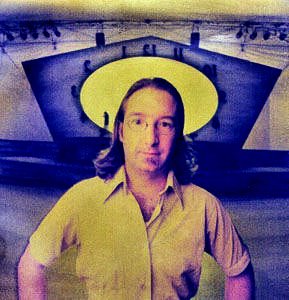
I wonder not about the dreams that these two brothers have and how they even manage to share one simultaneously. I wonder about playwright Kevin Kerr's dreams. I did so last night and came to the conclusion that Director Roy Surette, above, right, (with co-direction help from Stephen Drover) set designer Yvan Morissette, below left( Was he responsible for those tiny little guys that moved like real people?) and Kevin Kerr top, left, were kidnapped by aliens and while up there in the flying saucer they dreamt this wonderful play that in the end was lifted not by the special effects, but by my extreme jealousy of never having experienced the delight of having a brother. The warmth of the brother's relationship and of John Hall's exuberant piano playing before the performance made me smile. I went home content after another fine evening at the theatre, even if it was not in the least conventional or expected.
Skydive is a Realwheels production presented by the Arts Club Theatre Company and the PuSh International Performing Art Festival. Skydive ends February 7.

Hi Alex,
I went to the archives at the Library and looked through yearbooks.....I did not find a picture of the school bus....I guess that will just have to be a memory....
Regards to your family.
Bro. Edwin Reggio CSC
That bit of news a couple of days ago gave me only a small measure of melancholy as my memory of the Flxible Hilltopper is a strong one. I even remember, as if it were yesterday, the muffled roar of its engine. Watching it zoom by from the vantage point of my dormitory in the main building at St. Ed's High School was as thrilling as watching the McDonnell F-101 Voodoos from the nearby Bergstrom Air Force Base fly by overhead towards the Austin State Capitol on the horizon.
The Flxible Hilltopper was the bus that was attached to the nearby St Edward's University. We shared the campus. Alas we did not share that bus. It was called the Hilltopper because students of the university (the campus perched high on a hill overlooking what then seemed a far away and low skyline. The horizon was only broken by the white marble State Capitol)were called Hilltoppers as was the very good university basketball team. The university was too small at the time to fund a football team. The Hilltoppers rode in style to play away games or cross-town to friendly games with the University of Texas (they were obviously part of a more important league). But often the Hilltoppers would whip the UT team. What was the secret weapon? We at the high school had a theory. St. Edward's (both the high school and the university was run by the Congregation (brothers and priests) of the Holy Cross. There was an Indiana institution (University of Notre Dame) run by the same order. As we understood it, Notre Dame would send some of its best freshman players who were having scholastic problems our way. The Texas weather would improve their grades and while here they ran and dribbled circles around the lumbering Texas Longhorns.
The Hilltopper was painted middle blue with a prominent bright yellow strip on the side. The shape was pure aerodynamics of the Chrysler Airflow kind and the scoop on the back was music to my eyes. It was the most beautiful bus in the world. The bus was technically a Flxible Clipper which were manufactured in the early 50s.
In 1913, Hugo H. Young and Carl F. Dudte founded the Flexible Sidecar Co. in Loudonville, Ohio, to manufacture motorcycle sidecars with a flexible mounting to the motorcycle. The flexible mounting allowed the sidecar to lean on corners along with the motorcycle, and was based on a design patented by Young. In 1919, the company's name was changed to The Flxible Co. so that the name could be copyrighted and used as a trademark (although it continued to be pronounced "flexible").
In 1957 I finished the 8th grade in Nueva Rosita, Coahuila. The closest grade 9 school in English was St. Edward's High School, a Catholic boarding school in Austin, Texas. I was shipped there by my mother. During those four years I would return to Nueva Rosita, or Mexico City for Christmas and for the summer holidays.
Except for a couple of exceptions those trips involved rides in wonderful buses, long gone, but still in my memory. One of those trips involved aerodynamics of the airplane kind. It was an airplane so beautiful which just happened to be the first commercial jet I flew in. It was a De Havilland Comet 4C. The air intakes flush and part of the wing were as beautiful as that scoop on the Hilltopper.

In 1960 on my birthday for some reason we were in Mexico City. My mother sprung a pleasant surprise. In an envelope I found an American silver Dollar and a one-way ticket via Mexicana de Aviación to San Antonio. I asked my mother why the silver Dollar was there. My mother taught physics. She knew her stuff, "Alex when you are cruising in the Comet try and put the coin on its edge on your serving table. You will be surprised!" I was both surprised and thrilled. No piston-engine airliner of the time, even that gorgeous Lockheed Super Constellation, could stop vibrating in the air. The Comet 4C the first commercial jet in service was smooth. The coin remained on its edge without falling.
On other years going back and forth between my school and Nueva Rosita involved two buses and a car. Someone would drive me from Nueva Rosita to Piedras Negras. I would cross the bridge to Eagle Pass. Eagle Pass then looked much like many of the towns in American Westerns films. While the streets were paved the sidewalks were high from the ground and boardwalks. Many were covered by the overhand from the building. Sometimes I would go to the Eagle Pass Hotel for breakfast. On the way to breakfast I would pass the main room that had a fireplace with Winchester repeating rifles on the wall. One time a tall man with hat and cowboy boots emerged from the coffee shop and he noisily sauntered on the boardwalk. It was John Wayne who a (yes!) Flxible Clipper would await me. Thinking back I realize that each bus driver had a personal punch with which he marked my ticket. The Flxible would take me through towns that are now all romance to my ears. Then they were depressing as each brought me closer to school and away from my family. I was always a tad homesick. The bus stopped at Crystal City (the first city in the US to "go Mexican" voting in the first Mexican American city council around 1960. The Raza began in this lazy town with noisy swinging screen doors. The only language to be heard in the bus was Spanish. We then then stopped at such places as Carrizo Springs, and depending on the route of that day, Uvalde, Pearsall and Dilley before it arrived at the San Antonio bus station. There I switched to the imposing but not as beautiful Greyhound Scenicruiser.

From the lazy narrow one-lane highways between Eagle Pass to San Antonio I was suddenly on a four-lane divided highway all the way to Austin. Texans called it an expressway. These concrete expressways were part of the Dwight D. Eisenhower System of Interstate and Defense Highways. This is where the American love for driving began. I remember that both Bob Hope and Bing Crosby appeared in full-page Life Magazine ads extolling the virtue of driving on concrete!
Only once was I driven from Nueva Rosita to San Antonio. Jeanette Frazier, a widow who owned a large hacienda in Sabinas, Coahuila told my mother she was driving (in a big 1954 Buick Roadmaster) her daughter Cornelia to Uvalde to visit family. The town was close to San Antonio. Cornelia Frazier was a bit younger than I was. She was beautiful, spoiled, remote and didn't give me the time of day. We both sat in the back seat in complete silence all the way to Uvalde.
She was my first Estella. Today, Cornelia lives in Eagle Pass, not far from her mother who is her 90s.
Nadie Es Profeta En Su Tierra
Monday, January 26, 2009

When my grandmother would feel frustration she would often say, "Nadie es profeta en su tierra." Translated to English it is "No one is a prophet in their own land." The quotation is from Christ himself in Luke 4, 21-30. In Nazareth, the city of his childhood He told his listeners that He indeed was the Messiah. The crowd grew angry at His blasphemy.
The quotation is especially relevant in the Vancouver arts scene. Wonderful dancers and actors (as an example) languish here for years yet when they move they are often a success. It is then that our newspapers will suddenly run glowing articles on them. A recent example is Jason Wu who designed Michelle Obama's ball gown. It seems that Wu might have stopped in Vancouver for some time (the YVR men's room?). That was enough for the paper to claim pride in a Vancouverite who made it big elsewhere.
This happens everywhere else. Consider Argentine national poet, Leopoldo Lugones. His son Polo is credited with the invention (use of) the Argentine cattle prod as a torture instrument during Argentina's dirty war. Few in Argentina might know of Lugones's fame abroad and his influence in the invention of the Taser. But then even in infamy one cannot be a prophet in his own land. On the other hand while the policeman Lugones is somewhat known around the world for his contribution, Lugones father is all but unknown.
Shifting to an infamy of a smaller kind, on Saturday, after much nagging I finally had my granddaughters in the car on the way to my studio to take their portraits. It had been a while (sometime in late summer) when I had last had them in front of my camera. I get very little support either at home or at Rebecca and Lauren's home. Like churches, newspapers, I am becoming invisible. If I cannot be seen, what I do cannot be missed or appreciated.
In the back seat Rebecca was crying. "I hate to have my picture taken by you. The sessions last for three hours (not true!). Why can't you take pictures like my other grandpa. I don't even notice when he takes them." The only kind remark I could utter in defense of my kind of portraiture versus the snapshot technique was, "What I do is different." Once in the studio Rebecca made an agreement with Lauren that she would go first. While I was taking pictures of the more positive inclined Lauren, Rebecca was playing with her twin screen game box.
By the time Rebecca sat down to face my camera she apologized for her behaviour and settled in.

I have been compiling a mental list on how the world is rapidly changing in 2009. TVs and computer monitors will become one and the same (and the shift will not be in the middle but towards the laptop!). YouTube is second only to Goggle as a search engine. A younger generation finds a static image surrounded by copy (type) as not useful in comparison to an image that streams and moves with a soundtrack. The British writer Julian Barnes predicts that in our lifetime people will enter churches without knowing their purpose. My Rebecca has no concept of the newspaper.
I am adding my type of portraiture to the list of bygones. We are returning to the era of the Kodak Instamatic (not instant at all, and Kodak gone) of quick images made all the more cheaply by not having to think about the expense of using film.
My kind of portraiture where I use an artificial light source that mimics the Flemish painter's window is all but forgotten. Perhaps as forgotten as is Jan van Eyck except in very small circles of decaying highbrows.

I have been fascinated by whatever spark of soul that is in a live person's eyes that is not there when that person dies (many 19th century photographers parked their tripod and cameras in front of dying adults and children in a futile effort to capture that moment of life shifting into death). I have been interested in the stark portrait for a long time and recently I have found ways of paring it down even more. I eschew long lenses and now use a lens that gets me as close to my subject as possible so that I am in their face. There is no music in my studio and I don't tell my sitters (they are usually standing or sitting on the corner of a chair) to relax. I want to make them feel on edge. I want that visual confrontation.
Perhaps it is a fear of visual confrontation that is causing this shift towards the snapshot capture. It is far more comfortable to make friends with an anonymous person in one of the online social networks. We never have to look at them in the eye.
Peter Lando - The Dark Night & A Friendship Fades Away
Sunday, January 25, 2009
I may have been some 13 or more years ago in the month of May when I was pruning my laurel hedge. A car stopped and a man got out and with that gentle dolphin-like smile of his and a warm soft-spoken baritone voice said, "How are you Alex? I haven't seen you or many of my other friends since I became part of the film business."
I looked at him and instantly felt the vacuum of a friendship I had treasured. I felt the loss, the loss iteself, before me. What he did and friendship somehow were at odds. I have "lost" many others to the film business.
Peter Lando has first entered my life, gently at lunch some 27 years ago. He had arrived in tow of free-lance writer Kerry McPhedran. Both Lando and McPhedran were working on a job of museum display work for D (David) Jensen & Associates. Lando and I began to talk and he described his interest in anthropology and mentioned Native Canadians. I decided to push his button and told him that there was no way a long house and Native Canadian chant could ever compete with Gothic cathedrals and Bach cantatas. Our conversation grew heated and at one point Lando stopped and said, "You are joking, aren't you?" I think I may have answered, "Sort of."
That evening Lando called and said, "I had a good time today. We should meet at the Railway Club and converse. We could invite some friends who also like to converse." And that is how our long, every Thursdays at noon lunches began lasted for at least 20 years. The stresses of freelance work, city traffic and other factors finally killed the every Thursday meetings which we now hold perhaps once a year.
At some point Lando married a wonderful South African woman, Marianne Kaplan. She is an independent filmmaker with lots of gumption. She and Lando decided to get married in South Africa so that they could have an excuse to enter the country with a movie camera. Kaplan wanted to work on a documentary on apartheid.
About 9 years ago I ran into the Lando's (by then they had two boys) on a ferry to Saltspring that stopped at many islands. We had a chat and Kaplan looked at me and said, "Why have you disappeared? Why have you not called us? " I felt terrible but I coldy answered, "You guys are in the film business. You guys just disappeared."
On Friday I read in the Vancouver Sun that Peter Lando has received an Oscar nomination for his set design work in The Dark Night. I felt proud of the man and I wanted not only to wish him well but to hug him with warm congratulations. But I also felt a bitter loss that the price somehow for me was the fading away of a friendship.
I find it fitting that I looked through all my photo files and could not find one image of the man with the gentle dolphin-like smile.
Skydive & Rowlf Tickles The Ivories
Saturday, January 24, 2009

There is nothing more fun than a pleasant night at the theatre. Sometimes it can be a tad out of the conventional. When you attend an opening performance of just about any show at the Arts Club Theatre, Granville Island Stage as we did last night (Skydive) you can expect John Hall to be playing the piano at the end of the stairs by the upstairs bar. Hall has been playing the piano for 40 years and I asked him if he was paid for doing so last night, "I sure hope so," he answered. Hall plays many jazz styles ("I don't do stride.") and seems to specialize in a mean boogie-woogie with a penchant for injecting snippets of Paul Desmond's Take Five into Christmas carols as he did back in December for It's A Wonderful Life. Hall plays low and his arms go wide. He nods his head to the side in enthusiasm and is a spitting image of Rowlf the resident pianist of the Muppet Show.
We sit down at our seats ready for a two or thre act play with a pleasant intermission. Not this time. We are repeatedly told there is no intermission. Hidden in the message is a, "And you better go to the bathroom now while you can."

The music before the curtain opens is usually a pleasant harbinger of things to come. Last night it was impossibly loud heavy metal. I commented to my wife, "I am going to go crazy if this persists." It did but in the context of the play it worked.
The show opened in a most unexpected way (I really recommend to skip the program as it reveals stuff that is better that your find out on your own. The dynamite revelation at the end of the show is best left as a surprise!)
I could write about those four dark dressed guys (they look like US Navy Seals ready to sink a battleship) whose performance with the aerial devices is sheer virtuosity and how a simple mistake on their part could be "crash and burn" for actors Bob Frazer and James Sanders. There is something there to the fact that Bob Frazier (playing younger brother Daniel) never touches ground while James Sanders (plays older brother Morgan) does eventually does. I will not reveal the how here. Again, I repeat, don't read the program.

I wonder not about the dreams that these two brothers have and how they even manage to share one simultaneously. I wonder about playwright Kevin Kerr's dreams. I did so last night and came to the conclusion that Director Roy Surette, above, right, (with co-direction help from Stephen Drover) set designer Yvan Morissette, below left( Was he responsible for those tiny little guys that moved like real people?) and Kevin Kerr top, left, were kidnapped by aliens and while up there in the flying saucer they dreamt this wonderful play that in the end was lifted not by the special effects, but by my extreme jealousy of never having experienced the delight of having a brother. The warmth of the brother's relationship and of John Hall's exuberant piano playing before the performance made me smile. I went home content after another fine evening at the theatre, even if it was not in the least conventional or expected.
Skydive is a Realwheels production presented by the Arts Club Theatre Company and the PuSh International Performing Art Festival. Skydive ends February 7.
Friday, January 23, 2009
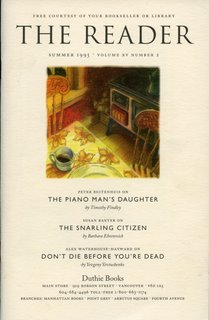
For 20 years beginning in 1980 Duthie Books and Celia Duthie (below, right) published in Vancouver little gem four times a year called The Reader. Celia Duthie would ask some of her friends and, some who were not, to review books for it. She had one command, a command she gave me once and which I always followed to the letter, "Try and pick a book you think you are going to like."
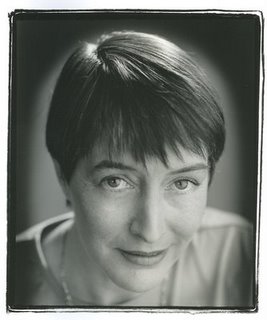
The whole idea for today's blog suddenly came to me last night when I read the following in Edmund Wilson's Memoirs of Hecate County, in the story The Millhollands And Their Damned Soul :
"We wondered whether you mightn't like to do a piece about the book in the Christmas number of the Booklover - I thought it would be right up your alley."
But this book by George Paine was the first that I ever refused to review for the Mullhollands. I realized that there would now be conditions imposed which I had not had to worry about in writing for the Booklover before, in the pre-Reader's Circle days: I should have to say the book was good and I should have to make it sound important.
I never had the problem the narrator of that story had. I reviewed quite a few books for Celia Duthie and I always picked books I was excited about. My editor at The Reader was Maja Grip, perhaps the most retentive editor I have ever met yet who gave me the freedom to have fun in my reviews. Even though the magazine is long gone most of the reviews live on in the archives of The National Library of Canada Electronic Collection. My favourite of all my reviews is a double one I made which included books by Mario Vargas Llosa and Paco Ignacio Taibo II. The original article did include the photo of Mario Vargas Llosa that is here. I am including a photograph that I took of Paco Ignacio Taibo II in the two-block long Chinatown in Mexico City.
The Reader XIV II - A Fish In The Water & Four Hands
--------------------------------------------------------------------------------
A Fish In The Water
By Mario Vargas Llosa
Translated by Helen Lane.
Farrar Straus Giroux, New York, 1994, 532 pp., $32.95
Four Hands
By Paco Ignacio Taibo II
Translated by Laura C. Dail.
St. Martin's Press, New York, 1994, 378 pp., $31.99
Reviewed by Alex Waterhouse-Hayward
If you were to approach a Hollywood producer with a screenplay based on a true story in which a Peruvian writer marries, as a minor, an older aunt; writes about it in a novel (Aunt Julia and the Scriptwriter), that is made into a movie (Tune in Tomorrow, 1990) with a screenplay by a highly regarded Ghanian author (William Boyd) who changes Lima to New Orleans, you would probably be ejected before you could proceed to add that the novelist subsequently dumps his aunt in Paris for his first cousin whom he marries. At the Mexico City premiere of a movie based on his novel Captain Pantoja and the Special Service, he punches and floors a Colombian Nobel Laureate (Gabriel García Márquez). He writes many acclaimed novels until as a restless 50-year-old he ponders the possibility of writing a comedy about an impresario who finds a childhood friend whom he thought was dead, alive, well and now a woman in a suite at the Savoy in London. The project is shelved in favour of running for President of Peru, a job he almost wins but for the fact that he eats a not-so-fresh ceviche in Piura and discounts, until too late, the competition from a Protestant Japanese/Peruvian agronomist dubbed the chinito (the little Chinaman).
In A Fish in the Water Vargas Llosa tells his story from his birth in Arequipa until age 22 while deftly alternating with a fascinating blow-by-blow account of his 1987 to 1990 unsuccessful run for the Peruvian presidency. "It is true that if the presidency of Peru had not been the most dangerous job in the world, I jokingly told a journalist, I would have never been a candidate." On a lonely Piura beach in August 1987 Vargas Llosa ponders the historic inability of Peru to improve itself: "That historical failure seemed to me to be a sort of sign of a country which, at some moment in its trajectory, fucked itself all up."
You wouldn't fare any better with the Hollywood producer if you were to return with a different story about a Mexican/Spanish writer (Paco Ignacio Taibo II) who writes acclaimed thrillers (An Easy Thing, Some Clouds, No Happy Ending), whose hero, Héctor Belascoarán Shayne, is a jazz-loving Chinese food enthusiast Mexican/Basque/ Irish private dick in Mexico City, who singlehandedly manages to escape from the clutches of corrupt judiciales, or the equally corrupt government officials of the Partido Revolucionario Institucional. Realizing you are not getting anywhere you explain that Taibo has now written something completely different. In Four Hands, Arthur Stanley Jefferson (known after 1920 as Stan Laurel) witnesses, while on a binge with 9 bottles of Bols gin, Pancho Villa's assassination in Parral, Chihuahua. Stoyan Vasilev, an 80-year-old veteran of the Spanish Civil War, is an unwitting pawn of a complicated anti-Sandinista plot. The plot is thwarted by Longoria, a twice-dead Spaniard buddy of Vasilev's who lives in the Sanatorio Español on Avenida Ejército Nacional in Mexico City. The interlacing plot includes Leon Trotsky, writing a thriller while working on his Stalin biography, and two journalists (who work together---hence the four hands), one Mexican and fat, Julio (who is obsessed with Laurel & Hardy films); the other Jewish American and thin, Greg, whose uncle was Houdini's psychiatrist).

To those readers who are used to the linear approach of most contemporary fiction, Four Hands can serve as an exciting initiation into the more complex but in the end very satisfying style of novels such as Llosa's Conversation in the Cathedral or to what may have been the first example of early hypertext, Julio Cortázar's Hopscotch. That might then lead to the discovery of such Latin American writers as Augusto Roa Bastos, Alejo Carpentier, or Gabriel García Márquez.
Somehow the Hollywood producer is convinced and the green light is given on the above projects so I decide to cash in on my own personal experiences. This reviewer used to play ping pong in the early 60s in the premises of the Club Mundet. This is an athletic club in Mexico City on Avenida Ejercito Nacional, not far from the Spanish Hospital, whose members were mostly exiled Spanish Republicans. One of the better challenges was playing against a very short spectacled kid called Paco. He was so short that I could barely see his eyes over the edge of the table. He was interested in my interest in photography and wanted me to accompany him to photograph the one block-long Chinatown on Dolores Street.
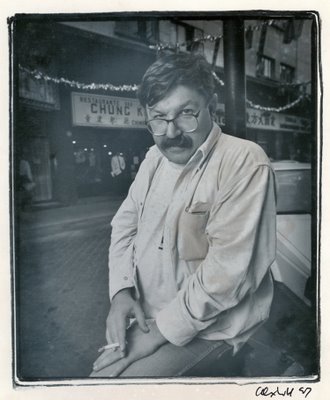
In 1990 I went to Lima to ask Mario Vargas Llosa why it is that he obsessively describes red geraniums growing in the front gardens of the houses in many of his Lima novels. His answer was, "Vasco da Gama returning from the Cape of Good Hope took the geranium back to Portugal. From there it was taken to Extremadura in Spain where it thrived in the desert environment. The Conquistadores Cortez and Pizarro brought the plant to America. In Lima nothing grows except the geranium. It should be our national flower as it thrives in adversity." Vargas Llosa was not feeling well (see photo) so he did not attend a campaign talk at the Peruvian/Japanese Society. The members did not believe the story of the not-so-fresh ceviche he had eaten in Piura. Because of his sickness his campaign manager decided to make some TV spots in Llosa's back garden in Barranco. It was soon transformed to look like a pueblo joven (slum). An appropriately "dirtied" little boy was brought in to pose.
As Belascoaran Shayne asks in Sueños de Frontera, 1990, in a Taibo tribute to Vargas Llosa, "A qué horas se jodió todo? When did it fuck itself all up?"
I know.
Alex Waterhouse-Hayward is a Vancouver photographer of Latin American Ancestry.
--------------------------------------------------------------------------------
{ Literascape } { What's New } { The Reader } { Fall 1994 }
Copyright © 1996 Duthie Books Ltd. All Rights Reserved. Literascape is a Trademark of Duthie Books, Ltd.
Here for a delightful review of a Patrick O'Brian novel by Marv Newland.
The Reader was a lovely little booklet/magazine printed in very good stock. It was a little jewel full of passionate reviews by reviewers who loved to read and picked books by their favourite authors or authors that wrote about something that they, too had a passion for. Witness the above loving review of O'Brian's novel by a nautically obsessed Marv Newland. This sort of review does not appear, to my knowledge, in any other Vancouver publication. At one time even the Vancouver Sun occasionally paralleled The Reader. I can remember the day day sometime in 1998 when I received a phone call from then Arts Editor, Max Wyman, who said, "Alex, I have here A History Of The Breast by Marilyn Yalom. I think this would be right up your alley. Would you want to review it?" Of course I was interested and, yes, I did review it. Max Wyman, Celia Duthie were are you?
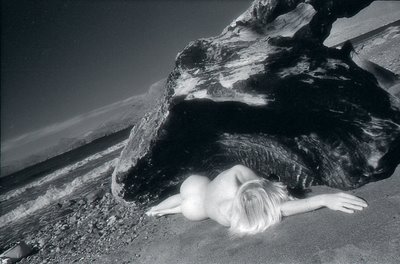
My wife Rosemary and I differ in how we look at our past. Rosemary spends long hours, as I sleep, wondering about the what ifs and the what if I had nots.
At our religion class at St. Ed's in Austin Texas we often liked to detour Brother Edwin Reggio CSC from the topic at hand. One of our favourites was to bait him with the concept of free will. "How is it possible for there to be free will if God is All Knowing?" we would ask him. To this day I have a deep respect for this adroit man who gave us logical answers and never got angry at us except twice.
Once it involved one of the biggest and heaviest of us, Byron Todd and the other and obstreperous Richard Mosby who was the only black student in our class. Both talked out of turn and pressed some buttons that we did not know Brother Edwin had. Brother Edwin, 5ft 1 was short and a tad compact. He picked Mosby on the one day and Todd on the other (some of my classmates swear it happened on one day and that he picked up each boy at the same time) with one arm and threw him across the room. We were impressed beyond imagination wondering what laws of physics our Brother Edwin had circumvented. It was only last year that Brother Edwin told me that his father and he and his brother had been Olympic ring champions.
My belief is that Brother Edwin welcomed our break-the-topic-of-the-day detour because he liked to debate and make us use our brains. He never gave us a hint at all the he knew what we were up to.
On the day that we asked him about free will he explained it like this:
Picture yourself up on the top of a mountain and you are looking down on both sides of a sharp hairpin curve. You see cars coming, very fast from either direction and you can also spot a large rock impeding one lane where the curve is at its sharpest. You can see that the cars will be involved in a head on collision. Perhaps you could stop the accident but you choose not to. That's free will.
I sleep most nights well while Rosemary agonizes on how we could have better invested our money or obtained better jobs or purchased a better house for less money (and bathrooms that don't leak) and in the right side of Granville instead of the wrong one. She wonders where we went wrong because our daughters didn't marry lawyers or engineers.
When we first came to Vancouver in 1975 I was not able to get work as a photogrpaher. I was simply not as good as I thought I was. I needed experience and knowledge of what was available in town. I ended up washing and renting cars for Tilden-Rent-A-Car (In Canada It's Tilden. May I help you?) The shift work meant that I only had one complete weekend per month. There were days when the girls were in school and Rosemary was at work.
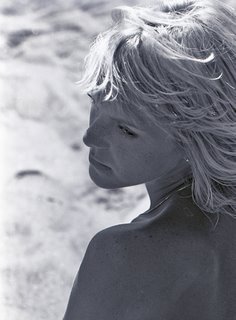
I would go to lie on the sand of Wreck Beach in the Summer. I ran into people who had ways of only working in spring and fall so that they could travel in winter and lie on the beach in the summer. I was jealous even though many worked as waiters or waitresses and in the construction business. These were jobs I was not keen to look for. To this day Rosemary insists I was a lazy bum for many years and that I should have found better things to do with those spare days. "You could have looked for a better job."
What is the connection of the above with the pictures of a blonde school teacher called Marley W that I met at Wreck Beach? It was at Wreck Beach that I honed my photography of the human form. It was my on the spot live art class. I tried new films, odd films, odd film/developer combinations and in a couple of the pictures here I perfected my understanding of Kodak b+w Infrared Film and Kodak Special Order SO-115 which had incredibly fine grain and a shift towards the red that rendered skin luminous. I practiced using extreme wide-angles and learned how much distortion was acceptable. I learned to photograph the human form as pure form. It was later, as a I developed more confidence, that I started shifting towards the portrait.

Marley W. was a lovely and patient young woman who posed for me for long hours without protest and made me feel that what I was doing was the right thing and that it would better me. And best of all she taught me to appreciate poise and elegance.
No if I could only convince Rosemary. She would sleep nights.
St Edward's High School

Yesterday my wife lept from the 20th to the 21st century in bed. She watched Obama's swearing in ceremony as streaming video on the NY Times with her Toshiba laptop. I did my best to read the hard copy version of the paper while juggling a large mug of strong tea. Last night after she returned from a computer class she immediately turned on the TV to see what Michelle Obama's ball gown looked like.
I had this curious feeling that I did not want to listen to Obama make yet one more speech. Yet there I was as he made one, so out of context, between dances while his wife behind him was waving acknowledgment to friends. It seems this guy could even give a speech while barbecuing.
Ubiquity of Obama's face and voice has done me in. I gave it some thought last night and came to the realization that Abraham Lincoln and even Ulysses Simpson Grant seem to be so much more real in the b+w images that I have in my mind of them as oposed to all those streaming colour videos of Barack Obama. Ubiquity is making him invisible to me. Or at the very least when he turns his face to one side while speaking (which projects seriousness and the weight of pathos) I feel I am watching a Bugs Bunny cartoon. This is not in any way a feeling of disrespect. Much to the contrary I hold much hope that finally we (as in the world) have an intellectual in the White House who is known for reading books. As my Canadian Tire flyers point out, "Now, that's different!"

My reaction to streaming colour is perhaps the effect of that special moment in my life when I was around 8 when I went to an American library in Buenos Aires and gazed on my first photographs of American Civil War soldiers taken by Matthew Brady, Timothy O'Sullivan and Alexander Gardner. The sharp and stark b+w images made the man I stared at look like their pictures had been taken days or hours before. Then it sank in (my first intimation of my own mortality) that these men had been dead for almost a century. These were the first photographs of real people that I really ever seen. That impression has remained to this day.
Photographer Alexander Gardner took that glass plate portrait of Lincoln with the crack (ominous in retrospect) on February 5, 1865 less than two months before his assassination. The portrait of Grant, it has a startling modern look to it, I found, with no credit and undated in my book My Brother's Face - Portraits of the Civil War In Photographs, Diaries and Letters by Charles Phillips and Alan Axelrod, Chronicle Books San Francisco, 1993.
What is even more startling and endearing, too, is what Grant wrote of his meeting with Lee to accept his formal surrender at Appomattox:
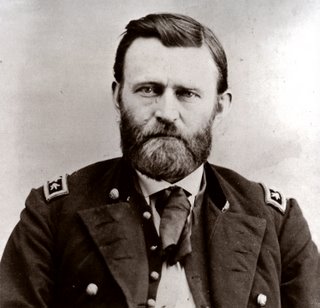
When I went into the house I found General Lee. We greeted each other, and after shaking hands took our seats. I had my staff with me, a good portion of whom were in the room during the whole of the interview.
What General Lee's feelings were I do not know. As he was a man of much dignity, with an impassible face...his feelings... were entirely concealed from my observation; but my own feelings...were sad and depressed. I felt like anything rather than rejoicing at the downfall of a foe who had fought so long and valiantly and had suffered so much...
General Lee was dressed in full uniform which was entirely new, and was wearing a sword of considerable value...In my rough traveling suit...I must have contrasted very strangely with a man so handsomely dressed, six feet high and of faultless form...
We soon fell into conversation about old army times... Our conversation grew so pleasant that I almost forgot the object of our meeting.
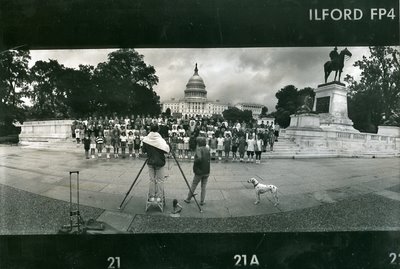
In one of my many visits to Washington DC, this one in 1965 I happened on a scene where a photographer was using an old Cirkut 5x7 inch swivel lens panoramic camera to photograph a group. The photographer, James E Ivey had inherited the exclusive franchise and the camera from his father. At the time Ivey was there almost every day of the week with his Dalmation. On the far right the man on the equestrian statue is Ullyses S. Grant. It was June and when I walked up the capitol steps I could smell the fragrance coming from a huge Magnolia grandiflora or Southern Magnolia and I wondered if Abraham Lincoln had ever stopped to smell them, too.
The picture above of Lincoln's inauguration was taken March 4, 1861 by Montgomery C. Meigs. This year I plan to find, buy and read The Personal Memoirs of Ulysses S. Grant.

In 2003 Rosemary, Rebecca and I visited Washington DC. I insisted in having lunch at the venerable Willard Hotel. I explained to Rosemary and Rebecca that the term lobying came from the early meetings in the 1850s, 60s and 70s of politicians with people who wanted to "buy" favours. Surely Abraham Lincoln and others must have walked the corridors of the hotel. I thought I could feel their presence. Some day Rebecca will return to DC. If she happens to lunch at the Willard Hotel I hope she still remembers and runs into my presence.

We walked to the Capitol and I showed Rebecca and Rosemary the large Magnolia grandiflora on one side of the capitol steps. I told her that Abraham Lincoln might have stopped to smell the very large and beautiful white flowers. At the National Gallery Rebecca spotted this painting ( Giant Magnolias on a Blue Velvet Cloth, Martin Johnson Heade) and said, "Look that could even be Abraham Licoln's magnolia."
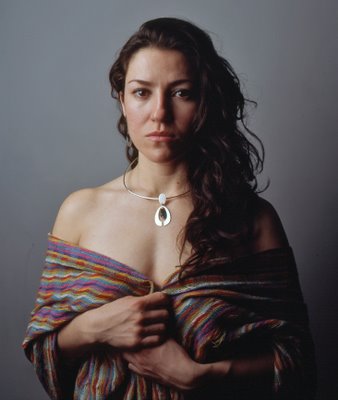
Bernal Díaz del Castillo in his Historia Verdadera de la Conquista de La Nueva España mentions the appearance of La Malinche (as Mexicans call her and Doña Marina as Spaniards reverently call her) in April of 1519, when she was among twenty slave women given by the Chontal Maya of Potonchan in the present-day state of Tabasco to the triumphant Spaniards. According to Díaz, Malinche was the noble first-born child of the lord of Paynala near present-day Coatzacoalcos, then a "frontier" region between the Aztec Empire and the Maya states of the Yucatán Peninsula. In her youth, her father died and her mother remarried and bore a son. Now an inconvenient stepchild, the girl was sold or given to Maya slave-traders from Xicalango, a commercial town further south and east along the coast. Díaz claims Malinche's family faked her death by telling the townspeople that a recently deceased child of a slave was Malinche. At some point, she was given or sold again, and was taken to Potonchan, where she was ultimately given to the Spaniards.
Since la Malinche was fairly attractive Cortés gave her to noble born friend Alonzo Hernando Puertocarrero. When Cortés sent Puetocarrero as an emissary to the court of Holy Roman Emperor Charles V (but also Charles I King of Spain) he kept her for himself. Her knowledge of the lingua franca of the region Nahua meant that when she learned Spanish she was able to translate for Cortés.
To this day Mexicans have a complex relationship with a woman they feel sold them out to the Spaniards. There are some, who to the contrary, think that as she was also the lover to Cortés, she was able to somewhat soften the effect of the Spanish conquest. The language and customs survived to the present day. The Aztecs noted such a closeness between La Malinche and Cortés that they called them both by the epithet Malintzin. In the Mexico of today a malinchista is a person who prefers the foreign to the domestic. La Malinche fades into history in 1529 and or 1551, both dates given as her possible death.

When my mother returned from a trip to Mexico in 1953 (we moved to Mexico from Argentina the next year) she told me how there was not a single statue, memorial, street, park named after Hernán Cortés. The exception to the rule was a hotel of somewhat ill-repute (refurbished in the 70s) near the centre of the city called el Hotel Cortés.
The father of one of my favourite Mexican/Spanish writers, Paco Ignacio Taibo II, Paco Ignacio Taibo I tells a story in a lovely CD I bought many years ago in Mexico about leaving Franco's Spain in 1958. Paco senior, like his son, were both of severe leftist tendencies. There was no room for the father and his family in dictatorial Spain. They sailed for Mexico. In a delightful bit of magic realism, Paco Ignacio Taibo I decides to invite a little old lady who also lived forgotten in Spain. The little old lady is Doña Marina as Spaniards reverently call La Malinche. Doña Marina reluctantly accepts but becomes very depressed saying that Mexicans will reject her when they arrive at the port city of Veracruz. She locks herself in her cabin. Taibo I brings her jugo de piña (pineapple juice), plátanos dominicos (finger bananas) and feeds her tacos de guajolote (turkey tacos). When the ship finally arrives and Doña Marina finally emerges from her cabin she is young again and beautifully dressed in white. Taibo I tells Doña Marina, "Let's disembark and enter your land again. Both of us are from conquered people (Taibo’s leftists leanings defeated by Franco), we have that to share." Doña Marina replies, "I will try again."
When they disembark and go through customs they feel the presence of a middle-aged man dressed in a suit of armor. Taibo I and Doña Marina note it is Hernán Cortés. They are surprised to find him alive and in Veracruz since those who know, know hir remains are walled in the church of San Juan de Diós in Mexico city a few meters from the old Cortés Hotel. Cortés looks at the pair and says, "Otro gachupín nos cae encima, “or "Another Spaniard is upon us to bring us tragedy." Cortés turns around and loudly shuffles away in his rusty armor.
To this day I often look at Mexicans in the street, Mexicans in buses, Mexicans at the beach, Mexicans everywhere, and in spite of North Americans from the US and Canada asserting that Mexicans are a happy "fiesta" people I can always discern a look of sadness and tragedy in their faces. I saw this when I was attempting to photograph the lovely Ms Hernandez as an Aztec princess. The more I look at my picture the more I think that the Aztec princess in question is none other than Doña Marina. She is a Doña Marina that, alas, Paco Ignacio Taibo cannot feed turkey tacos, pineapple juice and finger bananas. Taibo I died in Mexico, his adopted land, last year.
It might interest some that the Spanish name for a finger bananas, dominicos also means a Dominican priest or monk. There are those who further add that the size of the little bananas reflects a specific organ of the hated priests who were in charge of the Spanish Inquisition. Furthermore in most Spanish speaking countries a bakery delicacy there is a largish spherical concoction almost identical to a donut hole. Mexicans and Spaniards like to dunk them in thick hot chocolate. Depending on whom you ask this delightful pastry is either called suspiros de monja (a nun's sigh) or bolas de monje (a monk's testicles). And the inhabitants of the Dominican Republic, distancing themselves from any connections to priests and finger bananas, call themselves dominicanos.

In 1952 my mother made an exploratory trip to Mexico from Buenos Aires. While there she had her hand read by a curandera woman who told her that her attraction to two volcanoes of the Valley of Mexico, Popocatepetl and Ixtacciuatl would make her return. When we did move in 1954 my mother pointed out the two snow-capped mountains from the window of our PanAm plane. I had never seen real snow except in films. Our airplane had crossed the Andes from Buenos Aires to Chile at night on our way to Mexico. Because our airplane was an early version of the Douglas DC-6B it wasn't properly pressurised and we were given oxygen masks when we crossed the darkened peaks of the Andes.
From then on whenever I could spot the two volcanoes I would gaze in wonder. By the late 60s Mexico City's pollution hid them except for a few days of the year. There are many Aztec legends about the two peaks. Ixtacciuatl was the sleeping maiden who waited in vain for her Aztec warrior to return from war. When he returned he found her asleep. The story ends much like an opera. In Spanish Ixtacciuatl is called la mujer durmiente or the sleeping woman.
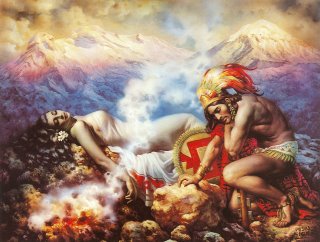
It is surprising how the most obvious of things isn't always so. It hit me some years ago (not that long!) that nostalgia could only be felt outside of the place you had the feeling for. Thus after a year of living in Venice (if that were ever to happen to me) I would be suffering from Vancouver nostalgia and I would be out scouring the canals in the lookout for an attractive Canadian woman I could photograph undraped under an umbrella.
Since I met the lovely Ms Hernandez who hails from León, Guanajuato some months ago I have been taking her pictures and imposing (she is most willing) my nostalgia on her. Today's which is a photograph I took yesterday, is my nostalgia for those Mexican volcanoes of my youth.
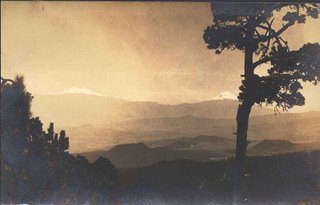
In the late 60s I spent 2 months working as un unpaid assistant to the then most famous Mexican commercial photographer, Arno Brehme. His father Hugo Brehme had become famous in the 20s taking pictures of artistic Mexico which were subsequently converted into postcards. One of his most famous is of the two volcanoes.
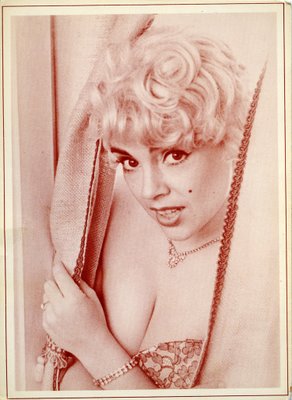
I got to like the big-hipped cat-faced women of the photographs shown as lures out in the front of the Fourteenth Street burlesque show; the announcements of moving picture palaces bejeweled with plastic-bright lights; the little music shops that sold big brass-band instruments and Slavic and Balkan records and had radios tht blared into the street; the Field's restaurant window with the white-aproned girl, blue-livid under a mercury tube, making pancakes on a hot metal slab; the young women of the pavements, some of them pretty, Italian or Jewish or whatever, stopping to look in at the displays in the windows of the dress and the shoe shops.
The Princess with the Golden Hair - Memoirs of Hecate County - Edmund Wilson

It was sometime in 1981 that I was approached by the very lovely but also very politically active Anne Gordon. She had helped organize the Vancouver strippers into an organization called VEDA (Vancouver Exotic Dancers Association).They organized stripathons for charity. What Gordon wanted from me was a series of risque postcards that were going to be sold at something called The Best Of Burlesque 1981 that was going to be held at the Marr Hotel on Powell Street.
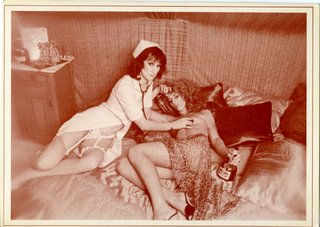
I took 9 different situations and I am posting 7 of them here as the other two would be completely defaced of any value if I were to hide "stuff." By today's standards these postcards are tame indeed but perhaps some of you might discern just a bit of charm.
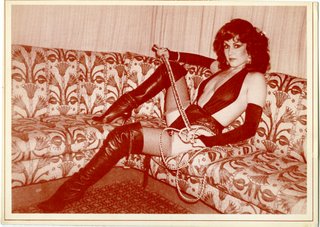
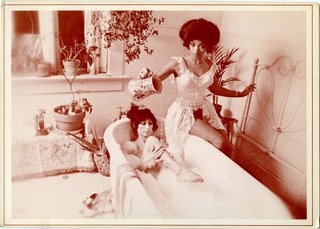
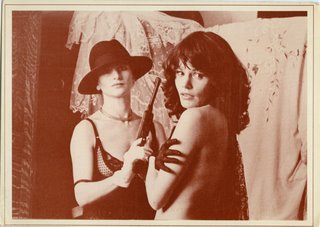
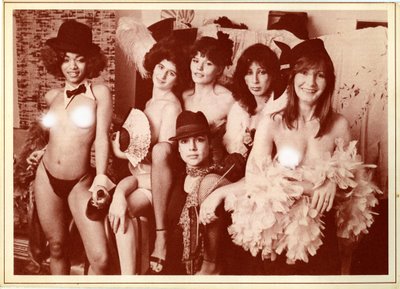

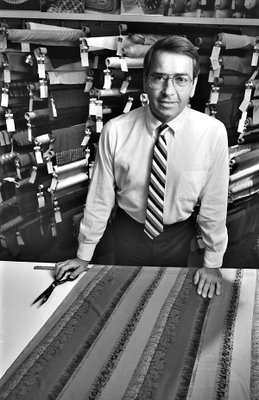
When I first met my future wife Rosemary Healey in 1967 I had no idea what Canadians were like. I knew nothing about Canada. Rosemary was blonde, she spoke English, she wore miniskirts, see seemed to be a gringa like most of the other gringas we Latinos were inexorably attracted to. I first noticed something was amiss when she told me about her grade 12 students she had brought from Canada in an exchange program. It sounded odd. "Do you mean the 12th grade I asked her?" Then she told me of a man she said was the prime minister of Canada. His name was Pierre Trudeau. And she added, "he is sexy." I had no idea who the man was. In Mexico at the time my only connection with Canada was the pine (not a pine at all, and how was I to know it was a Douglas Fir?) we bought at Christmas time. A label said, "Importado del Canadá."
Rosemary was born in New Dublin, Ontario. I asked her if she had totem poles in her town. She told me she had never seen one in her whole life and in fact the first one she ever saw we saw together in Chapultepec Park, not far from where we lived in Mexico City. I was further confused when I asked her about Indians. Like those poles she told me she had never seen one in her life. It was from Rosemary that I first heard of a Canadian sport called skating on the Rideau Canal. She told me the best place for it was in Ottawa which was not far from the university she had attended called Laval in a place called Quebec. To top it all she pronounced that last place like the que in que será, será... It was about that time that I had read a National Geographic article on Canada that stated that Ottawa was the coldest major capital in the world and even colder than Moscow.
The big shocker was the day she told me, "Alex, you need a new pant." In hindsight I should have known better. In Spanish pants can be pantalones but we usually prefer pantalón. In fact if you go to the Real Academia Dictionary of the Spanish Language (RAE) you cannot find words like pantalones or tijeras. While you would say both in Spanish and in English to pass me the scissors, in fact that word does not exist. The instrument in Spanish only exists as a singularity. Perhaps Rosemary was speaking in some ancient but correct English were a pant was pant, nothing more and nothing less even if that pant had two cuffs.
It became patently obvious that I was in love with a strange foreigner. The Americans to the North of Mexico had a good word for such non-Americans. They called them aliens.
But things began to normalize when I noticed that Rosemary had an affinity for that troubling singularity, the scissor. The scissor would always disappear no matter where I hid it. The scissor was always important in my family as both my mother and grandmother had many pairs of them. The sight of my mother and grandmother with a scissor in hand was a comforting memory of my past that was now refreshed by Rosemary. We bought some black plastic material and a bra. I used the bra to make a pattern and with Rosemary's scissor I cut the plastic into the appropriate wedges. Soon Rosemary had skillfully sewed a bikini to die for.
In fact Rosemary was not only interested in the scissor to the point of obsession (that has not changed 40 years later) but she also broke every watch I ever gave her just like my mother broke all the watches my father and then I gave her. My mother had an immense collection of earrings. These were of the solitary and single kind. She lost an earring as fast as she bought them. Ditto Rosemary. How was it possible that Rosemary had inherited all these traits even though she was not related? To this day I cannot forget the smile that was always on my grandmother's face when she held the scissor you see here. This scissor is in my desk and Rosemary knows it is verboten for her to even touch it. We have purchased countless of that tool for years. They disappear, they become unsharpened or she loses the screw that holds the single unit together one with the other. I have bought Rosemary and English, German, Italian and even a Swedish scissor. Alas the are all gone. I keep my grandmother's Italian Monarch out of her reach in my desk centre drawer. I use it to cut my negatives or to cut my transparencies in strips.

Rosemary has other uses for the instrument. She insists on using it to prune and cut her perennials even though I bought her an expensive pair of Swiss Felco secateurs which like scissors can also be a secateur (but not in my Word Spellcheck). She manicures the grass around our rose bed and the other flower beds with the scissor.
When she comes in from the garden with her presently favourite orange scissor, Rosemary uses it to cut the French bread for cheese fondue, or cut my homemade pizza, the roasted chicken and the meat when I make shis-kabobs. Her scissor is truly home & garden.
I have received countless manicure sets from Rosemary, through the years but within months I cannot find the tweezers or the little scissor. The only one she has not ever touched is one I have for cutting my nose hair. Because Rosemary uses the little manicure scissor for othet tasks when I attempt to cut thread with it after sewing on a button (Rosemary does not sew buttons) it is so unsharp it won't work. I have to scurry around the house to find a unit that will.
Rosemary is the official Christmas and birthday wrapper. At Christmas time she likes to wrap on the floor and I can hear how she snips the paper and if I spy on her she has a contented smile on her face. Rosemary and the scissor are one.
Besides my mother, my grandmother and my Rosemary the only other person I ever met who had an affinity for the instrument was Alderman (not yet our mayor) Philip Owen. He had a store under the Hudson's Bay Company parkade bridge on Seymour Street in 1986 when I photographed him for the first time. His store was a high-end establishment that sold Vogue patterns and the best cloth for the Cohens, the Belzburgs and the patrician elite of our city.
Here was a man who just like my wife, felt good with a scissor.
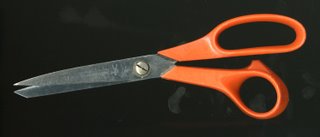
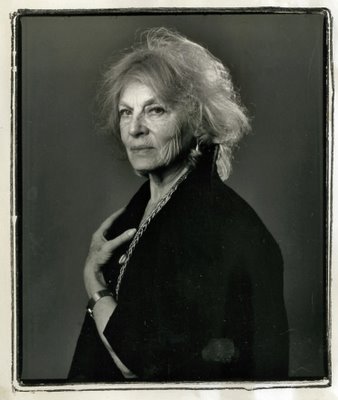
Last night I felt the presence of a ghost dressed in black.
Last night at the Vancouver Playhouse Rosemary and I saw the opening performance of Stephen Sachs's adaptation of August Strindberg's play Miss Julie subtitled Freedom Summer.
My knowledge of Swedish playwrights was exactly zero in August 1992 when I photographed Swedish actress Viveca Lindfors. Before I took her to my studio for her photograph I was present at an interview she gave John Lekich at the Hotel Vancouver. Lindfors kept talking, with much excitement, of her love and admiration for someone called Strindberg. I kept thinking what my gradmother would have remarked, "Un ilustre desconocido que ni en su tierra conocen." or an illustrious unknown perhaps not even known in his own land. Lindfors told Lekich of her project to appear in a play in Sweden called In Search of Strindberg. She did just before her death in 1995.
In my studio Lindfors faced my camera and instructed me, "I am proud of my face. I am proud of every crease, fold and wrinkle. Make sure you capture them as they are." This I did. To break the ice (perhaps to make myself feel more comfortable in the face of this almost haughty, but sweet woman who stared at me with her striking eyes) I mentioned that I had loved her as the Queen of Spain in her 1948 film opposite Errol Flynn, The Adventures of Don Juan. She countered with, "Everybody tells me that but if you really want to know what I am most proud of it is the double bill I played off-Broadway, in 1956. I played Miss Julie in Miss Julie and Miss Y in The Stronger. Both are Strindberg plays." That evening when I went home I investigated August Strindberg.
The cast of last night's production by The Playhouse Theatre Company was superb. The black chauffeur John was played by Kevin Hanchard, the black cook (her accent was so authentically impenetrable that I could not understand anything she said for the first five minutes!) was Raven Dauda and Caroline Cave was Miss Julie.
It is difficult to see a play that transplants a young woman from an aristocratic family in Sweden to a small town in Mississippi on July 4, 1964 without the theatre goer of a certain age (me!) not bringing some baggage from the past. I kept comparing Hanchard's John to a fictitious (but very real to me) performance of John by Sidney Poitier. By the end of the show I concluded that Hanchard played it as well as Poitier would have. And hands down, Hanchard has a better singing voice!
But it was Caroline Cave as Miss Julie (in a performance reminiscent of another one that Lee Remick never gave), in the killer red dress and the killer cleavage, that kept demanding my attention. One moment she was forcing John to kiss her shoe and the next she was pleading for him to dance with her.
Last night I was the only one there with a ghost behind my shoulder, who with a smile on her face and approving of Cave's performance, whispered in my ear, "This is real Strindberg."
Miss Julie - Freedom Summer continues until January 31.

Beautiful derives from the Latin bellus. The Spanish equivalent is bello (masculine) or bella (feminine). But I much prefer the other Spanish word for beautiful which is hermoso (masculine) and hermosa (feminine). This word also derives from the Latin but it is much more inclusive in its definition. The Latin word is formosus which means beautiful in form. This Spanish word hermoso is appropriate for the tone of today's blog on beauty.
In the early 80s and much of the rest of that decade I haunted the Vancouver strip clubs with my friends. Three friends in particular were Les Wiseman, John Lekich and Ian Bateson. While watching beautiful women disrobing we often discussed the topic of beauty. We threw back and forth the members of our personal lists of the most beautiful women. These lists were two fold. One was about the most beautiful women on earth and the other the most beautiful women in Vancouver. In the former list, and in particular John Lekich's list we always commented with glee that his women were mostly all dead.

We put a lot of time into our Vancouver Top 10. These days I wonder where young men (or youngish as was the case for us in the 80s) discuss this topic which has to be a universal one. Do they do it in bars? Or do they do it on line? Is it as much fun? And most of all I wonder if in our more secluded environment if anybody bothers to make Vancouver Top 10 lists. Do these young men discuss the celebrities that grace the "People" magazines?
A trend for fitness in Vancouver started in the 80s and one of the first to do it was Terpsichore. They combined an early version of aerobics with jazz dance. Many of the jazz dancers that I photographed at the CBC variety shows worked out at Terpsichore. Terpsichore had two principals. The woman on the right in the picture above is Betty Kovacs and the other, Christine Chipperfield. Chipperfield was a permanent fixture of both Les Wiseman's and my list. We thought she was beautiful and had just about the best body we have ever seen. I do remember being quite tongue-tied when this pair faced my camera.

As the 80s progressed Terpsichore closed its doors and I lost sight of Chipperfield. But in March 1995 I was dispatched by the Georgia Straight to photograph Chipperfield who was in a long and troubling lawsuit with ICBC over the debilitating effects of a spinal injury that she had suffered in a rear end collision. Some said that Chipperfield had become obsessed and the lawsuit had become all her life. I don't know for sure how her situation was resolved since I have not seen her since our photo session.
I noticed in my photographs that she had become a much more handsome woman who eschewed makeup. Her skin was perfect and her body much the same as it had been when I had first photographed her. She was obviously older. There was presence about her that I could not nail down. I could only wonder how an erstwhile perfectly fit woman would cope with physical disability.
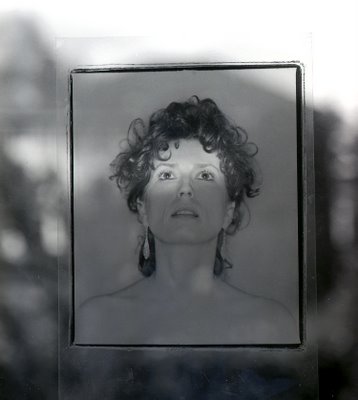
When I look at the picture with her business partner I suddenly realize that I did not give that older woman a second glance. If Les Wiseman, John Lekich and Ian Bateson and I would meet on whatever remaining strip bar we have in Vancouver I would probably now put Betty Kovacs on my list. She is truly wonderful in elegance and beauty of form. As we would say in Spanish, "¡Es hermosa!"
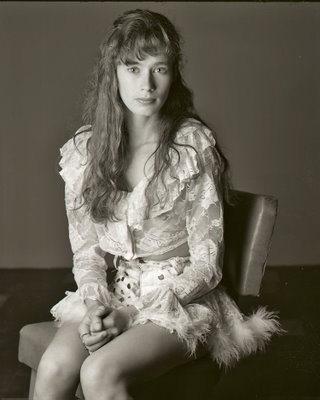
In wit of omission you say, "I could say this and make you laugh but I am not." It is a low form of wit as you really never have to come through with the goods. In this blog in the last few days I have been using its poor cousin which I call, wit of visual omission. Early on, three years ago I decided that in this blog I would not accept comments. I did not want to be at the mercy of some freak who would not let go. Another decision I made was that I would never (I may have broken this once or twice) post a nude. I would resort to that horrible sounding contemporary term, the implied nude!
If 2009 is settling into a post feminist (in the strict meaning of the word) period I would hope that I would not need much justification to show you pictures of some of the beautiful women that have faced my camera in the last 37 years. I am sure that some of my blog fans might concur.
When Shannon Keir faced my camera in the outfit you see here I had seen her without it at the Number 5. She had a beautiful body, and a face that made her seem younger than 20 even though she was in her mid 20s. When I took these pictures, perhaps some 18 years ago I was young enough that my goal was to get her down to nothing in as little time as possible. Those are the pictures that in my visual wit of omission I cannot show you. These will have to do.
If Shannon showed up in my studio now I would probably reverse the order of my session. I would have her take her clothes off immediately, take some pictures and then go for the serious clothed ones.
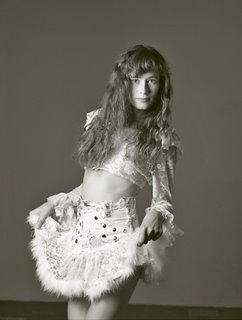
The film that I used here is a Kodak film that faced what Kodak called discontinuance. It was called Technical Pan. It was a very sharp film (the sharpest film ever made anywhere by anybody!) that had an extended range into the red spectrum to better capture the detail of a solar flare. That is what Tech Pan was designed for. It was a scientific film. But then even though we photographers are usually not scientific we like to break the rules. Any film with red sensitivity will make skin seem whiter and cleaner. It will make it glow almost like Kodak infra red film (also in discontinuance, alas!).
Looking at Shannon in Technical Pan I see some a bit of the look of some of the Flemish portraits that I have so admired in galleries like the Metropolitan in New York, the National Gallery in Washington DC, the Prado in Madrid and the Louvre. Perhaps it must be the normal reaction of my 66 year-old body but I am really much more interested in these portraits than to gaze on Shannon's exquisite breasts, slim body and long legs.

It hit home today when I was reading a review of a memoir Somewhere Toward the End written by London book editor, Diana Athill (91) who writes: "A positive aspect of waning sex (Athill says she ceased to be a sexual being in her 70s) was that other things became more interesting." I must concur with Athill as I gaze on Shannon's face and see a lot more than my eyes for nudity-this-instant hid from me.
It was perhaps around 7 years ago that out of the blue I received a call from Shannon who said, "I have a white horse here in Langley. I will call you again in a few days so that you can photograph me in the barn with my horse. I am not going to be wearing anything." Shannon never called back.
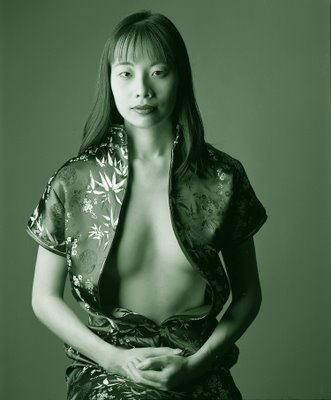
My granddaughter Rebecca is 11. Since she was about 5, when she would come to visit us on Saturdays, she and Rosemary would lie in bed and read the Vancouver Sun Saturday comics. Until recently my granddaughters and their mother Hilary would have Saturday dinner with us. Sometime around 8:30 there would be a loud plunk outside the door and I would bring in a thick NY Times, Sunday edition. I would ask Rebecca what day it was and once she would say it was Saturday I would amaze her by showing her the day and date on my Sunday NY Times. This confused for a while but only recently has she caught on that the paper is put together days before Sunday.
As I think of what seems the disappearance of newspapers and particularly of their home delivery which is such a large chunk of the expense of publishing one I know I am going to miss that thud when it no longer happens. I will miss (and I only caught on to this quite recently) what I knew existed and no longer exists.
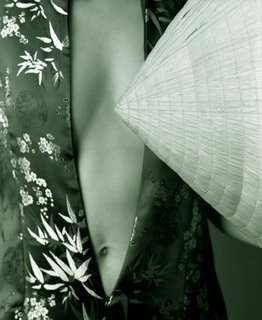
But not so Rebecca who will grow up in what will almost certainly be an era of amateur journalism. She will not miss newspapers because she was never really aware of their existence. It is almost no difference to the extinction of some Tasmanian rat we never knew about. How can we feel a loss? How can we mourn?
I am from a generation that would invariably look up when hearing the sound of an airplane's engines. And for most of my youth that was the specific sound of the propeller-driven airplane. I am also old enough in not having had a refrigerator or a telephone in my house. In fact in 1953 we were the first on the block with a Frigidaire and my friends all came to see how it worked.
My 1953 was an orderly world particularly when we studied geography. The Chinese lived in China, the Mexicans in Mexico, the Germans in Germany and so on. In those years some maps would show sleeping Mexicans under a saguaro cactus, a German in a short leather pants and the Chinese were invariably planting rice while wearing a conical hat that in Spanish (borrowed from the Tagalog) is called a salacot.
In Spain and in Latin America whatever is exotic must come from afar. And this is almost always China. India ink is tinta china and I would make my kites with bamboo and papel de china (tissue paper) stretched and glued with a mixture of flower and water. If you wanted to tell someone to go to hell you would say, "Vete a la Cochinchina." Cochinchina was the old name for Vietnam and that was as far away from Argentina or close to hell as any place could be.
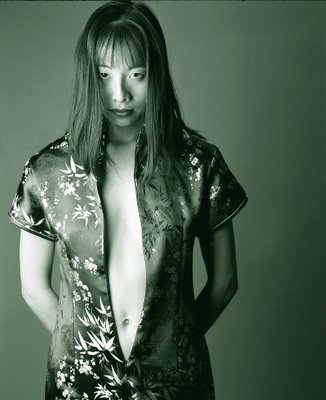
Except for the odd Bolivian woman wearing a bowler hat and begging on the street or gypsies (we were afraid of them because we were told they would take us away and then sell us) who would come house to house offering to read our fortune my Buenos Aires was almost all white. In the to-this-day class society of Argentina the darker ones were called cabecitas negras or little black heads. In my early years when I was around 8 we had some live-in help. They were a black couple, Zelia and Abelardo. They were jet black. They were from a very small population of black people who were remnants of the slave population of the early 1800s. Most had moved to Perú. I had never ever seen any Chinese or Japanese except a few Chinese at the American Grammar school I attended. The Chinese children were all from the Chinese embassy. Since my grandmother worked for the Filipino Ministry I saw may Filipinos and some looked Chinese. They even wore the salakots when we went to Christmas parties and they performed Filipino folkloric dances like the tinikling and one appropriately called the Salakót.
My mother and I were once invited to have lunch at the house of the Chinese ambassador. My mother taught his children at the American school. At the table I was amazed by food I have never in my life seen before (which I didn't dare try) and marveled at the bowls with the distinctive Chinese spoons. I bragged of the experience to my friends for weeks. While in Argentina, I had heard of a mysterious Japanese gardener called Matsumoto. But I never saw him.
Even though I have lived in Vancouver since 1975 when I gaze at anybody from China I think of mystery and the exotic. Most of the beautiful rhododendrons in my garden (rhododendrons don't grow well in Argentina) are of Chinese origin and the seem most exotic to me. I am dazzled by the way their leaves retract downwards (like a cat's ears) when it gets cold.
This idea of the exotic which comes from that formerly orderly world of mine is kept alive every time I gaze on my Russian submarine clock nailed to the trunk of my Western Red Cedar. I look at it and it as alien as those terrible Russian cars one would spot on the street so many years ago. It was almost like the steel they were made from was also alien and exotic.
In 2001 when I frequented the Exposure Gallery I often saw pictures of a beautiful and undraped Vietnamese woman called Lisa Ha. Just about every photographer that participated in the frequent group shows had photographed her. I was intrigued at the possibility seeing if I could do something different. I may have succeeded although I cannot show most of the results here because of my self-imposed rule of not posting nudes.
In my early shows in Vancouver I used to show at the Threshold Gallery which was owned by Mexican entrepreneur Samuel Frid. One of my first shows at his gallery was a show of domestic nudes which was part of a nude photography group show. I photographed women at home doing normal household tasks but undraped. I remember that a fierce and early Vancouver feminist movement panned the show (and in particular the other two photographers) because they had photographed the women as parts. A note was left that made me feel a tad content. The note read, "Thank you Alex, for showing us their faces."
I have rarely ever photographed the human body since without incorporating in some way that most important face. In some cases if the face is not there I try to use hands and the expressive use of hands which I believe in many ways can do almost as well.
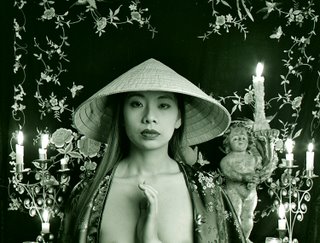
Lisa Ha was a mystery and a delight in my studio. In a second session I photographed her at Nora Patrich and Juan Manuel Sanchez's home and Nora set up an altar (in her living room!) behind Lisa. I have made a series of ethnic Virgin Marys and this one I called Santa Conchita de la Cochinchina. To this day when I look at these portraits I still see the exotic, the mystery of a world in which most of the countries in Africa would have borders in red. The were part of the British Empire. But there is one thing I can say about Lisa Ha without (I hope) fearing any kind of repercussions from those feminists of yore. Lisa Ha has the most beautiful chest I have ever seen in anyone. It is as dazzing and wondrous as that Chinese spoon.
And I wonder when Rebecca grows up if she will have a memory of the exotic and of mystery. What would it be? As for the sound of airplanes, I always look up.
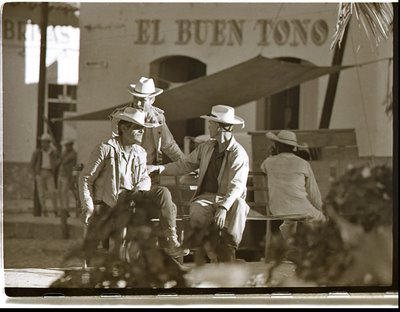
In 1964 I went to Valle de Bravo, a small town in the State of Mexico. I may have gone with my University of the Americas friends Roberto Hijar and Andrew Taylor. In those days when the 35mm film camera was king of the block we would go on photo expeditions. We didn't call them safaris yet. We would walk the streets with a couple of cameras hanging from our neck and shoot whatever moved or didn't. From the negatives (two here) I note that I was using that venerable Kodak 100 ISO film, Plus-X Panchromatic. To this day I still load my Nikons FM-2 with it and in 120 size with my Mamiya.
When I took this picture of the six white hatted men I felt like I was a painter and that they were posing for my brushes. The large sign painted on the wall, El Buen Tono , which can mean the good thing, a good tone (in sound) or even the right shade of colour, made my picture seem even better. I have always treasured it even though it is not quite as sharp as it should be. The men must have moved as this is the only exposure.
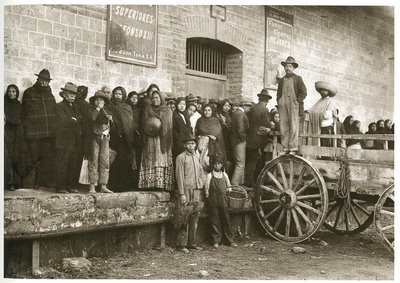
It wasn't until my Mexican friend Samuel Frid gave me, ten years ago, a book called Jefes, Héroes y Caudillos by the Mexican photographer Agustín Victor Casasola that I find out the true meaning of El Buen Tono. Casasola was the Matthew Brady of the Mexican Revolution. He, and photographers working for him, documented the revolution that brought down dictator Porfírio Díaz and ushered Mexico, through a blood bath, into the 20th century. In the book I found the photo (second from above) taken in August 1915 outside a railway station in Mexico City. On the left a sign reads Superiores Alfonso XIII El Buen Tono S.A. and on the right a sign reads Fumen Cigarros Mejores Superiores or Smoke Superior and Better cigarettes. The cigar and cigarette factory was founded by a Frenchman Ernesto Pugibet around 1884 and his company thrived even during the uncertainty of the Mexican Revolution. El Buen Tono was purchased by a larger Mexican tobacco company in 1962.
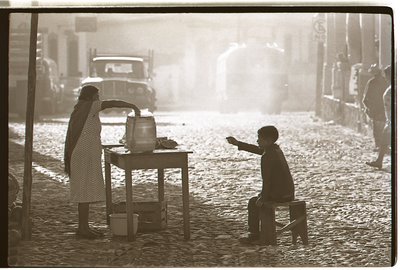
The third photograph is also one of my favourites from my era of street photography. I took it earlier in the day and I remember that the drink the woman was about to serve was agua de sandía or watered down watermelon. After taking the picture I got close to the boy and noticed that the coin in his hand was a 20 centavo piece.
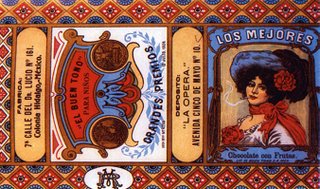
El Buen Tono practiced the same shenanigans as other tobbacco companies around the world in making sure that they would always have new clients. It would seem that they also manufactured candy and chocolate cigarettes for children. Under the lovely smoking lady, it reads chocolates with fruit.

In the late 50s I became a science fiction fan and by the beginning of the 60s I was reading anything I could find. And this included a barrage of science fiction paperbacks featuring short story collections by individual authors or anthologies by Judith Merrill. The two science fiction short story collections that I remember best were Arthur C. Clarke's Tales From the White Heart and Ray Bradbury's Golden Apples of the Sun. Vivid in my memory from the latter is the story The Pedestrian, where a lone night walker observes the flickering shadows behind the windows of homes where people were watching their TV's in his journey through the neibourhood. A police car stops the suspicious man (by then nobody walked anywhere) and takes him away to jail. While in the police van our pedestrian is able to ascertain that there is no policeman on board (they are at the station watching TV) and that the voice of the arresting officer (and driver) is a robot.
By the end of the 60s I lost my taste for science fiction and subsequently my desire to read short stories. For me short stories did not have enough plot twists or character development. But since I was an Argentine I read everything Borges ever wrote (short stories) and most of the short story collections by Argentine Julio Cortázar. I made some other exceptions like Los Cachorros by Mario Vargas Llosa or the excellent short stories by Alejo Carpentier including his backwards Viaje a la Semilla ( Journey Back to the Source) which preceded (1958) the plot to The Curious Case of Benjamin Button. In English I made an exception to The Stories of John Cheever.
I had read so many reviews in the NY Times about Alice Munro's shorts stories that in 1990 I bought and read Friend of My Youth. Around 1980 or 1981 I had photographed her outside her old house in North Vancouver. I felt I had to give her a try. While I will read non fiction essays I still eschew shorts stories and opt for novels.
The theme of short stories became entrenched in my mind today via an email from my unlikely named first cousin Willoughby Blew who lives in Florida. He sent me this:
Subject: FW: Violinist in the Metro--- Washington DC.
A man sat at a metro station in Washington DC and started to play the violin; it was a cold January morning. He played six Bach pieces for about 45 minutes. During that time, since it was rush hour, it was calculated that thousands of people went through the station, most of them on their way to work. Three minutes went by and a middle aged man noticed there was a musician playing. He slowed his pace and stopped for a few seconds and then hurried up to meet his schedule.
A minute later, the violinist received his first dollar tip: a woman threw the money in the till and without stopping continued to walk. A few minutes later, someone leaned against the wall to listen to him, but the man looked at his watch and started to walk again. Clearly he was late for work.
The one who paid the most attention was a 3 year old boy. His mother tagged him along, hurried but the kid stopped to look at the violinist. Finally the mother pushed hard and the child continued to walk turning his head all the time. This action was repeated by several other children. All the parents, without exception, forced them to move on.
In the 45 minutes the musician played, only 6 people stopped and stayed for a while. About 20 gave him money but continued to walk their normal pace. He collected $32. When he finished playing and silence took over, no one noticed it. No one applauded, nor was there any recognition. No one knew this but the violinist was Joshua Bell, one of the best musicians in the world. He played one of the most intricate pieces ever written, with a violin worth 3.5 million dollars. Two days before his playing in the subway, Joshua Bell sold out at a theater in Boston and the seats average $100.
This is a real story. Joshua Bell playing incognito in the metro station was organized by the Washington Post as part of an social experiment about perception, taste and priorities of people. The outlines were: in a commonplace environment at an inappropriate hour: Do we perceive beauty? Do we stop to appreciate it? Do we recognize the talent in an unexpected context?
One of the possible conclusions from this experience could be: If we do not have a moment to stop and listen to one of the best musicians in the world playing the best music ever written, how many other things are we missing?
Willoughby Blew's email messaged intrigued me and delighted me. I had not heard of this incident. I immediately put the title Violinist in the Metro--- Washington DC. followed by a comma and The Washington Post. What I found was the original article. The story even includes a short video excerpt of Bell playing one of Bach's partitas for unaccompanied violin at the location in the Washington Metro.
I leave any reader here to decide which is the better story.
The short story idea came to mind because had I not been curious enough to locate the original, Willoughby Blew's email would have sufficed. We simply do not miss what we do not know exists. As we say in Spanish "Ojos que no ven, corazón que no siente."(You cannot feel in your heart what you cannot see.)
With our scatterbrained approach to music via the randomness of an iPod and multitasking, who has the time to read a novel? Would writing and publishing short story collections be a wave of our future?
Not for me.
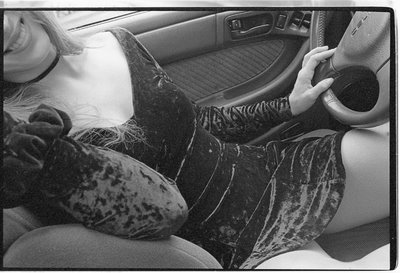
It was Christmas Eve in the morning some four or five years ago. I was having a pleasant coffee with my friend Ian across from the Exposure Gallery on Beatty Street. My cellular phone rang. It was S.... I had not heard from her for a couple of years. I had taken her pictures on and off for about three. She sounded just fine. "T... wants to talk to you." I did not know who this T... was. As soon as he began to talk to me I was never able to talk back or have him acknowledge what I said to him. He was brutal. He said,"I want you to return all the negatives that you took of S.... or I will hurt you terribly. I know where you live and I know where your daughters live. I am going to hurt them unless you return the negatives. People like you should not be allowed to live and should not have been born. The pictures that you took of S.... are disgusting and dirty. You are a monster. You should be dead."
I hung up.
"Never hang up on me again, or it will be worse. I will burn your house down."
I hung up.
I called Rosemary who told me that S.... had called and that she had wanted my cell phone number.
I called the police. A young policeman showed up within the hour. He told me that I had nothing to worry and that nothing was going to happen. These were only empty threats. "In most of these cases, they don't amount to much," he calmly added. I did not feel calmed. He gave me his card. "Call me if T... calls again.
Rosemary phoned all in an uproar. It seems some guy had called her and threatened her unless she convinced me to return stuff that belonged to him. I went right home. As soon as I was in the door the phone rang. I had a feeling it was T... It was T.... I was not able to stop his one-sided conversation which was all the worse because he almost whispered and never shouted. All he wanted form me was a, "Yes, I will return them." I was really scared for my life and I wondered if my decision to never give anybody my negatives unless they were purchased was a decision I would have to modify here. Should I sacrifice the health of my wife and daughters to defend my right to what was mine?

I called S....'s ex boyfriend who made it all worse. "That's T... the Taliban. He is a punk. He has S... really under house arrest and she cannot see any of her friends or get out of the house. If you like you and Rosemary and your daughters can spend a month with me in my house. You will be safe with me." That really made it worse even though I knew that the RCMP kept a watch on his house for some other stuff that has no bearing to this story.
T... called again and I was paranoid. I would look out of the window every time I heard a car. I would watch from the corner of the window.

Then I called my friend the hood. I told the hood everything. The hood said, "Alex, don't you worry. I can take care of this. That T... the Taliban is just a young punk. He doesn't know any better.
The cop called again for more names. I gave them out to him and he said he was going to investigate. He told me that every time that T... called I was supposed to press some key on my phone so that they could trace the call.
That Christmas Eve and the corresponding Christmas day were the worst of my life. Rosemary kept looking at me and saying just with her eyes, "Is it worth going through all this just for the sake of your pride and for some negatives of a girl who should have known better? " I was at the point of giving in.
Then T... never called again. The cop made an appointment to see me. He said, "Mr. Hayward, you have powerful friends. As far as I can tell you no longer have a problem." And he wouldn't tell me more. I called my friend Steven Pranzl a homicide cop who only told me just a bit more. He knew who my friend the hood was and added, "T... will not call you again."
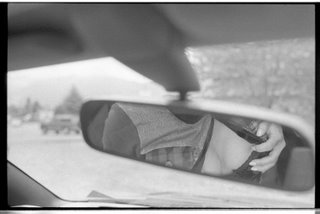
A year or two later I found out that S.... had gone to the police to obtain a restraining order on T... and she eventually married a nice man. As far as I know she is living happily ever after.
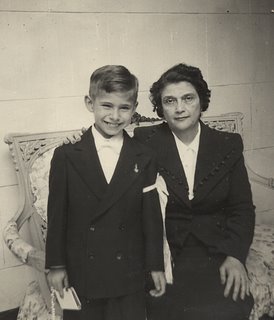
My grandmother Lolita had a sweet tooth. There is one time that is still vivid in my mind. I must have been around 14 and we were at the breakfast table. She was served a large cup of coffee in which she poured Carnation evaporated milk and a generous amount of sugar. She then buttered her bolillo, spread peanut butter on top and then spooned a thick portion of strawberry jam as if it were the most expensive caviar on it all. She looked at me with delight, winked and then dunked her creation into the coffee. I will never forget the clicking of her false teeth when she bit into her food. We had a conspiracy between us. Anything was allowable and or excusable because we were artistic. My mother and my father were the disciplinarians but if my grandmother was around I was always safe. She would say, "He did nothing wrong. He is an artist. He has inherited that from me and you need to understand that."
Because of my abuelita I was dispatched to painting lessons with Robin Bond in Mexico City. Bond had honed his skills during the London Blitz as an expert in the art of camouflage. In Mexico City he was the only one who knew how to paint TV sets in the right shades of gray in the primitive era of b+w television. He was an old-style bohemian who smoked lots, drank large quantities of espresso laced with amber liquids from mysterious bottles. He mixed the paints for his canvases on his studio walls. It was at Bond's where I found out that artists liked lots of women. There were always many there. He had a studio couch with rumpled sheets. Perhaps his women posed for him there or perhaps not. I wondered.
With my abuelita I discovered the wonders of Technicolor movies. They always featured handsome swordfigthers or weathered men like Randolph Scott. I learned about opera from her. "I was a coloratura soprano but my father did not allow me to become a professional. He said only harlots did that sort of thing." The word harlot was always the softer euphemism "mala mujer" or bad woman. She would then break into an aria from Donizetti's Lucia di Lammermoor.
I cannot remember on single incident in which my grandmother ever told me I could not do something. It was always, "If you do this, this is what is going to happen to you." My favourite reaction from her when I would refuse to eat something I didn't like was (she said it in Spanish), "The donkey that got used to not eating died." But then she knew I knew of her own trick for not eating what she did not like, "I just love Brussels sprouts but they are so bad for my liver. If I were to eat them I would have a tremendous attack." Invariably she would look at me from the side and I knew the wink was coming.
Until one day in the late 60s when Abuelita returned from Cairo and she looked at me an did not recognize me we had a special relationship. One particular incident is memorable. We went to the opening of a young Filipino painter and the pride of his show was a very large painting featuring a pair of ugly Mexican huaraches. "Tell me," she asked the young man, "why is it that you would paint something so ugly when there are so many beautiful things you could have painted?" The painter retorted very quickly to the delight of my grandmother, "Ah, but there is the beauty of ugliness!" Suddenly the three of us were onto something.

For a while I had hoped to reverse this role and relive it with my granddaughter Rebecca but it seems that the "conspiracy" between us is on hold and the distractions inch her away, day by day. Perhaps the longer days of late spring and the scent of my roses will bring her back.

For 20 years beginning in 1980 Duthie Books and Celia Duthie (below, right) published in Vancouver little gem four times a year called The Reader. Celia Duthie would ask some of her friends and, some who were not, to review books for it. She had one command, a command she gave me once and which I always followed to the letter, "Try and pick a book you think you are going to like."

The whole idea for today's blog suddenly came to me last night when I read the following in Edmund Wilson's Memoirs of Hecate County, in the story The Millhollands And Their Damned Soul :
"We wondered whether you mightn't like to do a piece about the book in the Christmas number of the Booklover - I thought it would be right up your alley."
But this book by George Paine was the first that I ever refused to review for the Mullhollands. I realized that there would now be conditions imposed which I had not had to worry about in writing for the Booklover before, in the pre-Reader's Circle days: I should have to say the book was good and I should have to make it sound important.
I never had the problem the narrator of that story had. I reviewed quite a few books for Celia Duthie and I always picked books I was excited about. My editor at The Reader was Maja Grip, perhaps the most retentive editor I have ever met yet who gave me the freedom to have fun in my reviews. Even though the magazine is long gone most of the reviews live on in the archives of The National Library of Canada Electronic Collection. My favourite of all my reviews is a double one I made which included books by Mario Vargas Llosa and Paco Ignacio Taibo II. The original article did include the photo of Mario Vargas Llosa that is here. I am including a photograph that I took of Paco Ignacio Taibo II in the two-block long Chinatown in Mexico City.
The Reader XIV II - A Fish In The Water & Four Hands
--------------------------------------------------------------------------------
A Fish In The Water
By Mario Vargas Llosa
Translated by Helen Lane.
Farrar Straus Giroux, New York, 1994, 532 pp., $32.95
Four Hands
By Paco Ignacio Taibo II
Translated by Laura C. Dail.
St. Martin's Press, New York, 1994, 378 pp., $31.99
Reviewed by Alex Waterhouse-Hayward
If you were to approach a Hollywood producer with a screenplay based on a true story in which a Peruvian writer marries, as a minor, an older aunt; writes about it in a novel (Aunt Julia and the Scriptwriter), that is made into a movie (Tune in Tomorrow, 1990) with a screenplay by a highly regarded Ghanian author (William Boyd) who changes Lima to New Orleans, you would probably be ejected before you could proceed to add that the novelist subsequently dumps his aunt in Paris for his first cousin whom he marries. At the Mexico City premiere of a movie based on his novel Captain Pantoja and the Special Service, he punches and floors a Colombian Nobel Laureate (Gabriel García Márquez). He writes many acclaimed novels until as a restless 50-year-old he ponders the possibility of writing a comedy about an impresario who finds a childhood friend whom he thought was dead, alive, well and now a woman in a suite at the Savoy in London. The project is shelved in favour of running for President of Peru, a job he almost wins but for the fact that he eats a not-so-fresh ceviche in Piura and discounts, until too late, the competition from a Protestant Japanese/Peruvian agronomist dubbed the chinito (the little Chinaman).
In A Fish in the Water Vargas Llosa tells his story from his birth in Arequipa until age 22 while deftly alternating with a fascinating blow-by-blow account of his 1987 to 1990 unsuccessful run for the Peruvian presidency. "It is true that if the presidency of Peru had not been the most dangerous job in the world, I jokingly told a journalist, I would have never been a candidate." On a lonely Piura beach in August 1987 Vargas Llosa ponders the historic inability of Peru to improve itself: "That historical failure seemed to me to be a sort of sign of a country which, at some moment in its trajectory, fucked itself all up."
You wouldn't fare any better with the Hollywood producer if you were to return with a different story about a Mexican/Spanish writer (Paco Ignacio Taibo II) who writes acclaimed thrillers (An Easy Thing, Some Clouds, No Happy Ending), whose hero, Héctor Belascoarán Shayne, is a jazz-loving Chinese food enthusiast Mexican/Basque/ Irish private dick in Mexico City, who singlehandedly manages to escape from the clutches of corrupt judiciales, or the equally corrupt government officials of the Partido Revolucionario Institucional. Realizing you are not getting anywhere you explain that Taibo has now written something completely different. In Four Hands, Arthur Stanley Jefferson (known after 1920 as Stan Laurel) witnesses, while on a binge with 9 bottles of Bols gin, Pancho Villa's assassination in Parral, Chihuahua. Stoyan Vasilev, an 80-year-old veteran of the Spanish Civil War, is an unwitting pawn of a complicated anti-Sandinista plot. The plot is thwarted by Longoria, a twice-dead Spaniard buddy of Vasilev's who lives in the Sanatorio Español on Avenida Ejército Nacional in Mexico City. The interlacing plot includes Leon Trotsky, writing a thriller while working on his Stalin biography, and two journalists (who work together---hence the four hands), one Mexican and fat, Julio (who is obsessed with Laurel & Hardy films); the other Jewish American and thin, Greg, whose uncle was Houdini's psychiatrist).

To those readers who are used to the linear approach of most contemporary fiction, Four Hands can serve as an exciting initiation into the more complex but in the end very satisfying style of novels such as Llosa's Conversation in the Cathedral or to what may have been the first example of early hypertext, Julio Cortázar's Hopscotch. That might then lead to the discovery of such Latin American writers as Augusto Roa Bastos, Alejo Carpentier, or Gabriel García Márquez.
Somehow the Hollywood producer is convinced and the green light is given on the above projects so I decide to cash in on my own personal experiences. This reviewer used to play ping pong in the early 60s in the premises of the Club Mundet. This is an athletic club in Mexico City on Avenida Ejercito Nacional, not far from the Spanish Hospital, whose members were mostly exiled Spanish Republicans. One of the better challenges was playing against a very short spectacled kid called Paco. He was so short that I could barely see his eyes over the edge of the table. He was interested in my interest in photography and wanted me to accompany him to photograph the one block-long Chinatown on Dolores Street.

In 1990 I went to Lima to ask Mario Vargas Llosa why it is that he obsessively describes red geraniums growing in the front gardens of the houses in many of his Lima novels. His answer was, "Vasco da Gama returning from the Cape of Good Hope took the geranium back to Portugal. From there it was taken to Extremadura in Spain where it thrived in the desert environment. The Conquistadores Cortez and Pizarro brought the plant to America. In Lima nothing grows except the geranium. It should be our national flower as it thrives in adversity." Vargas Llosa was not feeling well (see photo) so he did not attend a campaign talk at the Peruvian/Japanese Society. The members did not believe the story of the not-so-fresh ceviche he had eaten in Piura. Because of his sickness his campaign manager decided to make some TV spots in Llosa's back garden in Barranco. It was soon transformed to look like a pueblo joven (slum). An appropriately "dirtied" little boy was brought in to pose.
As Belascoaran Shayne asks in Sueños de Frontera, 1990, in a Taibo tribute to Vargas Llosa, "A qué horas se jodió todo? When did it fuck itself all up?"
I know.
Alex Waterhouse-Hayward is a Vancouver photographer of Latin American Ancestry.
--------------------------------------------------------------------------------
{ Literascape } { What's New } { The Reader } { Fall 1994 }
Copyright © 1996 Duthie Books Ltd. All Rights Reserved. Literascape is a Trademark of Duthie Books, Ltd.
Here for a delightful review of a Patrick O'Brian novel by Marv Newland.
The Reader was a lovely little booklet/magazine printed in very good stock. It was a little jewel full of passionate reviews by reviewers who loved to read and picked books by their favourite authors or authors that wrote about something that they, too had a passion for. Witness the above loving review of O'Brian's novel by a nautically obsessed Marv Newland. This sort of review does not appear, to my knowledge, in any other Vancouver publication. At one time even the Vancouver Sun occasionally paralleled The Reader. I can remember the day day sometime in 1998 when I received a phone call from then Arts Editor, Max Wyman, who said, "Alex, I have here A History Of The Breast by Marilyn Yalom. I think this would be right up your alley. Would you want to review it?" Of course I was interested and, yes, I did review it. Max Wyman, Celia Duthie were are you?
Free Will & Wreck Beach
Thursday, January 22, 2009

My wife Rosemary and I differ in how we look at our past. Rosemary spends long hours, as I sleep, wondering about the what ifs and the what if I had nots.
At our religion class at St. Ed's in Austin Texas we often liked to detour Brother Edwin Reggio CSC from the topic at hand. One of our favourites was to bait him with the concept of free will. "How is it possible for there to be free will if God is All Knowing?" we would ask him. To this day I have a deep respect for this adroit man who gave us logical answers and never got angry at us except twice.
Once it involved one of the biggest and heaviest of us, Byron Todd and the other and obstreperous Richard Mosby who was the only black student in our class. Both talked out of turn and pressed some buttons that we did not know Brother Edwin had. Brother Edwin, 5ft 1 was short and a tad compact. He picked Mosby on the one day and Todd on the other (some of my classmates swear it happened on one day and that he picked up each boy at the same time) with one arm and threw him across the room. We were impressed beyond imagination wondering what laws of physics our Brother Edwin had circumvented. It was only last year that Brother Edwin told me that his father and he and his brother had been Olympic ring champions.
My belief is that Brother Edwin welcomed our break-the-topic-of-the-day detour because he liked to debate and make us use our brains. He never gave us a hint at all the he knew what we were up to.
On the day that we asked him about free will he explained it like this:
Picture yourself up on the top of a mountain and you are looking down on both sides of a sharp hairpin curve. You see cars coming, very fast from either direction and you can also spot a large rock impeding one lane where the curve is at its sharpest. You can see that the cars will be involved in a head on collision. Perhaps you could stop the accident but you choose not to. That's free will.
I sleep most nights well while Rosemary agonizes on how we could have better invested our money or obtained better jobs or purchased a better house for less money (and bathrooms that don't leak) and in the right side of Granville instead of the wrong one. She wonders where we went wrong because our daughters didn't marry lawyers or engineers.
When we first came to Vancouver in 1975 I was not able to get work as a photogrpaher. I was simply not as good as I thought I was. I needed experience and knowledge of what was available in town. I ended up washing and renting cars for Tilden-Rent-A-Car (In Canada It's Tilden. May I help you?) The shift work meant that I only had one complete weekend per month. There were days when the girls were in school and Rosemary was at work.

I would go to lie on the sand of Wreck Beach in the Summer. I ran into people who had ways of only working in spring and fall so that they could travel in winter and lie on the beach in the summer. I was jealous even though many worked as waiters or waitresses and in the construction business. These were jobs I was not keen to look for. To this day Rosemary insists I was a lazy bum for many years and that I should have found better things to do with those spare days. "You could have looked for a better job."
What is the connection of the above with the pictures of a blonde school teacher called Marley W that I met at Wreck Beach? It was at Wreck Beach that I honed my photography of the human form. It was my on the spot live art class. I tried new films, odd films, odd film/developer combinations and in a couple of the pictures here I perfected my understanding of Kodak b+w Infrared Film and Kodak Special Order SO-115 which had incredibly fine grain and a shift towards the red that rendered skin luminous. I practiced using extreme wide-angles and learned how much distortion was acceptable. I learned to photograph the human form as pure form. It was later, as a I developed more confidence, that I started shifting towards the portrait.

Marley W. was a lovely and patient young woman who posed for me for long hours without protest and made me feel that what I was doing was the right thing and that it would better me. And best of all she taught me to appreciate poise and elegance.
No if I could only convince Rosemary. She would sleep nights.
St Edward's High School
No Streaming Video Of Abraham Lincoln In My Head
Wednesday, January 21, 2009

Yesterday my wife lept from the 20th to the 21st century in bed. She watched Obama's swearing in ceremony as streaming video on the NY Times with her Toshiba laptop. I did my best to read the hard copy version of the paper while juggling a large mug of strong tea. Last night after she returned from a computer class she immediately turned on the TV to see what Michelle Obama's ball gown looked like.
I had this curious feeling that I did not want to listen to Obama make yet one more speech. Yet there I was as he made one, so out of context, between dances while his wife behind him was waving acknowledgment to friends. It seems this guy could even give a speech while barbecuing.
Ubiquity of Obama's face and voice has done me in. I gave it some thought last night and came to the realization that Abraham Lincoln and even Ulysses Simpson Grant seem to be so much more real in the b+w images that I have in my mind of them as oposed to all those streaming colour videos of Barack Obama. Ubiquity is making him invisible to me. Or at the very least when he turns his face to one side while speaking (which projects seriousness and the weight of pathos) I feel I am watching a Bugs Bunny cartoon. This is not in any way a feeling of disrespect. Much to the contrary I hold much hope that finally we (as in the world) have an intellectual in the White House who is known for reading books. As my Canadian Tire flyers point out, "Now, that's different!"

My reaction to streaming colour is perhaps the effect of that special moment in my life when I was around 8 when I went to an American library in Buenos Aires and gazed on my first photographs of American Civil War soldiers taken by Matthew Brady, Timothy O'Sullivan and Alexander Gardner. The sharp and stark b+w images made the man I stared at look like their pictures had been taken days or hours before. Then it sank in (my first intimation of my own mortality) that these men had been dead for almost a century. These were the first photographs of real people that I really ever seen. That impression has remained to this day.
Photographer Alexander Gardner took that glass plate portrait of Lincoln with the crack (ominous in retrospect) on February 5, 1865 less than two months before his assassination. The portrait of Grant, it has a startling modern look to it, I found, with no credit and undated in my book My Brother's Face - Portraits of the Civil War In Photographs, Diaries and Letters by Charles Phillips and Alan Axelrod, Chronicle Books San Francisco, 1993.
What is even more startling and endearing, too, is what Grant wrote of his meeting with Lee to accept his formal surrender at Appomattox:
When I went into the house I found General Lee. We greeted each other, and after shaking hands took our seats. I had my staff with me, a good portion of whom were in the room during the whole of the interview.
What General Lee's feelings were I do not know. As he was a man of much dignity, with an impassible face...his feelings... were entirely concealed from my observation; but my own feelings...were sad and depressed. I felt like anything rather than rejoicing at the downfall of a foe who had fought so long and valiantly and had suffered so much...
General Lee was dressed in full uniform which was entirely new, and was wearing a sword of considerable value...In my rough traveling suit...I must have contrasted very strangely with a man so handsomely dressed, six feet high and of faultless form...
We soon fell into conversation about old army times... Our conversation grew so pleasant that I almost forgot the object of our meeting.

In one of my many visits to Washington DC, this one in 1965 I happened on a scene where a photographer was using an old Cirkut 5x7 inch swivel lens panoramic camera to photograph a group. The photographer, James E Ivey had inherited the exclusive franchise and the camera from his father. At the time Ivey was there almost every day of the week with his Dalmation. On the far right the man on the equestrian statue is Ullyses S. Grant. It was June and when I walked up the capitol steps I could smell the fragrance coming from a huge Magnolia grandiflora or Southern Magnolia and I wondered if Abraham Lincoln had ever stopped to smell them, too.
The picture above of Lincoln's inauguration was taken March 4, 1861 by Montgomery C. Meigs. This year I plan to find, buy and read The Personal Memoirs of Ulysses S. Grant.
Rebecca At The Willard Hotel

In 2003 Rosemary, Rebecca and I visited Washington DC. I insisted in having lunch at the venerable Willard Hotel. I explained to Rosemary and Rebecca that the term lobying came from the early meetings in the 1850s, 60s and 70s of politicians with people who wanted to "buy" favours. Surely Abraham Lincoln and others must have walked the corridors of the hotel. I thought I could feel their presence. Some day Rebecca will return to DC. If she happens to lunch at the Willard Hotel I hope she still remembers and runs into my presence.

We walked to the Capitol and I showed Rebecca and Rosemary the large Magnolia grandiflora on one side of the capitol steps. I told her that Abraham Lincoln might have stopped to smell the very large and beautiful white flowers. At the National Gallery Rebecca spotted this painting ( Giant Magnolias on a Blue Velvet Cloth, Martin Johnson Heade) and said, "Look that could even be Abraham Licoln's magnolia."
Doña Marina, Tiny Bananas, Pineapple Juice & Turkey Tacos
Tuesday, January 20, 2009

Bernal Díaz del Castillo in his Historia Verdadera de la Conquista de La Nueva España mentions the appearance of La Malinche (as Mexicans call her and Doña Marina as Spaniards reverently call her) in April of 1519, when she was among twenty slave women given by the Chontal Maya of Potonchan in the present-day state of Tabasco to the triumphant Spaniards. According to Díaz, Malinche was the noble first-born child of the lord of Paynala near present-day Coatzacoalcos, then a "frontier" region between the Aztec Empire and the Maya states of the Yucatán Peninsula. In her youth, her father died and her mother remarried and bore a son. Now an inconvenient stepchild, the girl was sold or given to Maya slave-traders from Xicalango, a commercial town further south and east along the coast. Díaz claims Malinche's family faked her death by telling the townspeople that a recently deceased child of a slave was Malinche. At some point, she was given or sold again, and was taken to Potonchan, where she was ultimately given to the Spaniards.
Since la Malinche was fairly attractive Cortés gave her to noble born friend Alonzo Hernando Puertocarrero. When Cortés sent Puetocarrero as an emissary to the court of Holy Roman Emperor Charles V (but also Charles I King of Spain) he kept her for himself. Her knowledge of the lingua franca of the region Nahua meant that when she learned Spanish she was able to translate for Cortés.
To this day Mexicans have a complex relationship with a woman they feel sold them out to the Spaniards. There are some, who to the contrary, think that as she was also the lover to Cortés, she was able to somewhat soften the effect of the Spanish conquest. The language and customs survived to the present day. The Aztecs noted such a closeness between La Malinche and Cortés that they called them both by the epithet Malintzin. In the Mexico of today a malinchista is a person who prefers the foreign to the domestic. La Malinche fades into history in 1529 and or 1551, both dates given as her possible death.

When my mother returned from a trip to Mexico in 1953 (we moved to Mexico from Argentina the next year) she told me how there was not a single statue, memorial, street, park named after Hernán Cortés. The exception to the rule was a hotel of somewhat ill-repute (refurbished in the 70s) near the centre of the city called el Hotel Cortés.
The father of one of my favourite Mexican/Spanish writers, Paco Ignacio Taibo II, Paco Ignacio Taibo I tells a story in a lovely CD I bought many years ago in Mexico about leaving Franco's Spain in 1958. Paco senior, like his son, were both of severe leftist tendencies. There was no room for the father and his family in dictatorial Spain. They sailed for Mexico. In a delightful bit of magic realism, Paco Ignacio Taibo I decides to invite a little old lady who also lived forgotten in Spain. The little old lady is Doña Marina as Spaniards reverently call La Malinche. Doña Marina reluctantly accepts but becomes very depressed saying that Mexicans will reject her when they arrive at the port city of Veracruz. She locks herself in her cabin. Taibo I brings her jugo de piña (pineapple juice), plátanos dominicos (finger bananas) and feeds her tacos de guajolote (turkey tacos). When the ship finally arrives and Doña Marina finally emerges from her cabin she is young again and beautifully dressed in white. Taibo I tells Doña Marina, "Let's disembark and enter your land again. Both of us are from conquered people (Taibo’s leftists leanings defeated by Franco), we have that to share." Doña Marina replies, "I will try again."
When they disembark and go through customs they feel the presence of a middle-aged man dressed in a suit of armor. Taibo I and Doña Marina note it is Hernán Cortés. They are surprised to find him alive and in Veracruz since those who know, know hir remains are walled in the church of San Juan de Diós in Mexico city a few meters from the old Cortés Hotel. Cortés looks at the pair and says, "Otro gachupín nos cae encima, “or "Another Spaniard is upon us to bring us tragedy." Cortés turns around and loudly shuffles away in his rusty armor.
To this day I often look at Mexicans in the street, Mexicans in buses, Mexicans at the beach, Mexicans everywhere, and in spite of North Americans from the US and Canada asserting that Mexicans are a happy "fiesta" people I can always discern a look of sadness and tragedy in their faces. I saw this when I was attempting to photograph the lovely Ms Hernandez as an Aztec princess. The more I look at my picture the more I think that the Aztec princess in question is none other than Doña Marina. She is a Doña Marina that, alas, Paco Ignacio Taibo cannot feed turkey tacos, pineapple juice and finger bananas. Taibo I died in Mexico, his adopted land, last year.
It might interest some that the Spanish name for a finger bananas, dominicos also means a Dominican priest or monk. There are those who further add that the size of the little bananas reflects a specific organ of the hated priests who were in charge of the Spanish Inquisition. Furthermore in most Spanish speaking countries a bakery delicacy there is a largish spherical concoction almost identical to a donut hole. Mexicans and Spaniards like to dunk them in thick hot chocolate. Depending on whom you ask this delightful pastry is either called suspiros de monja (a nun's sigh) or bolas de monje (a monk's testicles). And the inhabitants of the Dominican Republic, distancing themselves from any connections to priests and finger bananas, call themselves dominicanos.
La Mujer Durmiente - The Sleeping Woman
Monday, January 19, 2009

In 1952 my mother made an exploratory trip to Mexico from Buenos Aires. While there she had her hand read by a curandera woman who told her that her attraction to two volcanoes of the Valley of Mexico, Popocatepetl and Ixtacciuatl would make her return. When we did move in 1954 my mother pointed out the two snow-capped mountains from the window of our PanAm plane. I had never seen real snow except in films. Our airplane had crossed the Andes from Buenos Aires to Chile at night on our way to Mexico. Because our airplane was an early version of the Douglas DC-6B it wasn't properly pressurised and we were given oxygen masks when we crossed the darkened peaks of the Andes.
From then on whenever I could spot the two volcanoes I would gaze in wonder. By the late 60s Mexico City's pollution hid them except for a few days of the year. There are many Aztec legends about the two peaks. Ixtacciuatl was the sleeping maiden who waited in vain for her Aztec warrior to return from war. When he returned he found her asleep. The story ends much like an opera. In Spanish Ixtacciuatl is called la mujer durmiente or the sleeping woman.

It is surprising how the most obvious of things isn't always so. It hit me some years ago (not that long!) that nostalgia could only be felt outside of the place you had the feeling for. Thus after a year of living in Venice (if that were ever to happen to me) I would be suffering from Vancouver nostalgia and I would be out scouring the canals in the lookout for an attractive Canadian woman I could photograph undraped under an umbrella.
Since I met the lovely Ms Hernandez who hails from León, Guanajuato some months ago I have been taking her pictures and imposing (she is most willing) my nostalgia on her. Today's which is a photograph I took yesterday, is my nostalgia for those Mexican volcanoes of my youth.

In the late 60s I spent 2 months working as un unpaid assistant to the then most famous Mexican commercial photographer, Arno Brehme. His father Hugo Brehme had become famous in the 20s taking pictures of artistic Mexico which were subsequently converted into postcards. One of his most famous is of the two volcanoes.
The Princess With The Golden Hair
Sunday, January 18, 2009

I got to like the big-hipped cat-faced women of the photographs shown as lures out in the front of the Fourteenth Street burlesque show; the announcements of moving picture palaces bejeweled with plastic-bright lights; the little music shops that sold big brass-band instruments and Slavic and Balkan records and had radios tht blared into the street; the Field's restaurant window with the white-aproned girl, blue-livid under a mercury tube, making pancakes on a hot metal slab; the young women of the pavements, some of them pretty, Italian or Jewish or whatever, stopping to look in at the displays in the windows of the dress and the shoe shops.
The Princess with the Golden Hair - Memoirs of Hecate County - Edmund Wilson

It was sometime in 1981 that I was approached by the very lovely but also very politically active Anne Gordon. She had helped organize the Vancouver strippers into an organization called VEDA (Vancouver Exotic Dancers Association).They organized stripathons for charity. What Gordon wanted from me was a series of risque postcards that were going to be sold at something called The Best Of Burlesque 1981 that was going to be held at the Marr Hotel on Powell Street.

I took 9 different situations and I am posting 7 of them here as the other two would be completely defaced of any value if I were to hide "stuff." By today's standards these postcards are tame indeed but perhaps some of you might discern just a bit of charm.





The Scissor - That Singularity
Saturday, January 17, 2009

When I first met my future wife Rosemary Healey in 1967 I had no idea what Canadians were like. I knew nothing about Canada. Rosemary was blonde, she spoke English, she wore miniskirts, see seemed to be a gringa like most of the other gringas we Latinos were inexorably attracted to. I first noticed something was amiss when she told me about her grade 12 students she had brought from Canada in an exchange program. It sounded odd. "Do you mean the 12th grade I asked her?" Then she told me of a man she said was the prime minister of Canada. His name was Pierre Trudeau. And she added, "he is sexy." I had no idea who the man was. In Mexico at the time my only connection with Canada was the pine (not a pine at all, and how was I to know it was a Douglas Fir?) we bought at Christmas time. A label said, "Importado del Canadá."
Rosemary was born in New Dublin, Ontario. I asked her if she had totem poles in her town. She told me she had never seen one in her whole life and in fact the first one she ever saw we saw together in Chapultepec Park, not far from where we lived in Mexico City. I was further confused when I asked her about Indians. Like those poles she told me she had never seen one in her life. It was from Rosemary that I first heard of a Canadian sport called skating on the Rideau Canal. She told me the best place for it was in Ottawa which was not far from the university she had attended called Laval in a place called Quebec. To top it all she pronounced that last place like the que in que será, será... It was about that time that I had read a National Geographic article on Canada that stated that Ottawa was the coldest major capital in the world and even colder than Moscow.
The big shocker was the day she told me, "Alex, you need a new pant." In hindsight I should have known better. In Spanish pants can be pantalones but we usually prefer pantalón. In fact if you go to the Real Academia Dictionary of the Spanish Language (RAE) you cannot find words like pantalones or tijeras. While you would say both in Spanish and in English to pass me the scissors, in fact that word does not exist. The instrument in Spanish only exists as a singularity. Perhaps Rosemary was speaking in some ancient but correct English were a pant was pant, nothing more and nothing less even if that pant had two cuffs.
It became patently obvious that I was in love with a strange foreigner. The Americans to the North of Mexico had a good word for such non-Americans. They called them aliens.
But things began to normalize when I noticed that Rosemary had an affinity for that troubling singularity, the scissor. The scissor would always disappear no matter where I hid it. The scissor was always important in my family as both my mother and grandmother had many pairs of them. The sight of my mother and grandmother with a scissor in hand was a comforting memory of my past that was now refreshed by Rosemary. We bought some black plastic material and a bra. I used the bra to make a pattern and with Rosemary's scissor I cut the plastic into the appropriate wedges. Soon Rosemary had skillfully sewed a bikini to die for.
In fact Rosemary was not only interested in the scissor to the point of obsession (that has not changed 40 years later) but she also broke every watch I ever gave her just like my mother broke all the watches my father and then I gave her. My mother had an immense collection of earrings. These were of the solitary and single kind. She lost an earring as fast as she bought them. Ditto Rosemary. How was it possible that Rosemary had inherited all these traits even though she was not related? To this day I cannot forget the smile that was always on my grandmother's face when she held the scissor you see here. This scissor is in my desk and Rosemary knows it is verboten for her to even touch it. We have purchased countless of that tool for years. They disappear, they become unsharpened or she loses the screw that holds the single unit together one with the other. I have bought Rosemary and English, German, Italian and even a Swedish scissor. Alas the are all gone. I keep my grandmother's Italian Monarch out of her reach in my desk centre drawer. I use it to cut my negatives or to cut my transparencies in strips.

Rosemary has other uses for the instrument. She insists on using it to prune and cut her perennials even though I bought her an expensive pair of Swiss Felco secateurs which like scissors can also be a secateur (but not in my Word Spellcheck). She manicures the grass around our rose bed and the other flower beds with the scissor.
When she comes in from the garden with her presently favourite orange scissor, Rosemary uses it to cut the French bread for cheese fondue, or cut my homemade pizza, the roasted chicken and the meat when I make shis-kabobs. Her scissor is truly home & garden.
I have received countless manicure sets from Rosemary, through the years but within months I cannot find the tweezers or the little scissor. The only one she has not ever touched is one I have for cutting my nose hair. Because Rosemary uses the little manicure scissor for othet tasks when I attempt to cut thread with it after sewing on a button (Rosemary does not sew buttons) it is so unsharp it won't work. I have to scurry around the house to find a unit that will.
Rosemary is the official Christmas and birthday wrapper. At Christmas time she likes to wrap on the floor and I can hear how she snips the paper and if I spy on her she has a contented smile on her face. Rosemary and the scissor are one.
Besides my mother, my grandmother and my Rosemary the only other person I ever met who had an affinity for the instrument was Alderman (not yet our mayor) Philip Owen. He had a store under the Hudson's Bay Company parkade bridge on Seymour Street in 1986 when I photographed him for the first time. His store was a high-end establishment that sold Vogue patterns and the best cloth for the Cohens, the Belzburgs and the patrician elite of our city.
Here was a man who just like my wife, felt good with a scissor.

Miss Julie In Red & A Ghost In Black
Friday, January 16, 2009

Last night I felt the presence of a ghost dressed in black.
Last night at the Vancouver Playhouse Rosemary and I saw the opening performance of Stephen Sachs's adaptation of August Strindberg's play Miss Julie subtitled Freedom Summer.
My knowledge of Swedish playwrights was exactly zero in August 1992 when I photographed Swedish actress Viveca Lindfors. Before I took her to my studio for her photograph I was present at an interview she gave John Lekich at the Hotel Vancouver. Lindfors kept talking, with much excitement, of her love and admiration for someone called Strindberg. I kept thinking what my gradmother would have remarked, "Un ilustre desconocido que ni en su tierra conocen." or an illustrious unknown perhaps not even known in his own land. Lindfors told Lekich of her project to appear in a play in Sweden called In Search of Strindberg. She did just before her death in 1995.
In my studio Lindfors faced my camera and instructed me, "I am proud of my face. I am proud of every crease, fold and wrinkle. Make sure you capture them as they are." This I did. To break the ice (perhaps to make myself feel more comfortable in the face of this almost haughty, but sweet woman who stared at me with her striking eyes) I mentioned that I had loved her as the Queen of Spain in her 1948 film opposite Errol Flynn, The Adventures of Don Juan. She countered with, "Everybody tells me that but if you really want to know what I am most proud of it is the double bill I played off-Broadway, in 1956. I played Miss Julie in Miss Julie and Miss Y in The Stronger. Both are Strindberg plays." That evening when I went home I investigated August Strindberg.
The cast of last night's production by The Playhouse Theatre Company was superb. The black chauffeur John was played by Kevin Hanchard, the black cook (her accent was so authentically impenetrable that I could not understand anything she said for the first five minutes!) was Raven Dauda and Caroline Cave was Miss Julie.
It is difficult to see a play that transplants a young woman from an aristocratic family in Sweden to a small town in Mississippi on July 4, 1964 without the theatre goer of a certain age (me!) not bringing some baggage from the past. I kept comparing Hanchard's John to a fictitious (but very real to me) performance of John by Sidney Poitier. By the end of the show I concluded that Hanchard played it as well as Poitier would have. And hands down, Hanchard has a better singing voice!
But it was Caroline Cave as Miss Julie (in a performance reminiscent of another one that Lee Remick never gave), in the killer red dress and the killer cleavage, that kept demanding my attention. One moment she was forcing John to kiss her shoe and the next she was pleading for him to dance with her.
Last night I was the only one there with a ghost behind my shoulder, who with a smile on her face and approving of Cave's performance, whispered in my ear, "This is real Strindberg."
Miss Julie - Freedom Summer continues until January 31.
Terpsichore, Beauty & My Top Ten
Thursday, January 15, 2009

Beautiful derives from the Latin bellus. The Spanish equivalent is bello (masculine) or bella (feminine). But I much prefer the other Spanish word for beautiful which is hermoso (masculine) and hermosa (feminine). This word also derives from the Latin but it is much more inclusive in its definition. The Latin word is formosus which means beautiful in form. This Spanish word hermoso is appropriate for the tone of today's blog on beauty.
In the early 80s and much of the rest of that decade I haunted the Vancouver strip clubs with my friends. Three friends in particular were Les Wiseman, John Lekich and Ian Bateson. While watching beautiful women disrobing we often discussed the topic of beauty. We threw back and forth the members of our personal lists of the most beautiful women. These lists were two fold. One was about the most beautiful women on earth and the other the most beautiful women in Vancouver. In the former list, and in particular John Lekich's list we always commented with glee that his women were mostly all dead.

We put a lot of time into our Vancouver Top 10. These days I wonder where young men (or youngish as was the case for us in the 80s) discuss this topic which has to be a universal one. Do they do it in bars? Or do they do it on line? Is it as much fun? And most of all I wonder if in our more secluded environment if anybody bothers to make Vancouver Top 10 lists. Do these young men discuss the celebrities that grace the "People" magazines?
A trend for fitness in Vancouver started in the 80s and one of the first to do it was Terpsichore. They combined an early version of aerobics with jazz dance. Many of the jazz dancers that I photographed at the CBC variety shows worked out at Terpsichore. Terpsichore had two principals. The woman on the right in the picture above is Betty Kovacs and the other, Christine Chipperfield. Chipperfield was a permanent fixture of both Les Wiseman's and my list. We thought she was beautiful and had just about the best body we have ever seen. I do remember being quite tongue-tied when this pair faced my camera.

As the 80s progressed Terpsichore closed its doors and I lost sight of Chipperfield. But in March 1995 I was dispatched by the Georgia Straight to photograph Chipperfield who was in a long and troubling lawsuit with ICBC over the debilitating effects of a spinal injury that she had suffered in a rear end collision. Some said that Chipperfield had become obsessed and the lawsuit had become all her life. I don't know for sure how her situation was resolved since I have not seen her since our photo session.
I noticed in my photographs that she had become a much more handsome woman who eschewed makeup. Her skin was perfect and her body much the same as it had been when I had first photographed her. She was obviously older. There was presence about her that I could not nail down. I could only wonder how an erstwhile perfectly fit woman would cope with physical disability.

When I look at the picture with her business partner I suddenly realize that I did not give that older woman a second glance. If Les Wiseman, John Lekich and Ian Bateson and I would meet on whatever remaining strip bar we have in Vancouver I would probably now put Betty Kovacs on my list. She is truly wonderful in elegance and beauty of form. As we would say in Spanish, "¡Es hermosa!"
The Reverse Strip & A Visual Wit Of Omission
Wednesday, January 14, 2009

In wit of omission you say, "I could say this and make you laugh but I am not." It is a low form of wit as you really never have to come through with the goods. In this blog in the last few days I have been using its poor cousin which I call, wit of visual omission. Early on, three years ago I decided that in this blog I would not accept comments. I did not want to be at the mercy of some freak who would not let go. Another decision I made was that I would never (I may have broken this once or twice) post a nude. I would resort to that horrible sounding contemporary term, the implied nude!
If 2009 is settling into a post feminist (in the strict meaning of the word) period I would hope that I would not need much justification to show you pictures of some of the beautiful women that have faced my camera in the last 37 years. I am sure that some of my blog fans might concur.
When Shannon Keir faced my camera in the outfit you see here I had seen her without it at the Number 5. She had a beautiful body, and a face that made her seem younger than 20 even though she was in her mid 20s. When I took these pictures, perhaps some 18 years ago I was young enough that my goal was to get her down to nothing in as little time as possible. Those are the pictures that in my visual wit of omission I cannot show you. These will have to do.
If Shannon showed up in my studio now I would probably reverse the order of my session. I would have her take her clothes off immediately, take some pictures and then go for the serious clothed ones.

The film that I used here is a Kodak film that faced what Kodak called discontinuance. It was called Technical Pan. It was a very sharp film (the sharpest film ever made anywhere by anybody!) that had an extended range into the red spectrum to better capture the detail of a solar flare. That is what Tech Pan was designed for. It was a scientific film. But then even though we photographers are usually not scientific we like to break the rules. Any film with red sensitivity will make skin seem whiter and cleaner. It will make it glow almost like Kodak infra red film (also in discontinuance, alas!).
Looking at Shannon in Technical Pan I see some a bit of the look of some of the Flemish portraits that I have so admired in galleries like the Metropolitan in New York, the National Gallery in Washington DC, the Prado in Madrid and the Louvre. Perhaps it must be the normal reaction of my 66 year-old body but I am really much more interested in these portraits than to gaze on Shannon's exquisite breasts, slim body and long legs.

It hit home today when I was reading a review of a memoir Somewhere Toward the End written by London book editor, Diana Athill (91) who writes: "A positive aspect of waning sex (Athill says she ceased to be a sexual being in her 70s) was that other things became more interesting." I must concur with Athill as I gaze on Shannon's face and see a lot more than my eyes for nudity-this-instant hid from me.
It was perhaps around 7 years ago that out of the blue I received a call from Shannon who said, "I have a white horse here in Langley. I will call you again in a few days so that you can photograph me in the barn with my horse. I am not going to be wearing anything." Shannon never called back.
Lisa Ha - The Mystery Of The Exotic
Tuesday, January 13, 2009

My granddaughter Rebecca is 11. Since she was about 5, when she would come to visit us on Saturdays, she and Rosemary would lie in bed and read the Vancouver Sun Saturday comics. Until recently my granddaughters and their mother Hilary would have Saturday dinner with us. Sometime around 8:30 there would be a loud plunk outside the door and I would bring in a thick NY Times, Sunday edition. I would ask Rebecca what day it was and once she would say it was Saturday I would amaze her by showing her the day and date on my Sunday NY Times. This confused for a while but only recently has she caught on that the paper is put together days before Sunday.
As I think of what seems the disappearance of newspapers and particularly of their home delivery which is such a large chunk of the expense of publishing one I know I am going to miss that thud when it no longer happens. I will miss (and I only caught on to this quite recently) what I knew existed and no longer exists.

But not so Rebecca who will grow up in what will almost certainly be an era of amateur journalism. She will not miss newspapers because she was never really aware of their existence. It is almost no difference to the extinction of some Tasmanian rat we never knew about. How can we feel a loss? How can we mourn?
I am from a generation that would invariably look up when hearing the sound of an airplane's engines. And for most of my youth that was the specific sound of the propeller-driven airplane. I am also old enough in not having had a refrigerator or a telephone in my house. In fact in 1953 we were the first on the block with a Frigidaire and my friends all came to see how it worked.
My 1953 was an orderly world particularly when we studied geography. The Chinese lived in China, the Mexicans in Mexico, the Germans in Germany and so on. In those years some maps would show sleeping Mexicans under a saguaro cactus, a German in a short leather pants and the Chinese were invariably planting rice while wearing a conical hat that in Spanish (borrowed from the Tagalog) is called a salacot.
In Spain and in Latin America whatever is exotic must come from afar. And this is almost always China. India ink is tinta china and I would make my kites with bamboo and papel de china (tissue paper) stretched and glued with a mixture of flower and water. If you wanted to tell someone to go to hell you would say, "Vete a la Cochinchina." Cochinchina was the old name for Vietnam and that was as far away from Argentina or close to hell as any place could be.

Except for the odd Bolivian woman wearing a bowler hat and begging on the street or gypsies (we were afraid of them because we were told they would take us away and then sell us) who would come house to house offering to read our fortune my Buenos Aires was almost all white. In the to-this-day class society of Argentina the darker ones were called cabecitas negras or little black heads. In my early years when I was around 8 we had some live-in help. They were a black couple, Zelia and Abelardo. They were jet black. They were from a very small population of black people who were remnants of the slave population of the early 1800s. Most had moved to Perú. I had never ever seen any Chinese or Japanese except a few Chinese at the American Grammar school I attended. The Chinese children were all from the Chinese embassy. Since my grandmother worked for the Filipino Ministry I saw may Filipinos and some looked Chinese. They even wore the salakots when we went to Christmas parties and they performed Filipino folkloric dances like the tinikling and one appropriately called the Salakót.
My mother and I were once invited to have lunch at the house of the Chinese ambassador. My mother taught his children at the American school. At the table I was amazed by food I have never in my life seen before (which I didn't dare try) and marveled at the bowls with the distinctive Chinese spoons. I bragged of the experience to my friends for weeks. While in Argentina, I had heard of a mysterious Japanese gardener called Matsumoto. But I never saw him.
Even though I have lived in Vancouver since 1975 when I gaze at anybody from China I think of mystery and the exotic. Most of the beautiful rhododendrons in my garden (rhododendrons don't grow well in Argentina) are of Chinese origin and the seem most exotic to me. I am dazzled by the way their leaves retract downwards (like a cat's ears) when it gets cold.
This idea of the exotic which comes from that formerly orderly world of mine is kept alive every time I gaze on my Russian submarine clock nailed to the trunk of my Western Red Cedar. I look at it and it as alien as those terrible Russian cars one would spot on the street so many years ago. It was almost like the steel they were made from was also alien and exotic.
In 2001 when I frequented the Exposure Gallery I often saw pictures of a beautiful and undraped Vietnamese woman called Lisa Ha. Just about every photographer that participated in the frequent group shows had photographed her. I was intrigued at the possibility seeing if I could do something different. I may have succeeded although I cannot show most of the results here because of my self-imposed rule of not posting nudes.
In my early shows in Vancouver I used to show at the Threshold Gallery which was owned by Mexican entrepreneur Samuel Frid. One of my first shows at his gallery was a show of domestic nudes which was part of a nude photography group show. I photographed women at home doing normal household tasks but undraped. I remember that a fierce and early Vancouver feminist movement panned the show (and in particular the other two photographers) because they had photographed the women as parts. A note was left that made me feel a tad content. The note read, "Thank you Alex, for showing us their faces."
I have rarely ever photographed the human body since without incorporating in some way that most important face. In some cases if the face is not there I try to use hands and the expressive use of hands which I believe in many ways can do almost as well.

Lisa Ha was a mystery and a delight in my studio. In a second session I photographed her at Nora Patrich and Juan Manuel Sanchez's home and Nora set up an altar (in her living room!) behind Lisa. I have made a series of ethnic Virgin Marys and this one I called Santa Conchita de la Cochinchina. To this day when I look at these portraits I still see the exotic, the mystery of a world in which most of the countries in Africa would have borders in red. The were part of the British Empire. But there is one thing I can say about Lisa Ha without (I hope) fearing any kind of repercussions from those feminists of yore. Lisa Ha has the most beautiful chest I have ever seen in anyone. It is as dazzing and wondrous as that Chinese spoon.
And I wonder when Rebecca grows up if she will have a memory of the exotic and of mystery. What would it be? As for the sound of airplanes, I always look up.
El Buen Tono
Monday, January 12, 2009

In 1964 I went to Valle de Bravo, a small town in the State of Mexico. I may have gone with my University of the Americas friends Roberto Hijar and Andrew Taylor. In those days when the 35mm film camera was king of the block we would go on photo expeditions. We didn't call them safaris yet. We would walk the streets with a couple of cameras hanging from our neck and shoot whatever moved or didn't. From the negatives (two here) I note that I was using that venerable Kodak 100 ISO film, Plus-X Panchromatic. To this day I still load my Nikons FM-2 with it and in 120 size with my Mamiya.
When I took this picture of the six white hatted men I felt like I was a painter and that they were posing for my brushes. The large sign painted on the wall, El Buen Tono , which can mean the good thing, a good tone (in sound) or even the right shade of colour, made my picture seem even better. I have always treasured it even though it is not quite as sharp as it should be. The men must have moved as this is the only exposure.

It wasn't until my Mexican friend Samuel Frid gave me, ten years ago, a book called Jefes, Héroes y Caudillos by the Mexican photographer Agustín Victor Casasola that I find out the true meaning of El Buen Tono. Casasola was the Matthew Brady of the Mexican Revolution. He, and photographers working for him, documented the revolution that brought down dictator Porfírio Díaz and ushered Mexico, through a blood bath, into the 20th century. In the book I found the photo (second from above) taken in August 1915 outside a railway station in Mexico City. On the left a sign reads Superiores Alfonso XIII El Buen Tono S.A. and on the right a sign reads Fumen Cigarros Mejores Superiores or Smoke Superior and Better cigarettes. The cigar and cigarette factory was founded by a Frenchman Ernesto Pugibet around 1884 and his company thrived even during the uncertainty of the Mexican Revolution. El Buen Tono was purchased by a larger Mexican tobacco company in 1962.

The third photograph is also one of my favourites from my era of street photography. I took it earlier in the day and I remember that the drink the woman was about to serve was agua de sandía or watered down watermelon. After taking the picture I got close to the boy and noticed that the coin in his hand was a 20 centavo piece.

El Buen Tono practiced the same shenanigans as other tobbacco companies around the world in making sure that they would always have new clients. It would seem that they also manufactured candy and chocolate cigarettes for children. Under the lovely smoking lady, it reads chocolates with fruit.
Alice Munro, Joshua Bell & By The Metro Station I Would Have Sat Down & Wept
Sunday, January 11, 2009

In the late 50s I became a science fiction fan and by the beginning of the 60s I was reading anything I could find. And this included a barrage of science fiction paperbacks featuring short story collections by individual authors or anthologies by Judith Merrill. The two science fiction short story collections that I remember best were Arthur C. Clarke's Tales From the White Heart and Ray Bradbury's Golden Apples of the Sun. Vivid in my memory from the latter is the story The Pedestrian, where a lone night walker observes the flickering shadows behind the windows of homes where people were watching their TV's in his journey through the neibourhood. A police car stops the suspicious man (by then nobody walked anywhere) and takes him away to jail. While in the police van our pedestrian is able to ascertain that there is no policeman on board (they are at the station watching TV) and that the voice of the arresting officer (and driver) is a robot.
By the end of the 60s I lost my taste for science fiction and subsequently my desire to read short stories. For me short stories did not have enough plot twists or character development. But since I was an Argentine I read everything Borges ever wrote (short stories) and most of the short story collections by Argentine Julio Cortázar. I made some other exceptions like Los Cachorros by Mario Vargas Llosa or the excellent short stories by Alejo Carpentier including his backwards Viaje a la Semilla ( Journey Back to the Source) which preceded (1958) the plot to The Curious Case of Benjamin Button. In English I made an exception to The Stories of John Cheever.
I had read so many reviews in the NY Times about Alice Munro's shorts stories that in 1990 I bought and read Friend of My Youth. Around 1980 or 1981 I had photographed her outside her old house in North Vancouver. I felt I had to give her a try. While I will read non fiction essays I still eschew shorts stories and opt for novels.
The theme of short stories became entrenched in my mind today via an email from my unlikely named first cousin Willoughby Blew who lives in Florida. He sent me this:
Subject: FW: Violinist in the Metro--- Washington DC.
A man sat at a metro station in Washington DC and started to play the violin; it was a cold January morning. He played six Bach pieces for about 45 minutes. During that time, since it was rush hour, it was calculated that thousands of people went through the station, most of them on their way to work. Three minutes went by and a middle aged man noticed there was a musician playing. He slowed his pace and stopped for a few seconds and then hurried up to meet his schedule.
A minute later, the violinist received his first dollar tip: a woman threw the money in the till and without stopping continued to walk. A few minutes later, someone leaned against the wall to listen to him, but the man looked at his watch and started to walk again. Clearly he was late for work.
The one who paid the most attention was a 3 year old boy. His mother tagged him along, hurried but the kid stopped to look at the violinist. Finally the mother pushed hard and the child continued to walk turning his head all the time. This action was repeated by several other children. All the parents, without exception, forced them to move on.
In the 45 minutes the musician played, only 6 people stopped and stayed for a while. About 20 gave him money but continued to walk their normal pace. He collected $32. When he finished playing and silence took over, no one noticed it. No one applauded, nor was there any recognition. No one knew this but the violinist was Joshua Bell, one of the best musicians in the world. He played one of the most intricate pieces ever written, with a violin worth 3.5 million dollars. Two days before his playing in the subway, Joshua Bell sold out at a theater in Boston and the seats average $100.
This is a real story. Joshua Bell playing incognito in the metro station was organized by the Washington Post as part of an social experiment about perception, taste and priorities of people. The outlines were: in a commonplace environment at an inappropriate hour: Do we perceive beauty? Do we stop to appreciate it? Do we recognize the talent in an unexpected context?
One of the possible conclusions from this experience could be: If we do not have a moment to stop and listen to one of the best musicians in the world playing the best music ever written, how many other things are we missing?
Willoughby Blew's email messaged intrigued me and delighted me. I had not heard of this incident. I immediately put the title Violinist in the Metro--- Washington DC. followed by a comma and The Washington Post. What I found was the original article. The story even includes a short video excerpt of Bell playing one of Bach's partitas for unaccompanied violin at the location in the Washington Metro.
I leave any reader here to decide which is the better story.
The short story idea came to mind because had I not been curious enough to locate the original, Willoughby Blew's email would have sufficed. We simply do not miss what we do not know exists. As we say in Spanish "Ojos que no ven, corazón que no siente."(You cannot feel in your heart what you cannot see.)
With our scatterbrained approach to music via the randomness of an iPod and multitasking, who has the time to read a novel? Would writing and publishing short story collections be a wave of our future?
Not for me.
A Ghost Of A Horrific Christmas Past
Saturday, January 10, 2009

It was Christmas Eve in the morning some four or five years ago. I was having a pleasant coffee with my friend Ian across from the Exposure Gallery on Beatty Street. My cellular phone rang. It was S.... I had not heard from her for a couple of years. I had taken her pictures on and off for about three. She sounded just fine. "T... wants to talk to you." I did not know who this T... was. As soon as he began to talk to me I was never able to talk back or have him acknowledge what I said to him. He was brutal. He said,"I want you to return all the negatives that you took of S.... or I will hurt you terribly. I know where you live and I know where your daughters live. I am going to hurt them unless you return the negatives. People like you should not be allowed to live and should not have been born. The pictures that you took of S.... are disgusting and dirty. You are a monster. You should be dead."
I hung up.
"Never hang up on me again, or it will be worse. I will burn your house down."
I hung up.
I called Rosemary who told me that S.... had called and that she had wanted my cell phone number.
I called the police. A young policeman showed up within the hour. He told me that I had nothing to worry and that nothing was going to happen. These were only empty threats. "In most of these cases, they don't amount to much," he calmly added. I did not feel calmed. He gave me his card. "Call me if T... calls again.
Rosemary phoned all in an uproar. It seems some guy had called her and threatened her unless she convinced me to return stuff that belonged to him. I went right home. As soon as I was in the door the phone rang. I had a feeling it was T... It was T.... I was not able to stop his one-sided conversation which was all the worse because he almost whispered and never shouted. All he wanted form me was a, "Yes, I will return them." I was really scared for my life and I wondered if my decision to never give anybody my negatives unless they were purchased was a decision I would have to modify here. Should I sacrifice the health of my wife and daughters to defend my right to what was mine?

I called S....'s ex boyfriend who made it all worse. "That's T... the Taliban. He is a punk. He has S... really under house arrest and she cannot see any of her friends or get out of the house. If you like you and Rosemary and your daughters can spend a month with me in my house. You will be safe with me." That really made it worse even though I knew that the RCMP kept a watch on his house for some other stuff that has no bearing to this story.
T... called again and I was paranoid. I would look out of the window every time I heard a car. I would watch from the corner of the window.

Then I called my friend the hood. I told the hood everything. The hood said, "Alex, don't you worry. I can take care of this. That T... the Taliban is just a young punk. He doesn't know any better.
The cop called again for more names. I gave them out to him and he said he was going to investigate. He told me that every time that T... called I was supposed to press some key on my phone so that they could trace the call.
That Christmas Eve and the corresponding Christmas day were the worst of my life. Rosemary kept looking at me and saying just with her eyes, "Is it worth going through all this just for the sake of your pride and for some negatives of a girl who should have known better? " I was at the point of giving in.
Then T... never called again. The cop made an appointment to see me. He said, "Mr. Hayward, you have powerful friends. As far as I can tell you no longer have a problem." And he wouldn't tell me more. I called my friend Steven Pranzl a homicide cop who only told me just a bit more. He knew who my friend the hood was and added, "T... will not call you again."

A year or two later I found out that S.... had gone to the police to obtain a restraining order on T... and she eventually married a nice man. As far as I know she is living happily ever after.
An Intimate Conspiracy & A Sweet Tooth
Friday, January 09, 2009

My grandmother Lolita had a sweet tooth. There is one time that is still vivid in my mind. I must have been around 14 and we were at the breakfast table. She was served a large cup of coffee in which she poured Carnation evaporated milk and a generous amount of sugar. She then buttered her bolillo, spread peanut butter on top and then spooned a thick portion of strawberry jam as if it were the most expensive caviar on it all. She looked at me with delight, winked and then dunked her creation into the coffee. I will never forget the clicking of her false teeth when she bit into her food. We had a conspiracy between us. Anything was allowable and or excusable because we were artistic. My mother and my father were the disciplinarians but if my grandmother was around I was always safe. She would say, "He did nothing wrong. He is an artist. He has inherited that from me and you need to understand that."
Because of my abuelita I was dispatched to painting lessons with Robin Bond in Mexico City. Bond had honed his skills during the London Blitz as an expert in the art of camouflage. In Mexico City he was the only one who knew how to paint TV sets in the right shades of gray in the primitive era of b+w television. He was an old-style bohemian who smoked lots, drank large quantities of espresso laced with amber liquids from mysterious bottles. He mixed the paints for his canvases on his studio walls. It was at Bond's where I found out that artists liked lots of women. There were always many there. He had a studio couch with rumpled sheets. Perhaps his women posed for him there or perhaps not. I wondered.
With my abuelita I discovered the wonders of Technicolor movies. They always featured handsome swordfigthers or weathered men like Randolph Scott. I learned about opera from her. "I was a coloratura soprano but my father did not allow me to become a professional. He said only harlots did that sort of thing." The word harlot was always the softer euphemism "mala mujer" or bad woman. She would then break into an aria from Donizetti's Lucia di Lammermoor.
I cannot remember on single incident in which my grandmother ever told me I could not do something. It was always, "If you do this, this is what is going to happen to you." My favourite reaction from her when I would refuse to eat something I didn't like was (she said it in Spanish), "The donkey that got used to not eating died." But then she knew I knew of her own trick for not eating what she did not like, "I just love Brussels sprouts but they are so bad for my liver. If I were to eat them I would have a tremendous attack." Invariably she would look at me from the side and I knew the wink was coming.
Until one day in the late 60s when Abuelita returned from Cairo and she looked at me an did not recognize me we had a special relationship. One particular incident is memorable. We went to the opening of a young Filipino painter and the pride of his show was a very large painting featuring a pair of ugly Mexican huaraches. "Tell me," she asked the young man, "why is it that you would paint something so ugly when there are so many beautiful things you could have painted?" The painter retorted very quickly to the delight of my grandmother, "Ah, but there is the beauty of ugliness!" Suddenly the three of us were onto something.

For a while I had hoped to reverse this role and relive it with my granddaughter Rebecca but it seems that the "conspiracy" between us is on hold and the distractions inch her away, day by day. Perhaps the longer days of late spring and the scent of my roses will bring her back.
Thursday, January 08, 2009
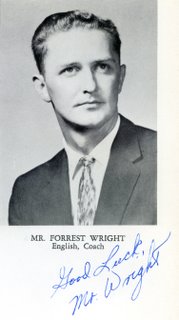
The alumni of St. Edward's High School in Austin, Texas (from 1925 until 1975 the last year when the school closed but the adjacent St. Edward's University continued to the present day) is gearing up for a mass reunion (those of us who are alive and willing) in June. For more info on this for any Edwardian Tiger that might lurk in this blog click here.
I have written at length and several times on my good years at the school. And in particular I have written of my teachers who with a few exceptions were Brothers of the Congregation of the Holy Cross. I have written about them here, here and here.
But today I will write about a man who was not a Brother of the Holy Cross. Forrest Wright taught us civics, English and was the baseball coach of our team that won many state championships under his leadership. He was mostly a serious man. He had very red hair and when he got angry his face would turn the same colour. He was a perfectionist. He had a penchant for slacks with crisp, just-ironed creases and black cordovan leather shoes. I was just a tad afraid of him. There is no doubt that I respected him as much as I have any other man that earned my respect.
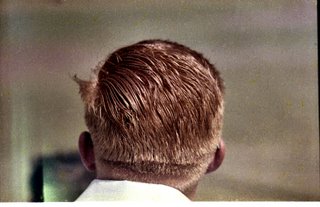
In these pages I have written about being an Argentine, Mexican, Canadian, and an American. I have even written about feeling much like a Texan.
Of late as I read about Obama (Rosemary and I were always glued on election night and on the debates) I feel very American. I have been reminiscing a lot of my four years in Texas.

Today I looked into my 1961 (my graduating year) Edwardian year book. The year book (our class yearbook, my yearbook) is dedicated to President John F. Kennedy. The dedication reads:
The students of Saint Edward's High School are proud to make their Edwardian dedication to the First Man of the Land; to one who has been brought up in the same traditions of Democracy as they; to one who has made real and concrete faith in the American ideal that equality of person is the basis for American Democracy; to one who has won his office through public "trial" on the most important issues which have ever faced the Commander-in-Chief of our country; to one who has the fire of the Founding Father, the knowledge of things present based on things past, the enthusiasm and vigor of the young-in-heart, the determination of a man who must prove himself, the faith, the humility and charity of a Christian -- the President of the United States, John F. Kennedy.
The Students of Saint Edward's High School
I must not have given much thought to that page and the contents in 1961 but today as I write this I am moved by the dedication and a realization that I still feel that Kennedy was my president simply because I was an American. Perhaps it has all to do with Forrest Wright. He taught me English and he taught me to write. But he also taught me civics. Some of his classes introduced us to such mundane differences that exist between a misdemeanor and a felony with the subsequent months or years of incarceration that each came with. He taught us the difference between first and second degree murder and all about habeas corpus. Wright taught us about the American Constitution and how politics in the US worked with caucuses and primaries. I remember how he gesticulated with the thumb and index finger of his right hand to make a point. In combination with Brother Francis's class of American history I learned quite a lot (and well) about the United States. Both men taught me pride in the concept of democracy and our ability to put faith in the system.

Forty seven years later with the nearness of Barack Obama's inauguration I find that I don't seem to feel less proud, less hopeful or less American even though I am really an Argentine with a love for Mexico, Texas and Canada.
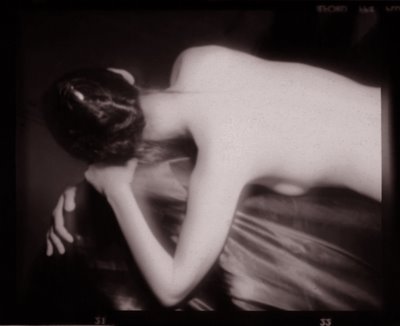
In 1965 in Buenos Aires I went with Susy to see a film I will never forget. I saw it once. Susy was out to educate me and mold me to her desire that I be cultured. She took me to see my first two operas at the Teatro Colón, Sergei Prokofiev's Fiery Angel and Christoph Willibald Gluck's Orfeo ed Uridice. She especially wanted to break my love for westerns and war films. She said I was uncouth. She wanted me to appreciate European art films. My previous experience had not been a good one. I had seen most of Michelangelo Antonioni films because I had the hots for Monica Viti not because I understood the Italian cinematographer's art.
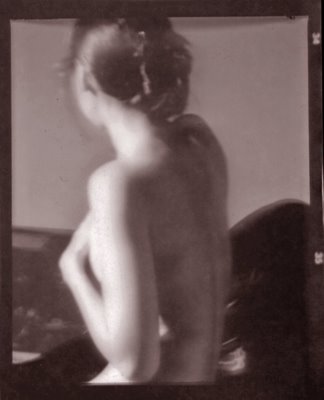
The film I saw with Susy was Hiroshi Teshigahara's 1964 The Woman in the Dunes or Suna no Onna. It was a beautifully startling film. It was as erotic as film as I have ever seen. This film has remained fused in my memory like a bad sunburn at the beach at the end of a hot summer day. No matter where I have gone since, I look at sand in a way I had never had before. I had never seen a film where you could hear (or was it my imagination?) the falling of individual grains of sand.
Sand: An aggregate of rock fragments. Sometimes Including loadstone, tinstone, and more rarely gold dust. Diameter: 2 to 1/16 mm.
The Woman In The Dunes - Kobo Abé

In The Woman in the Dunes the woman was the sexual agressor. It didn't quite hit me then how unlikely this was coming from a then very conservative and male-oriented Japanese society.
He started toward the container on the earthen floor for a little water. Suddenly he heard the breathing of the sleeping woman on the other side of the sunken hearth and looked over. He swallowed his breath, quite forgetting the aching of his eyelids. She was stark naked.

She seemed to float like a blurred shadow before his tear filled eyes. She lay face up on the matting, her whole body, except her head, exposed to view; she had placed her left hand lightly over her lower abdomen, which was smooth and full. The parts that one usually covered were completely bare, while the face, which anybody would show, was concealed under a towel. No doubt the towel was to protect her nose, mouth and eyes from the sand, but the contrast seemed to make the naked body stand out even more.
The Woman In The Dunes - Kobo Abé

In this film sand pours and is in everything. Watching the protagonists drink made me want to drink. I could feel the grit of the sand that was present in everything, in their food, in their drink, in their eyes, in their cavities.
She gathered up the towel with a nervous gesture, and with unexpected energy slapped her face with it two or three times and then, completely turning her back to him, crouched with her knees doubled beneath her and her face to the floor. Was it a bashful movement? This was hardly the place. The man let out a shout as if a dam had given way.
The Woman In The Dunes - Kobo Abé

Halfway through he film I could guess what the man, amateur entomologist Nikei Jumpei already knew. He was in a sandpit with a woman and he would never be able to escape- a Sisyphus, eternally at the bottom of a hole. No great stone to push up just grains with little variations that follow a Gaussian distribution curve with a true mean of 1/8mm.
Then there was a small avalanche of sand.
Apprehensively, he returned to the hut. He went directly to the woman, who had remained crouching. He raised his left hand threateningly. His eyes glittered as he stood there agonizing. But halfway through the gesture, his arm, which he had raised with such purpose, suddenly collapsed. Perhaps he would feel better if he slapped the naked woman. But wouldn't this be just the part he was expected to play? She was waiting for it. Punishment inflicted, in other words, would mean that the crime had been paid for.
The Woman In The Dunes - Kobo Abé

For several years I photographed Helen Yagi. The pictures here I took with my Mamiya RB modified to be a pinhole camera. Looking back I can understand now that Helen was the best subject I ever had and that any limitations that I may have felt in taking her photographs were my own personal limitations. When she found out about my love for the film The Woman in The Dunes she said, "Alex why don't we bring bucketfulls of sand up to your studio and shoot scenes from the film?" I thought, at the time that Helen was crazy. How were we going to cart all that sand up three floors and then get rid of it? Of course she was not crazy at all. I simply could not see. Just like Nikei Jumpei, I had no vision at the bottom of my sandpit.

A few days ago while browsing through the fiction section at Chapters I found Kobo Abé's The Woman in the Dunes translated by E. Dale Saunders and illustrated by Machi Abé. It is a Vintage International edition, 1991.
more
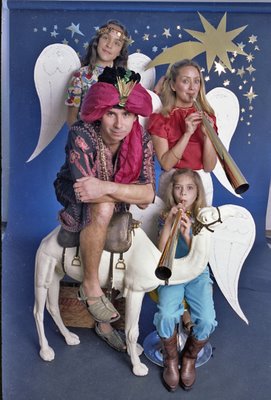
At least twice by the end of 2008 I wrote about melancholy, here and here. While much of that melancholy was dissipated by Christmas cheer it is back in full force as I contemplate on my Christmas tree on January 6, the Epiphany or as we know it in Latin America Los Tres Reyes Magos. I wrote about my personal relevance to the Epiphany here.
Even though I was 11 years old at my last Argentine Tres Reyes, the lazy and hot summer days and my being sent to some remote "camp" (as Anglo Argentines call the campo or pampa) , a place with a smooth, uninterrupted horizon and being forced (a good thing even though I was not aware then) to learn to make friends with people I had never met before.
The melting snow outside cannot cool the feeling of warmth and nostalgia that I have for the Epiphany and the terrible (then) gifts of useless wooden toys that Eva Perón gave us on that day when all I wanted was an Erector set or an electric train.
Part of the allure is in the Spanish meaning of mago. A mago in Spanish is a magician. The three wise kings, los tres reyes magos, were magicians to us. All was possible if they intervened. I thought then that the little box of myrrh probably also contained a pristine white rabbit ready to jump out and delight the precocious newborn in that stable crib.
And of course that melancholy is further increased by having to remove the ornaments from the tree which we traditionally perform tomorrow. It's been up for what seems only a few days. But the tree has become my friend. Every time I come into the living room to write my blog I can smell with delight the scent of my Pseudotsuga menziesii or Douglas Fir.
But some of that melancholy has vanished as I found this picture which was our Christmas card for 1981. I took the picture in our Burnaby basement in November 1981 so Hilary (below, right) was 9 and Ale was 13. Our basement had a very low ceiling so I was forced to use a wide angle lens which made people in front look bigger than those in the front. That the whole family was present for Christmas Eve dinner 27 years later has to be something that even makes this melancholy man smile, if only for a short while.

The alumni of St. Edward's High School in Austin, Texas (from 1925 until 1975 the last year when the school closed but the adjacent St. Edward's University continued to the present day) is gearing up for a mass reunion (those of us who are alive and willing) in June. For more info on this for any Edwardian Tiger that might lurk in this blog click here.
I have written at length and several times on my good years at the school. And in particular I have written of my teachers who with a few exceptions were Brothers of the Congregation of the Holy Cross. I have written about them here, here and here.
But today I will write about a man who was not a Brother of the Holy Cross. Forrest Wright taught us civics, English and was the baseball coach of our team that won many state championships under his leadership. He was mostly a serious man. He had very red hair and when he got angry his face would turn the same colour. He was a perfectionist. He had a penchant for slacks with crisp, just-ironed creases and black cordovan leather shoes. I was just a tad afraid of him. There is no doubt that I respected him as much as I have any other man that earned my respect.

In these pages I have written about being an Argentine, Mexican, Canadian, and an American. I have even written about feeling much like a Texan.
Of late as I read about Obama (Rosemary and I were always glued on election night and on the debates) I feel very American. I have been reminiscing a lot of my four years in Texas.

Today I looked into my 1961 (my graduating year) Edwardian year book. The year book (our class yearbook, my yearbook) is dedicated to President John F. Kennedy. The dedication reads:
The students of Saint Edward's High School are proud to make their Edwardian dedication to the First Man of the Land; to one who has been brought up in the same traditions of Democracy as they; to one who has made real and concrete faith in the American ideal that equality of person is the basis for American Democracy; to one who has won his office through public "trial" on the most important issues which have ever faced the Commander-in-Chief of our country; to one who has the fire of the Founding Father, the knowledge of things present based on things past, the enthusiasm and vigor of the young-in-heart, the determination of a man who must prove himself, the faith, the humility and charity of a Christian -- the President of the United States, John F. Kennedy.
The Students of Saint Edward's High School
I must not have given much thought to that page and the contents in 1961 but today as I write this I am moved by the dedication and a realization that I still feel that Kennedy was my president simply because I was an American. Perhaps it has all to do with Forrest Wright. He taught me English and he taught me to write. But he also taught me civics. Some of his classes introduced us to such mundane differences that exist between a misdemeanor and a felony with the subsequent months or years of incarceration that each came with. He taught us the difference between first and second degree murder and all about habeas corpus. Wright taught us about the American Constitution and how politics in the US worked with caucuses and primaries. I remember how he gesticulated with the thumb and index finger of his right hand to make a point. In combination with Brother Francis's class of American history I learned quite a lot (and well) about the United States. Both men taught me pride in the concept of democracy and our ability to put faith in the system.

Forty seven years later with the nearness of Barack Obama's inauguration I find that I don't seem to feel less proud, less hopeful or less American even though I am really an Argentine with a love for Mexico, Texas and Canada.
Suna no Onna
Wednesday, January 07, 2009

In 1965 in Buenos Aires I went with Susy to see a film I will never forget. I saw it once. Susy was out to educate me and mold me to her desire that I be cultured. She took me to see my first two operas at the Teatro Colón, Sergei Prokofiev's Fiery Angel and Christoph Willibald Gluck's Orfeo ed Uridice. She especially wanted to break my love for westerns and war films. She said I was uncouth. She wanted me to appreciate European art films. My previous experience had not been a good one. I had seen most of Michelangelo Antonioni films because I had the hots for Monica Viti not because I understood the Italian cinematographer's art.

The film I saw with Susy was Hiroshi Teshigahara's 1964 The Woman in the Dunes or Suna no Onna. It was a beautifully startling film. It was as erotic as film as I have ever seen. This film has remained fused in my memory like a bad sunburn at the beach at the end of a hot summer day. No matter where I have gone since, I look at sand in a way I had never had before. I had never seen a film where you could hear (or was it my imagination?) the falling of individual grains of sand.
Sand: An aggregate of rock fragments. Sometimes Including loadstone, tinstone, and more rarely gold dust. Diameter: 2 to 1/16 mm.
The Woman In The Dunes - Kobo Abé

In The Woman in the Dunes the woman was the sexual agressor. It didn't quite hit me then how unlikely this was coming from a then very conservative and male-oriented Japanese society.
He started toward the container on the earthen floor for a little water. Suddenly he heard the breathing of the sleeping woman on the other side of the sunken hearth and looked over. He swallowed his breath, quite forgetting the aching of his eyelids. She was stark naked.

She seemed to float like a blurred shadow before his tear filled eyes. She lay face up on the matting, her whole body, except her head, exposed to view; she had placed her left hand lightly over her lower abdomen, which was smooth and full. The parts that one usually covered were completely bare, while the face, which anybody would show, was concealed under a towel. No doubt the towel was to protect her nose, mouth and eyes from the sand, but the contrast seemed to make the naked body stand out even more.
The Woman In The Dunes - Kobo Abé

In this film sand pours and is in everything. Watching the protagonists drink made me want to drink. I could feel the grit of the sand that was present in everything, in their food, in their drink, in their eyes, in their cavities.
She gathered up the towel with a nervous gesture, and with unexpected energy slapped her face with it two or three times and then, completely turning her back to him, crouched with her knees doubled beneath her and her face to the floor. Was it a bashful movement? This was hardly the place. The man let out a shout as if a dam had given way.
The Woman In The Dunes - Kobo Abé

Halfway through he film I could guess what the man, amateur entomologist Nikei Jumpei already knew. He was in a sandpit with a woman and he would never be able to escape- a Sisyphus, eternally at the bottom of a hole. No great stone to push up just grains with little variations that follow a Gaussian distribution curve with a true mean of 1/8mm.
Then there was a small avalanche of sand.
Apprehensively, he returned to the hut. He went directly to the woman, who had remained crouching. He raised his left hand threateningly. His eyes glittered as he stood there agonizing. But halfway through the gesture, his arm, which he had raised with such purpose, suddenly collapsed. Perhaps he would feel better if he slapped the naked woman. But wouldn't this be just the part he was expected to play? She was waiting for it. Punishment inflicted, in other words, would mean that the crime had been paid for.
The Woman In The Dunes - Kobo Abé

For several years I photographed Helen Yagi. The pictures here I took with my Mamiya RB modified to be a pinhole camera. Looking back I can understand now that Helen was the best subject I ever had and that any limitations that I may have felt in taking her photographs were my own personal limitations. When she found out about my love for the film The Woman in The Dunes she said, "Alex why don't we bring bucketfulls of sand up to your studio and shoot scenes from the film?" I thought, at the time that Helen was crazy. How were we going to cart all that sand up three floors and then get rid of it? Of course she was not crazy at all. I simply could not see. Just like Nikei Jumpei, I had no vision at the bottom of my sandpit.

A few days ago while browsing through the fiction section at Chapters I found Kobo Abé's The Woman in the Dunes translated by E. Dale Saunders and illustrated by Machi Abé. It is a Vintage International edition, 1991.
more
One Wise King - Not
Tuesday, January 06, 2009

At least twice by the end of 2008 I wrote about melancholy, here and here. While much of that melancholy was dissipated by Christmas cheer it is back in full force as I contemplate on my Christmas tree on January 6, the Epiphany or as we know it in Latin America Los Tres Reyes Magos. I wrote about my personal relevance to the Epiphany here.
Even though I was 11 years old at my last Argentine Tres Reyes, the lazy and hot summer days and my being sent to some remote "camp" (as Anglo Argentines call the campo or pampa) , a place with a smooth, uninterrupted horizon and being forced (a good thing even though I was not aware then) to learn to make friends with people I had never met before.
The melting snow outside cannot cool the feeling of warmth and nostalgia that I have for the Epiphany and the terrible (then) gifts of useless wooden toys that Eva Perón gave us on that day when all I wanted was an Erector set or an electric train.
Part of the allure is in the Spanish meaning of mago. A mago in Spanish is a magician. The three wise kings, los tres reyes magos, were magicians to us. All was possible if they intervened. I thought then that the little box of myrrh probably also contained a pristine white rabbit ready to jump out and delight the precocious newborn in that stable crib.
And of course that melancholy is further increased by having to remove the ornaments from the tree which we traditionally perform tomorrow. It's been up for what seems only a few days. But the tree has become my friend. Every time I come into the living room to write my blog I can smell with delight the scent of my Pseudotsuga menziesii or Douglas Fir.
But some of that melancholy has vanished as I found this picture which was our Christmas card for 1981. I took the picture in our Burnaby basement in November 1981 so Hilary (below, right) was 9 and Ale was 13. Our basement had a very low ceiling so I was forced to use a wide angle lens which made people in front look bigger than those in the front. That the whole family was present for Christmas Eve dinner 27 years later has to be something that even makes this melancholy man smile, if only for a short while.
Monday, January 05, 2009
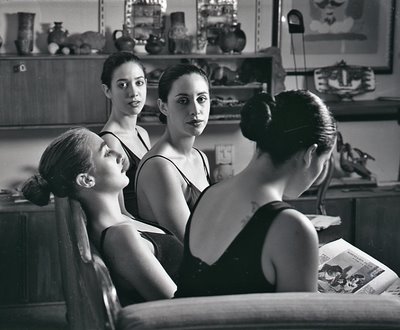
I faced these four lovely sisters only once and I barely rose to the occasion with these snapshots. Since then I regret not having put more effort into the opportunity. I have discovered a beautiful essay on the little black dress in a blog from Oviedo Spain. The link is under the heading to this blog. It is in Spanish, alas! One expression caught my eye, El Ford de Chanel which is all on how Ford's Model T came only in basic black. Any essay on the little black dress that mentions Tippi Hedren, Kim Novak and Grace Kelly already has something going for it!
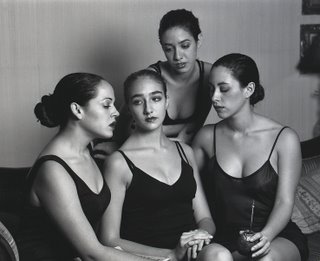
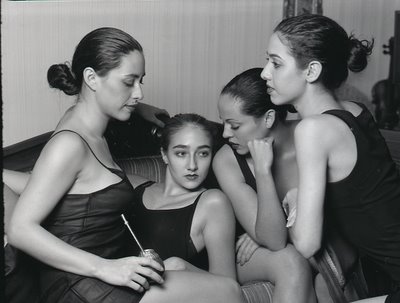
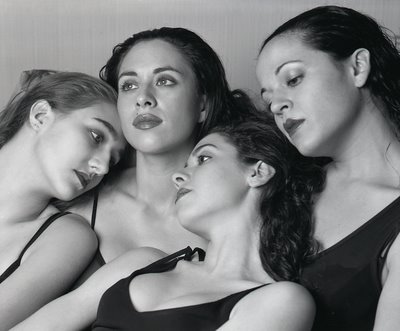
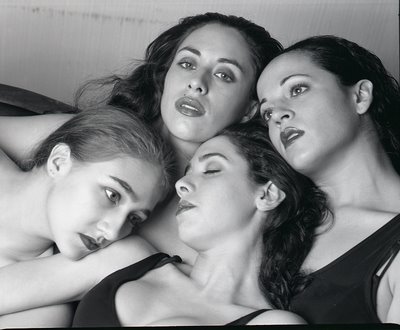
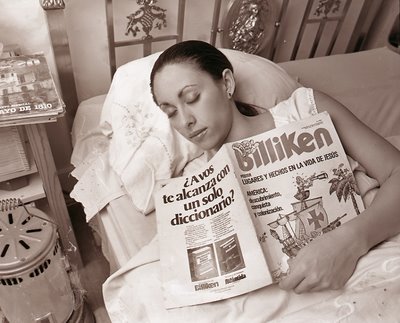
This is publisher Faber & Faber's short biography of writer Stefan Kanfer:
Stefan Kanfer
Stefan Kanfer’s books include The Eighth Sin, A Summer World, The Last Empire, Serious Business, Groucho, Ball of Fire and Stardust Lost. He was a writer and editor at Time for more than twenty years and was their first bylined film critic, a post he held from 1967 until 1972. A Literary Lion of the New York Public Library and recipient of numerous writing awards, Kanfer is currently in the Distinguished Writer Program at Southampton College, Long Island University. He divides his time between New York and Cape Cod.
There are numerous reviews of Kanfer's latest book, a biography of Marlon Brando called Somebody - The Reckless Life and Remarkable Career of Marlon Brando.
I will probably buy it as I have been very close to Stefan Kanfer even though I have never met him nor communicated with him.
It was around 1964 that I discovered Time Magazine. I was young and not cynical. I had yet to hear, "Life Magazine for the people who cannot read - Time Magazine for the people who cannot read." I did not yet know on how newspapers and magazines could bend the truth. I had been a little boy around 8 when I had some doubts about the existence of Santa Claus. When I saw a picture of St Nicholas Bishop of Myra in the Argentine children's magazine Billiken saying he was Santa Claus my doubts about his existence were erased. If Billiken said he existed he must exist.
While in Argentina in the middle 60s I made it a point to read Time every week. Every once in a while I would not be able to find it. This usually happened when some Argentine general did not like what Time had said about the military government. It was around 1965 that I remember sitting in a park bench of the Buenos Aires zoo that I read a wonderful film review. It was credited to a Stefan Kanfer. I soon found myself being able to identify the man's style in the first sentence of any paragraph of any essay Kanfer wrote. It was with Kanfer that I first discovered that there was such a thing as literary style. Through the years I have discovered the inimitable Jerome Charyn in English and José Saramago in Spanish translated from the Portuguese. I love reading Maureen Dowd in the NY Times as she shares a stylistic flair with Charyn. While reading the review of Kanfer's new book on Marlon Brando in today's NY Times I spotted this:
On the night "A Streetcar Named Desire" opened on Broadway, Tennessee Williams sent his young leading man a rapturous telegram: "From the greasy Polack you will someday arrive at the gloomy Dane for you have something that makes the theater a world of great possibilities."
Looking back at that statement, Brando's line in On The Waterfront as Terry the washed up boxer:
You don't understand. I coulda had class. I coulda been a contender. I coulda been somebody, instead of a bum, which is what I am, let's face it. It was you, Charley
has a special resonance as Brando's path towards Shakespeare never went past his role as Marc Anthony.
All that brings me to the theme of today's latish blog (a difference of opinion with my web server, Net Nation made them pull the plug for almost a day) which is all about the strange and wonderful topic of potential energy. A block of wood sitting without movement on a table has the potential of moving should a rapid wind suddenly come on the scene. Or it could be something as simple as tilting the table and then the block would be freed of some of the friction and gravity and perhaps slide downward a bit. Or magic could suddenly remove the table and gravitational pull would make the block fall. There is even energy stored in the block of wood in the form of the heat it could provide if we were to throw it into a small fire.
Kinetic energy is physics’ way of defining the potential of everything that surrounds us and even ourselves. I think of potential energy when I think of my mother receiving a scholarship to study in the medical school of Johns Hopkins and not being able to take advantage because even though she had been born in Manila under American occupation she was deemed an alien Asian and barred from entering the US as a student. I think of my own potential as an engineer had I figured out the difference between capacitance and inductance before failing electricity.
Somehow because of not being able to go to Johns Hopkins my mother went to Argentina and married my father and I am here writing this.
I almost despair at the fact that my Rebecca was offered a full scholarship to attend a very good dance school but her parents turned it down. They don't want Rebecca to be a ballerina or a dancer. What potential is in this little 11 year old girl? Will I be around to see it realized?
I don't know except to note that potential energy, potential human energy, keeps our dreams alive and our will to live.

I last saw Lee Lytton when we both graduated from St Ed's High School in 196l. It was only a couple of weeks ago that I finally located him and the emails have been going back and forth fast and furious. In his last email Lee wrote this:
I'm still trying to patch together some things about your early history so that I can fit what I remember about you from almost 50 years ago into my recollections. I hope I'm not getting too personal, but I'm operating under the assumption that since your blogs are remarkably uninhibited and about as open a window into your past as I can imagine, you don't mind filling in a few more gaps.
January 20th will mark the third year that I have posted a blog every day. At first I had no idea what blogging was all about. It took a while to figure out the mechanics of fitting pictures with copy. It was my eldest daughter Ale (40) who about a year and a half ago told me, "Papi I was sometimes afraid to ask you about your past and our family. Now, thanks to your blog it is all there." I really appreciated that as it gave me at least one goal. It is a goal that is similar to Rosemary asking my mother to write in white ink under the old photographs of our family albums. They are pasted with black corners on black paper. My mother's neat handwriting (a nun's school in Manila) will keep the people in the pictures alive for a few more generations until distance takes its toll and memory fades.
This blog which is part of Blogger (purchased by Google some years ago) means that when people that I mention Google themselves, more often than not they find me. And this is how I find them. My blog has helped me as well as Lee to fit gaps in my memory of the people that have passed through my life. These people remind me of the experience of leaving in a train from Retiro Station in Buenos Aires. Sometimes our train left the platform as the same time as another. Both would follow parallel tracks but sooner or later one would give way or we would reach a fork where each train would bifurcate in an opposite direction. Lee and I were together for four years but we weren't really friends. I was much younger for my years while Lee was less shy and as soon as he got rid of his thick glasses he became popular with the girls. I had my glasses for the duration and I preceded the computer geeks in looks even though my interest lay in 4inch reflector telescopes and photographs of Lokheed F-104 Starfighters. But I do remember being in the back seat of Lee's 56 or 57 convertible Chevy in our last year. It was a thrill. To me Lee was the type who would write essays about women, cocktails and style for Esquire. That was not the case as he decided to become a prestigious professor of law.
I am a bit taken aback by Lee's statement, "your blogs are remarkably uninhibited and about as open a window into your past as I can imagine..." His statement will not prevent me from trying to answer all his questions. But it does make me think that if Lee and I played poker I would lose my shirt in no time. These West Texans can keep their cards real close to their chest. Perhaps he is right. My wife Rosemary does not have an have an opinion as she has made it a point not to read my blogs. The only one who has protested about my candid approach has been Rebecca who says I reveal all her faults to the world. She says I embarrass her all the time, and has stictly prohibited me from telling anybody, especially in this blog that she is interested in boys and in one in particular. So I will avoid that subject.
But it really has been Rebecca and my relationship with her as her grandfather and friend who has been the focus of most of my thoughts here.

Of late it has been all about my sadness of seeing her grow up and becoming far less moldable to my wishes. She is becoming literally her own woman at 11. Just two days ago she informed that she will no longer "mope" for any of the pictures I take of her. She plans to smile.
Today Lauren (6) spent the day with us and is sleeping over. Rosemary read to her. We had a leasurely dinner. At the table she said, "It is nice not to have Rebecca with us now. She is not shouting at you Papi. It is quiet." Perhaps it is time to let go, just a bit, of Rebecca and take advantage while Lauren is still some years away from the distraction of boys, iPods and video games.

But I will not forget nor can I forget that without Rebecca in my life my blog would have never gone past a few months. Thank you.

Warning. A good measure of pontification follows.
The last days between Christmas and New Year's have always been lazy days of introspection and reflection. At this time, time, more than ever before in my life, I have been thinking about how our changing times are not ordinary changing times.
In the 50s and 60s American cars thrived on the idea that one year's model would be completely different from a previous year's. Inside, most of these cars were all the same. The technology was simple, almost crude. Newness was associated with the shape of grills and the height of a tail fin. I read ads about the "all new" 2009 Audi A-4 and noted that the outside is not all that different from our own two year old Audi A-4. Chances are, that mechanically our car and the new one are very different under that pretty Germanic skin of steel.
At one time cars were vehicles that took one and perhaps a few more from point A to point B. Versions of it were used for killing as was the WWI tank or a WWII Jeep with a mounted .50 caliber machine gun. I remember so well a copy of a 1943 Life Magazine that featured an ad for Buick that read, "Our Sherman tank features a Buick Dynaflow transmission."
During this time telephones were for communication between considerable distances or from one side of a city to another. Typewriters were for typing novels, personal letters, job applications, recording births and deaths or sending you to jail for an eventual and terminal execution (if you happened to be a murderer).
That period of our world (slowly breaking up now) had been determined really by one man, Johannes Gutenberg in the 15th century. His bible and the printed books that followed established an order of things related to a beginning and an end. This linearity brought into being the preface, the index, the bibliography and footnotes. To this day some Spanish (who have their own idea of linearity) books have the índice at the end!
This linearity has also imposed a logic that things have a purpose and one purpose only. The hammer you see here might be used for hammering nails, for removing them and in a pinch (if carefully wrapped in a rag) to firm up a rickety chair. The screwdriver on the right is a pretty modern version of it as inside the handle are all kinds of variations on the original one used for tightening and loosening screws. But it doesn't take too much imagination to think that the screwdriver could be used for making holes in a spring garden and to drop seeds in them.
It took precocious teen agers (as soon as they could borrow dad's) that cars could be used for the privacy of illicit sex. It didn't take long for bank robbers to realize that a car was a far better method of getting away from the bank than a horse.
For me the two most important events of the 20th century were the contraceptive pill and the photograph of our earth hovering on the horizon of the moon taken by Apollo 8 astronaut Bill Anders in 1968. At last we could point down and say, "We are from there." And the former, the pill, more than the "death of God" did away with most of the morality and the imposed shackling of women in their quarters which is central to just about every religion.
Perhaps in this century the breaking up of linearity will be the most important event. An inkling of this came with Argentine author Julio Cortázar's 1963 novel Rayuela (Hopscotch) which could be read logically from beginning to end but the author also had some non linear suggestions that involved skipping chapters randomly. I would predict here without any doubt that in an extremely near future the Amazon Kindle will feature not only an on line dictionary but also hypertext. This means that a Scheherazade of the future will be able to keep her Persian king interested far more than those one thousand and one nights. In a soon-to-be released science fiction version of this book by Chip Gibson, the story will never end and will only be able to be published by Borges's infinite library.
All the above blabber came to mind today after going to a new year's day at home at a friend's house. My friend does undisclosed work (not secret simply way over my head) at Sun Microsystems. Many of his guests were software engineers. One of them, Philip, had been a physicist before until he (a very smart man) saw were things were going to. "Physics and most of the sciences need funding," and it was obvious Philip was not going to wait or depend on that to promote his career.
He asked me if I remembered the old and primitive word processors. I told him I still had one although Word and my PC have replaced my Smith Corona PWP 40. "The problem with that device, is that its creators were still stuck on the idea of a typewriter and the little screen (about 3 inches wide). Phillip then ended the conversation with the buzz expression, "The end product has to be optimized."

Another of the cyber engineers told me that he no longer considered himself a programmer as he found it frustrating that most programs required more than one thousand words to work. "I am looking for an under 1000 word solution." Then while he was talking to someone else I heard him say, "A cathedral."
Most of those Gothic cathedrals were built before Gutenberg. The secret as to how they were built was not written down but lay in the minds of the masons who built them. The secrets were passed from one generation of masons to the next. As soon as engineering, architecture, law and medicine became a science the secrets could only be seen and understood in colleges and universities. Along with musicians who could read music these arts and professions became understandable only by those with the intellect to study. The rest of us were left out. The Masonic order now includes those cyber engineers that enable us to live our life, or not, with programs that they alone understand but programs we must absolutely must have.
Many of these programs are applications, a new buzzword that is now shortened to apps. Consider that since July Apple has posted more than 10,000 programs to its App Store. The most popular of them (it costs $0.99) lets the phone simulate the sound of flatulence.
While I believe that the real inventor of multitasking is old-fashioned Man, I can see that idea that a screwdriver could be used to plant seeds is about as primitive and idea as telling Alexander Graham Bell that his invention would enable people to talk to each other, nothing less and nothing more. If I told them that there is also an app called Sapus Tongue in which the user swings the phone to see how far he can fling an animated monkey on the screen he would probably change the subject to, "Who's that gorgeous woman at the Smith Corona PWP 40?"
My Audiovox Model CDM-8100PPP phone will not fling monkeys nor produce artificial flatulence. It is capable of getting and sending email but I have never bothered to use that feature. I use my Audiovox to talk to people.
More
And more
And even more
And more again
And more
And a bit more
And more
More?
And the last one
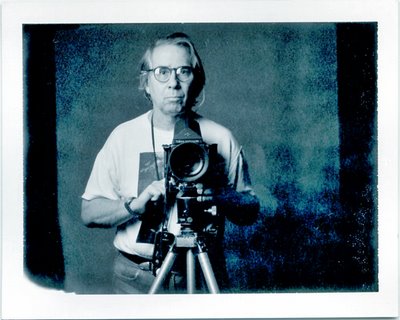
I have written here before of my Filipino heritage. My mother was born in Manila. Some of our relatives are Filipino/Chinese with the surname Roxas. One of them, Manuel Roxas was the first president of the Philippines in 1946. My grandmother would often talk to my mother in Tagalog in my presence when I was a little boy to keep their conversations private. They knew I had a keen ear. By some osmosis of sorts I managed to learn some Tagalog and in particular the words that are useful.
In Vancouver we are lucky to have the Goldilocks bakery (Broadway at Fir) which features not only Filipino breads, cakes, desserts and food but such wonderful stuff as Magnolia macapuno ice cream. This is a coconut ice cream made from a sport of the coconut palm (some say it is a disease) harvested, primarily in the Philippines. They are sold in jars as "gelatinous mutant coconut" cut into balls or strands. In a macapuno coconut the water and the meat do not separate and they are one gelatinous mass. These coconuts are thrown away just about anywhere else. I have prevented Mexicans boys serving me an ice cold coconut at beaches in Acapulco, Veracruz and Isla Mujeres from throwing my chosen fruit away when they saw the nasty looking gelatine inside. It is delicious. My uncle Don Luís Miranda who worked for San Miguel Beer and Magnolia created the macapuno ice cream flavour. It is straight from heaven.
At Goldilocks I like to purchase Filipino shortbread called polvorones and a wonderful puffy bread called ensaymadas (from Spain via the Philippines). At Goldilocks the procedure is to place your order on a small sheet of paper with a small pencil that is provided (did Lee Valley copy them?). When I first started going to Goldilocks I would write Suput as my name. When my paper was picked there was a lot of stammering and or silence involved when the women behind the counters (they wear hair nets) tried to figure out who the male of the species responsible for the joke was.
In late 1967, shortly before I married Rosemary, I lived in Mexico City with an urbane Filipino, Raúl Guerrero Montemayor (first cousin to Ivette Mimiuex). Raúl is godfather to my youngest daughter Hilary. One of Raúl's friends, Nonong, was the playboyish son of Manuel L Quezon the first Filipino president of the Commonwealth of the Philippines under U.S. occupation rule in the early period of the 20th century. We became friends and he gave me the nickname of Suput. Even my eldest daughter's godfather, my Yorkshire-born friend Andrew Taylor calls me by that nickname to this day.
Now in Tagalog suput means literally tight but it also means uncircumcised. In a country that has been mostly Catholiic since Magellan but also Muslim, to be suput is to be unclean. It is a serious Filipino insult. You can imagine what goes through the minds of the Filipina women with their hairnets when they see my nickname. They know me now so they just giggle when they see me and ask me what I want. They have another nickname for me, Andong, which is a much cleaner and it is a re-working of Alexander.
Since I was raised as a Catholic and I went to a very good Catholic school, St. Edward's in Austin, Texas I know that today is the Feast of the Circumcision. It is a feast that is fairly low in the order of Catholic feasts. A much more important feast is the one that falls on January 6. At the Epiphany, the visit by the Magi on the infant Jesus has a tremendous symbolic and religious importance. God had made an exclusive contract with the Israelites of the Old Testament. By the simple act of having the Magi (no matter how regal they might have been they were still unclean, uncircumcised heathens) visit the manger it represented a new order of things, the New Testament. Not only the Israelites but all baptized mankind (the males could be either circumcised or not) now had the opportunity to sit on the right hand of God in heaven.
The heathen above is a self portrait taken mid December 2008 with b+w Polaroid.

I faced these four lovely sisters only once and I barely rose to the occasion with these snapshots. Since then I regret not having put more effort into the opportunity. I have discovered a beautiful essay on the little black dress in a blog from Oviedo Spain. The link is under the heading to this blog. It is in Spanish, alas! One expression caught my eye, El Ford de Chanel which is all on how Ford's Model T came only in basic black. Any essay on the little black dress that mentions Tippi Hedren, Kim Novak and Grace Kelly already has something going for it!




Billiken, Potential Energy & Kanfer's Brando
Sunday, January 04, 2009

This is publisher Faber & Faber's short biography of writer Stefan Kanfer:
Stefan Kanfer
Stefan Kanfer’s books include The Eighth Sin, A Summer World, The Last Empire, Serious Business, Groucho, Ball of Fire and Stardust Lost. He was a writer and editor at Time for more than twenty years and was their first bylined film critic, a post he held from 1967 until 1972. A Literary Lion of the New York Public Library and recipient of numerous writing awards, Kanfer is currently in the Distinguished Writer Program at Southampton College, Long Island University. He divides his time between New York and Cape Cod.
There are numerous reviews of Kanfer's latest book, a biography of Marlon Brando called Somebody - The Reckless Life and Remarkable Career of Marlon Brando.
I will probably buy it as I have been very close to Stefan Kanfer even though I have never met him nor communicated with him.
It was around 1964 that I discovered Time Magazine. I was young and not cynical. I had yet to hear, "Life Magazine for the people who cannot read - Time Magazine for the people who cannot read." I did not yet know on how newspapers and magazines could bend the truth. I had been a little boy around 8 when I had some doubts about the existence of Santa Claus. When I saw a picture of St Nicholas Bishop of Myra in the Argentine children's magazine Billiken saying he was Santa Claus my doubts about his existence were erased. If Billiken said he existed he must exist.
While in Argentina in the middle 60s I made it a point to read Time every week. Every once in a while I would not be able to find it. This usually happened when some Argentine general did not like what Time had said about the military government. It was around 1965 that I remember sitting in a park bench of the Buenos Aires zoo that I read a wonderful film review. It was credited to a Stefan Kanfer. I soon found myself being able to identify the man's style in the first sentence of any paragraph of any essay Kanfer wrote. It was with Kanfer that I first discovered that there was such a thing as literary style. Through the years I have discovered the inimitable Jerome Charyn in English and José Saramago in Spanish translated from the Portuguese. I love reading Maureen Dowd in the NY Times as she shares a stylistic flair with Charyn. While reading the review of Kanfer's new book on Marlon Brando in today's NY Times I spotted this:
On the night "A Streetcar Named Desire" opened on Broadway, Tennessee Williams sent his young leading man a rapturous telegram: "From the greasy Polack you will someday arrive at the gloomy Dane for you have something that makes the theater a world of great possibilities."
Looking back at that statement, Brando's line in On The Waterfront as Terry the washed up boxer:
You don't understand. I coulda had class. I coulda been a contender. I coulda been somebody, instead of a bum, which is what I am, let's face it. It was you, Charley
has a special resonance as Brando's path towards Shakespeare never went past his role as Marc Anthony.
All that brings me to the theme of today's latish blog (a difference of opinion with my web server, Net Nation made them pull the plug for almost a day) which is all about the strange and wonderful topic of potential energy. A block of wood sitting without movement on a table has the potential of moving should a rapid wind suddenly come on the scene. Or it could be something as simple as tilting the table and then the block would be freed of some of the friction and gravity and perhaps slide downward a bit. Or magic could suddenly remove the table and gravitational pull would make the block fall. There is even energy stored in the block of wood in the form of the heat it could provide if we were to throw it into a small fire.
Kinetic energy is physics’ way of defining the potential of everything that surrounds us and even ourselves. I think of potential energy when I think of my mother receiving a scholarship to study in the medical school of Johns Hopkins and not being able to take advantage because even though she had been born in Manila under American occupation she was deemed an alien Asian and barred from entering the US as a student. I think of my own potential as an engineer had I figured out the difference between capacitance and inductance before failing electricity.
Somehow because of not being able to go to Johns Hopkins my mother went to Argentina and married my father and I am here writing this.
I almost despair at the fact that my Rebecca was offered a full scholarship to attend a very good dance school but her parents turned it down. They don't want Rebecca to be a ballerina or a dancer. What potential is in this little 11 year old girl? Will I be around to see it realized?
I don't know except to note that potential energy, potential human energy, keeps our dreams alive and our will to live.
Letting Go Of Rebecca While Not Telling All
Saturday, January 03, 2009

I last saw Lee Lytton when we both graduated from St Ed's High School in 196l. It was only a couple of weeks ago that I finally located him and the emails have been going back and forth fast and furious. In his last email Lee wrote this:
I'm still trying to patch together some things about your early history so that I can fit what I remember about you from almost 50 years ago into my recollections. I hope I'm not getting too personal, but I'm operating under the assumption that since your blogs are remarkably uninhibited and about as open a window into your past as I can imagine, you don't mind filling in a few more gaps.
January 20th will mark the third year that I have posted a blog every day. At first I had no idea what blogging was all about. It took a while to figure out the mechanics of fitting pictures with copy. It was my eldest daughter Ale (40) who about a year and a half ago told me, "Papi I was sometimes afraid to ask you about your past and our family. Now, thanks to your blog it is all there." I really appreciated that as it gave me at least one goal. It is a goal that is similar to Rosemary asking my mother to write in white ink under the old photographs of our family albums. They are pasted with black corners on black paper. My mother's neat handwriting (a nun's school in Manila) will keep the people in the pictures alive for a few more generations until distance takes its toll and memory fades.
This blog which is part of Blogger (purchased by Google some years ago) means that when people that I mention Google themselves, more often than not they find me. And this is how I find them. My blog has helped me as well as Lee to fit gaps in my memory of the people that have passed through my life. These people remind me of the experience of leaving in a train from Retiro Station in Buenos Aires. Sometimes our train left the platform as the same time as another. Both would follow parallel tracks but sooner or later one would give way or we would reach a fork where each train would bifurcate in an opposite direction. Lee and I were together for four years but we weren't really friends. I was much younger for my years while Lee was less shy and as soon as he got rid of his thick glasses he became popular with the girls. I had my glasses for the duration and I preceded the computer geeks in looks even though my interest lay in 4inch reflector telescopes and photographs of Lokheed F-104 Starfighters. But I do remember being in the back seat of Lee's 56 or 57 convertible Chevy in our last year. It was a thrill. To me Lee was the type who would write essays about women, cocktails and style for Esquire. That was not the case as he decided to become a prestigious professor of law.
I am a bit taken aback by Lee's statement, "your blogs are remarkably uninhibited and about as open a window into your past as I can imagine..." His statement will not prevent me from trying to answer all his questions. But it does make me think that if Lee and I played poker I would lose my shirt in no time. These West Texans can keep their cards real close to their chest. Perhaps he is right. My wife Rosemary does not have an have an opinion as she has made it a point not to read my blogs. The only one who has protested about my candid approach has been Rebecca who says I reveal all her faults to the world. She says I embarrass her all the time, and has stictly prohibited me from telling anybody, especially in this blog that she is interested in boys and in one in particular. So I will avoid that subject.
But it really has been Rebecca and my relationship with her as her grandfather and friend who has been the focus of most of my thoughts here.

Of late it has been all about my sadness of seeing her grow up and becoming far less moldable to my wishes. She is becoming literally her own woman at 11. Just two days ago she informed that she will no longer "mope" for any of the pictures I take of her. She plans to smile.
Today Lauren (6) spent the day with us and is sleeping over. Rosemary read to her. We had a leasurely dinner. At the table she said, "It is nice not to have Rebecca with us now. She is not shouting at you Papi. It is quiet." Perhaps it is time to let go, just a bit, of Rebecca and take advantage while Lauren is still some years away from the distraction of boys, iPods and video games.

But I will not forget nor can I forget that without Rebecca in my life my blog would have never gone past a few months. Thank you.
Flinging Monkeys & Linearity Bites The Dust
Friday, January 02, 2009

Warning. A good measure of pontification follows.
The last days between Christmas and New Year's have always been lazy days of introspection and reflection. At this time, time, more than ever before in my life, I have been thinking about how our changing times are not ordinary changing times.
In the 50s and 60s American cars thrived on the idea that one year's model would be completely different from a previous year's. Inside, most of these cars were all the same. The technology was simple, almost crude. Newness was associated with the shape of grills and the height of a tail fin. I read ads about the "all new" 2009 Audi A-4 and noted that the outside is not all that different from our own two year old Audi A-4. Chances are, that mechanically our car and the new one are very different under that pretty Germanic skin of steel.
At one time cars were vehicles that took one and perhaps a few more from point A to point B. Versions of it were used for killing as was the WWI tank or a WWII Jeep with a mounted .50 caliber machine gun. I remember so well a copy of a 1943 Life Magazine that featured an ad for Buick that read, "Our Sherman tank features a Buick Dynaflow transmission."
During this time telephones were for communication between considerable distances or from one side of a city to another. Typewriters were for typing novels, personal letters, job applications, recording births and deaths or sending you to jail for an eventual and terminal execution (if you happened to be a murderer).
That period of our world (slowly breaking up now) had been determined really by one man, Johannes Gutenberg in the 15th century. His bible and the printed books that followed established an order of things related to a beginning and an end. This linearity brought into being the preface, the index, the bibliography and footnotes. To this day some Spanish (who have their own idea of linearity) books have the índice at the end!
This linearity has also imposed a logic that things have a purpose and one purpose only. The hammer you see here might be used for hammering nails, for removing them and in a pinch (if carefully wrapped in a rag) to firm up a rickety chair. The screwdriver on the right is a pretty modern version of it as inside the handle are all kinds of variations on the original one used for tightening and loosening screws. But it doesn't take too much imagination to think that the screwdriver could be used for making holes in a spring garden and to drop seeds in them.
It took precocious teen agers (as soon as they could borrow dad's) that cars could be used for the privacy of illicit sex. It didn't take long for bank robbers to realize that a car was a far better method of getting away from the bank than a horse.
For me the two most important events of the 20th century were the contraceptive pill and the photograph of our earth hovering on the horizon of the moon taken by Apollo 8 astronaut Bill Anders in 1968. At last we could point down and say, "We are from there." And the former, the pill, more than the "death of God" did away with most of the morality and the imposed shackling of women in their quarters which is central to just about every religion.
Perhaps in this century the breaking up of linearity will be the most important event. An inkling of this came with Argentine author Julio Cortázar's 1963 novel Rayuela (Hopscotch) which could be read logically from beginning to end but the author also had some non linear suggestions that involved skipping chapters randomly. I would predict here without any doubt that in an extremely near future the Amazon Kindle will feature not only an on line dictionary but also hypertext. This means that a Scheherazade of the future will be able to keep her Persian king interested far more than those one thousand and one nights. In a soon-to-be released science fiction version of this book by Chip Gibson, the story will never end and will only be able to be published by Borges's infinite library.
All the above blabber came to mind today after going to a new year's day at home at a friend's house. My friend does undisclosed work (not secret simply way over my head) at Sun Microsystems. Many of his guests were software engineers. One of them, Philip, had been a physicist before until he (a very smart man) saw were things were going to. "Physics and most of the sciences need funding," and it was obvious Philip was not going to wait or depend on that to promote his career.
He asked me if I remembered the old and primitive word processors. I told him I still had one although Word and my PC have replaced my Smith Corona PWP 40. "The problem with that device, is that its creators were still stuck on the idea of a typewriter and the little screen (about 3 inches wide). Phillip then ended the conversation with the buzz expression, "The end product has to be optimized."

Another of the cyber engineers told me that he no longer considered himself a programmer as he found it frustrating that most programs required more than one thousand words to work. "I am looking for an under 1000 word solution." Then while he was talking to someone else I heard him say, "A cathedral."
Most of those Gothic cathedrals were built before Gutenberg. The secret as to how they were built was not written down but lay in the minds of the masons who built them. The secrets were passed from one generation of masons to the next. As soon as engineering, architecture, law and medicine became a science the secrets could only be seen and understood in colleges and universities. Along with musicians who could read music these arts and professions became understandable only by those with the intellect to study. The rest of us were left out. The Masonic order now includes those cyber engineers that enable us to live our life, or not, with programs that they alone understand but programs we must absolutely must have.
Many of these programs are applications, a new buzzword that is now shortened to apps. Consider that since July Apple has posted more than 10,000 programs to its App Store. The most popular of them (it costs $0.99) lets the phone simulate the sound of flatulence.
While I believe that the real inventor of multitasking is old-fashioned Man, I can see that idea that a screwdriver could be used to plant seeds is about as primitive and idea as telling Alexander Graham Bell that his invention would enable people to talk to each other, nothing less and nothing more. If I told them that there is also an app called Sapus Tongue in which the user swings the phone to see how far he can fling an animated monkey on the screen he would probably change the subject to, "Who's that gorgeous woman at the Smith Corona PWP 40?"
My Audiovox Model CDM-8100PPP phone will not fling monkeys nor produce artificial flatulence. It is capable of getting and sending email but I have never bothered to use that feature. I use my Audiovox to talk to people.
More
And more
And even more
And more again
And more
And a bit more
And more
More?
And the last one
An Uncircumcised Heathen - An Epiphany
Thursday, January 01, 2009

I have written here before of my Filipino heritage. My mother was born in Manila. Some of our relatives are Filipino/Chinese with the surname Roxas. One of them, Manuel Roxas was the first president of the Philippines in 1946. My grandmother would often talk to my mother in Tagalog in my presence when I was a little boy to keep their conversations private. They knew I had a keen ear. By some osmosis of sorts I managed to learn some Tagalog and in particular the words that are useful.
In Vancouver we are lucky to have the Goldilocks bakery (Broadway at Fir) which features not only Filipino breads, cakes, desserts and food but such wonderful stuff as Magnolia macapuno ice cream. This is a coconut ice cream made from a sport of the coconut palm (some say it is a disease) harvested, primarily in the Philippines. They are sold in jars as "gelatinous mutant coconut" cut into balls or strands. In a macapuno coconut the water and the meat do not separate and they are one gelatinous mass. These coconuts are thrown away just about anywhere else. I have prevented Mexicans boys serving me an ice cold coconut at beaches in Acapulco, Veracruz and Isla Mujeres from throwing my chosen fruit away when they saw the nasty looking gelatine inside. It is delicious. My uncle Don Luís Miranda who worked for San Miguel Beer and Magnolia created the macapuno ice cream flavour. It is straight from heaven.
At Goldilocks I like to purchase Filipino shortbread called polvorones and a wonderful puffy bread called ensaymadas (from Spain via the Philippines). At Goldilocks the procedure is to place your order on a small sheet of paper with a small pencil that is provided (did Lee Valley copy them?). When I first started going to Goldilocks I would write Suput as my name. When my paper was picked there was a lot of stammering and or silence involved when the women behind the counters (they wear hair nets) tried to figure out who the male of the species responsible for the joke was.
In late 1967, shortly before I married Rosemary, I lived in Mexico City with an urbane Filipino, Raúl Guerrero Montemayor (first cousin to Ivette Mimiuex). Raúl is godfather to my youngest daughter Hilary. One of Raúl's friends, Nonong, was the playboyish son of Manuel L Quezon the first Filipino president of the Commonwealth of the Philippines under U.S. occupation rule in the early period of the 20th century. We became friends and he gave me the nickname of Suput. Even my eldest daughter's godfather, my Yorkshire-born friend Andrew Taylor calls me by that nickname to this day.
Now in Tagalog suput means literally tight but it also means uncircumcised. In a country that has been mostly Catholiic since Magellan but also Muslim, to be suput is to be unclean. It is a serious Filipino insult. You can imagine what goes through the minds of the Filipina women with their hairnets when they see my nickname. They know me now so they just giggle when they see me and ask me what I want. They have another nickname for me, Andong, which is a much cleaner and it is a re-working of Alexander.
Since I was raised as a Catholic and I went to a very good Catholic school, St. Edward's in Austin, Texas I know that today is the Feast of the Circumcision. It is a feast that is fairly low in the order of Catholic feasts. A much more important feast is the one that falls on January 6. At the Epiphany, the visit by the Magi on the infant Jesus has a tremendous symbolic and religious importance. God had made an exclusive contract with the Israelites of the Old Testament. By the simple act of having the Magi (no matter how regal they might have been they were still unclean, uncircumcised heathens) visit the manger it represented a new order of things, the New Testament. Not only the Israelites but all baptized mankind (the males could be either circumcised or not) now had the opportunity to sit on the right hand of God in heaven.
The heathen above is a self portrait taken mid December 2008 with b+w Polaroid.






